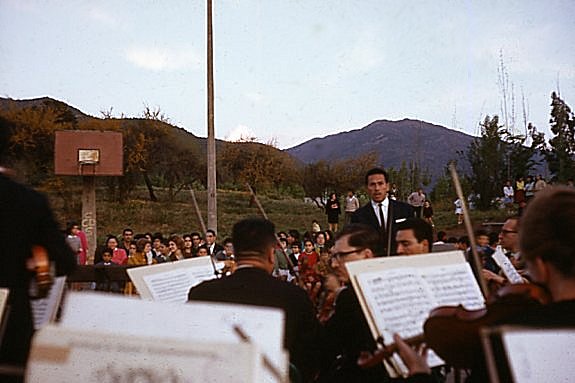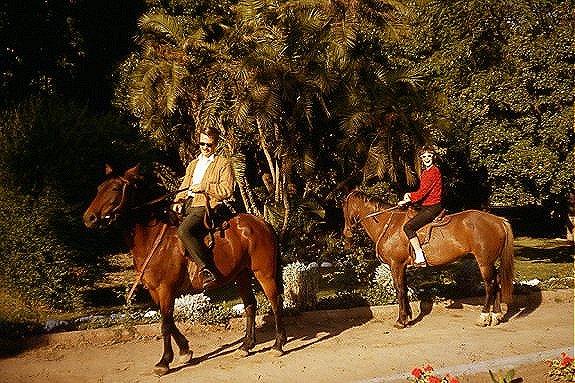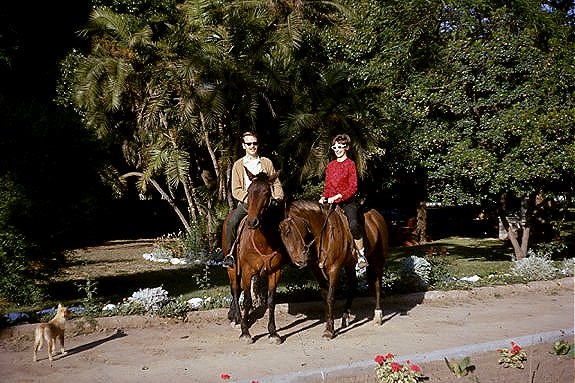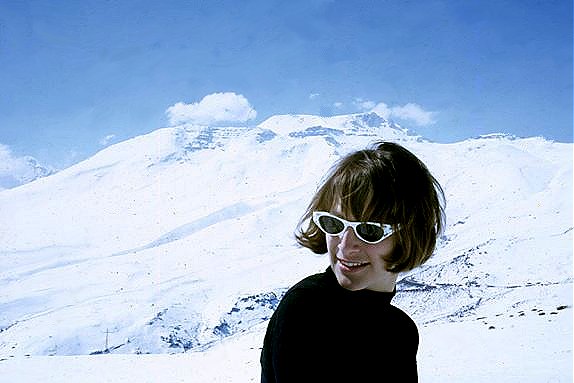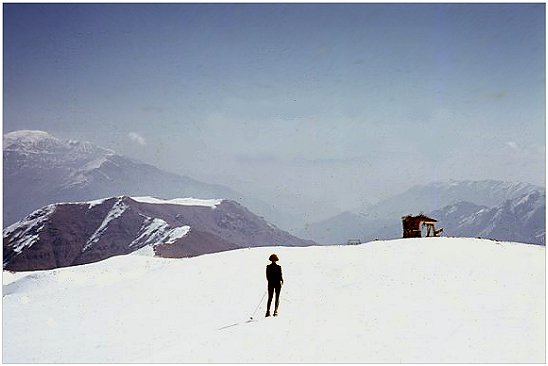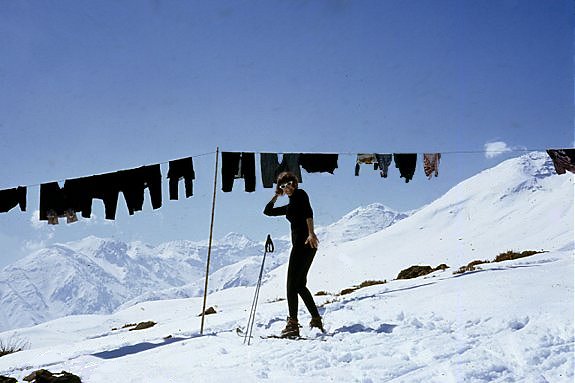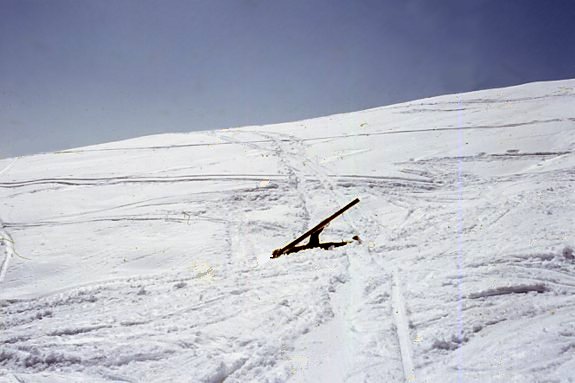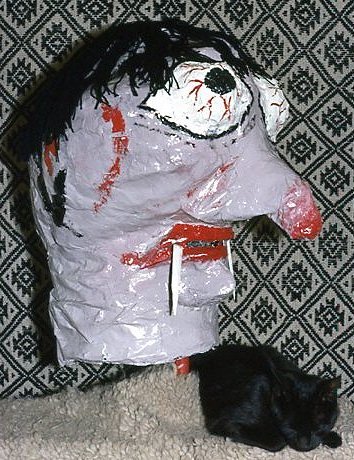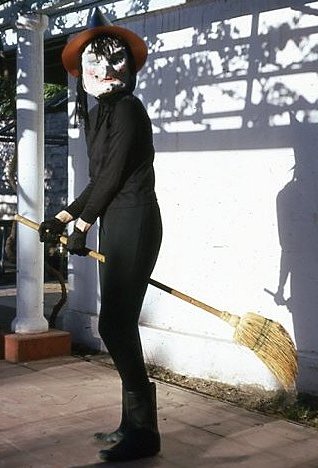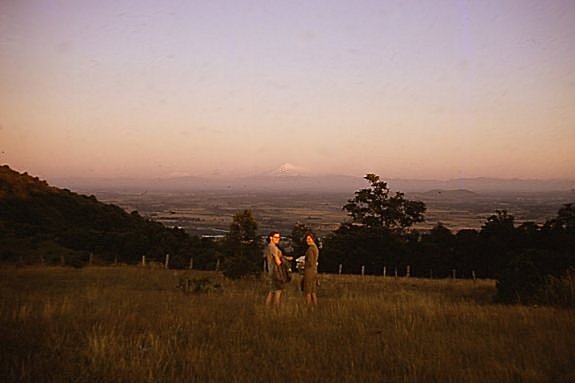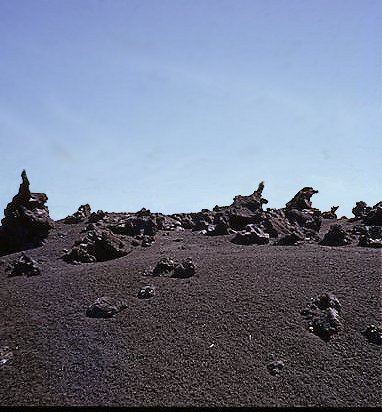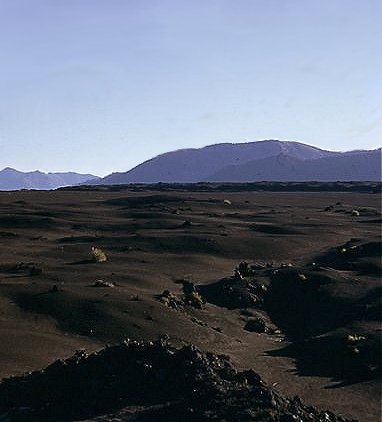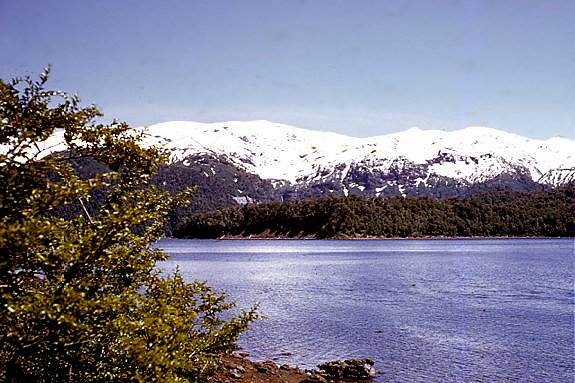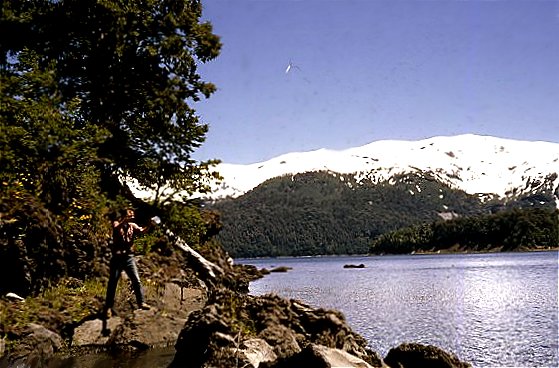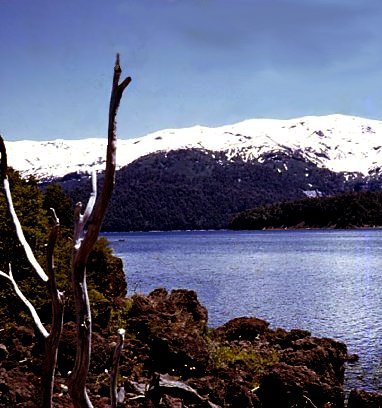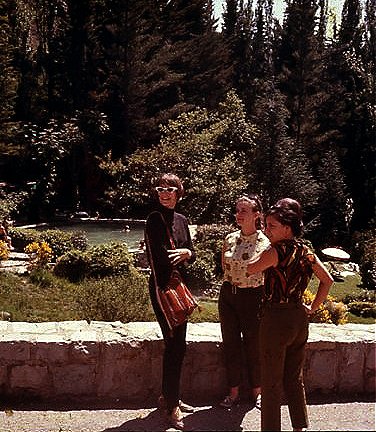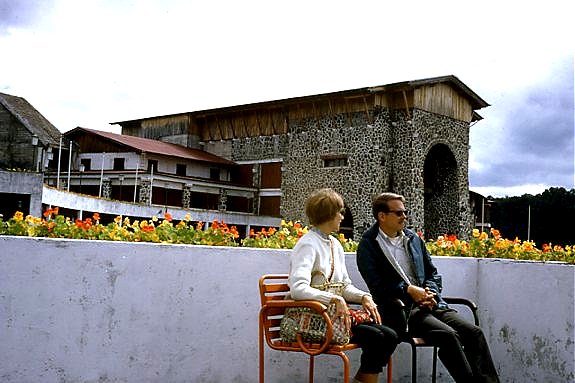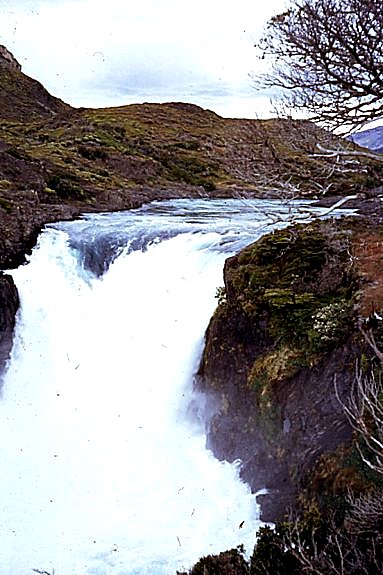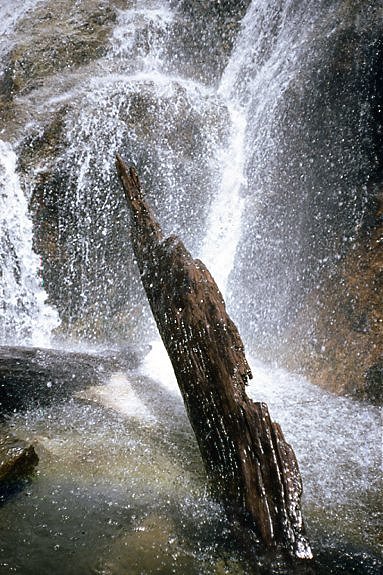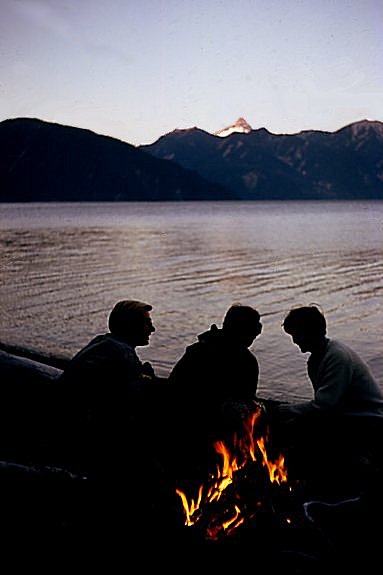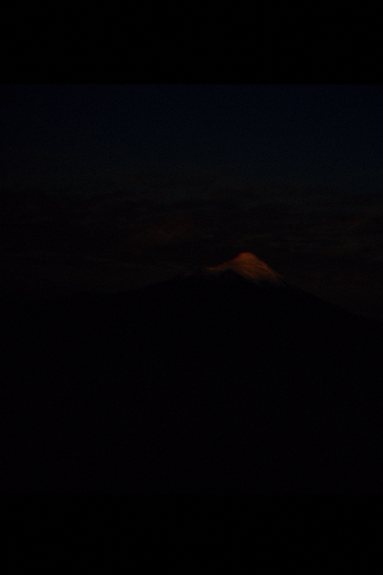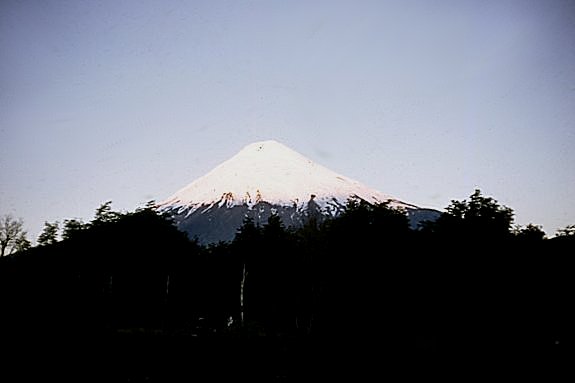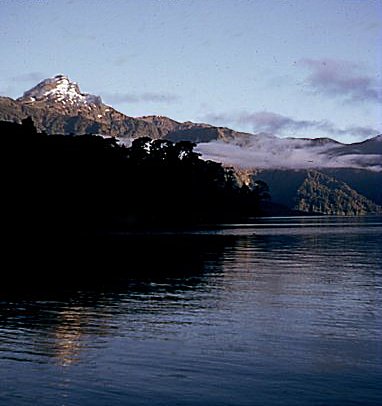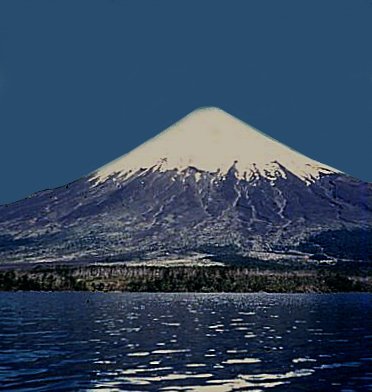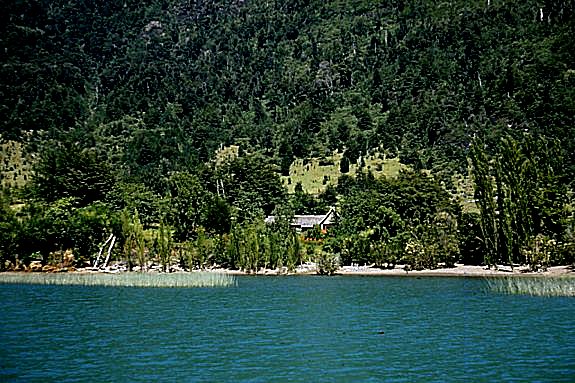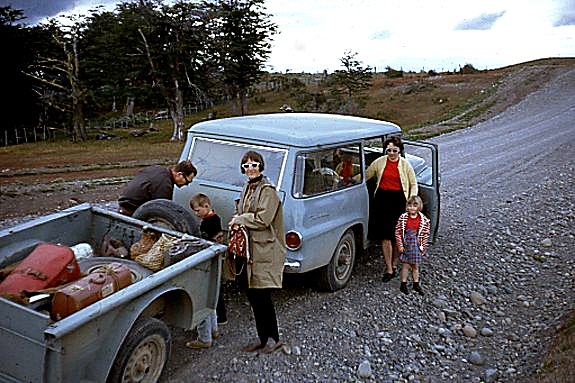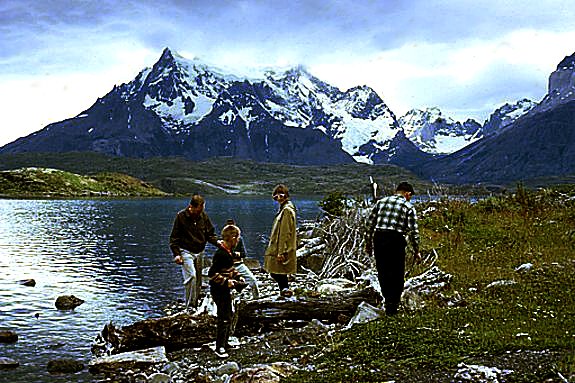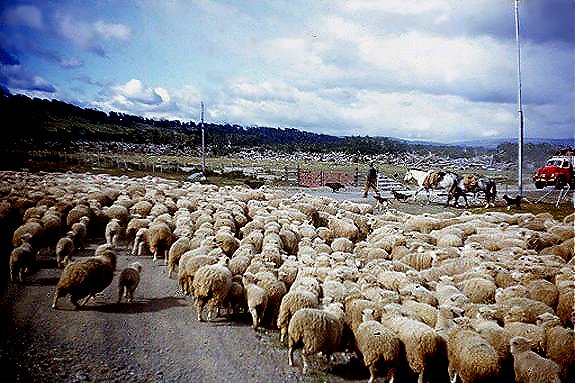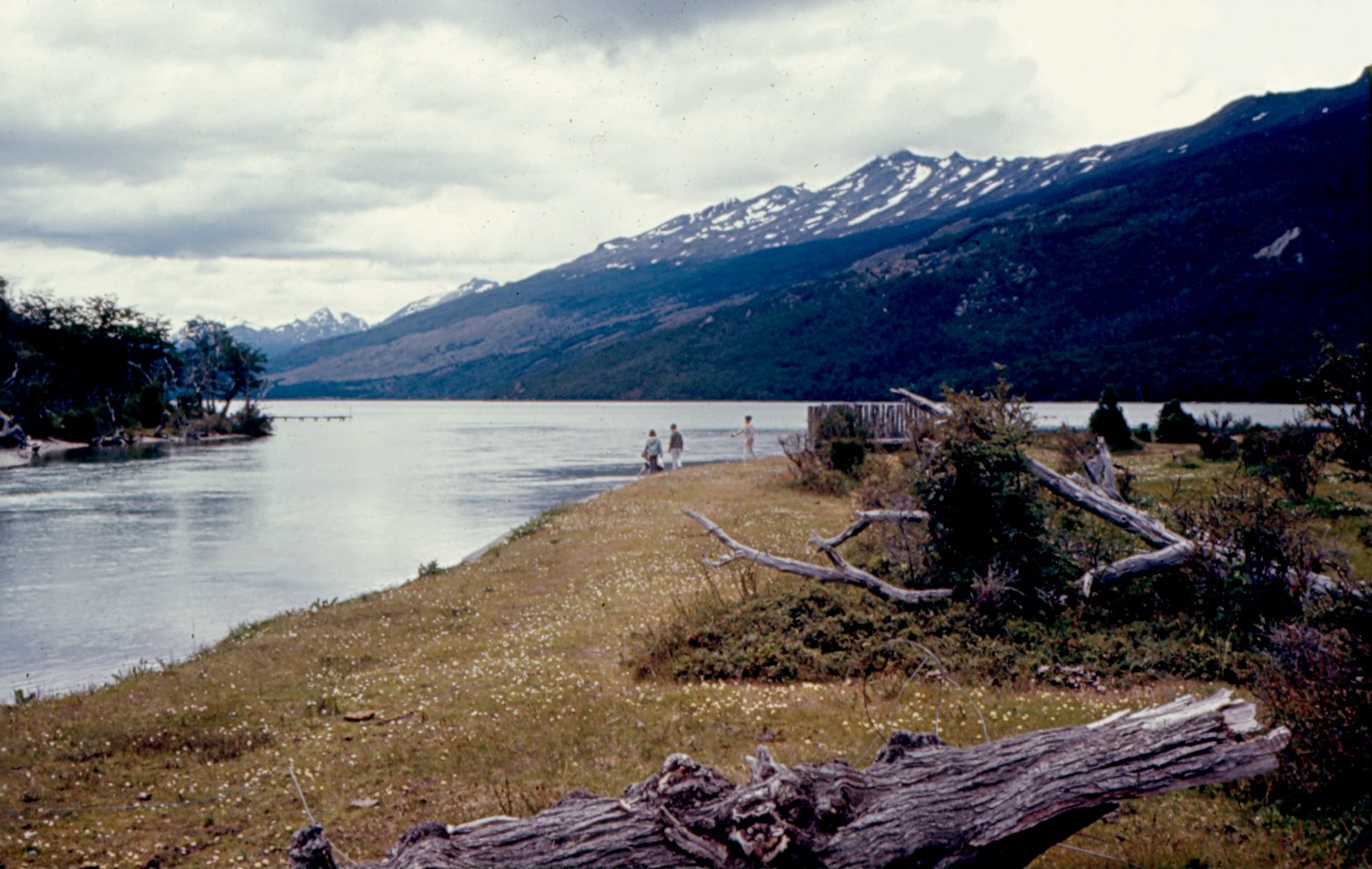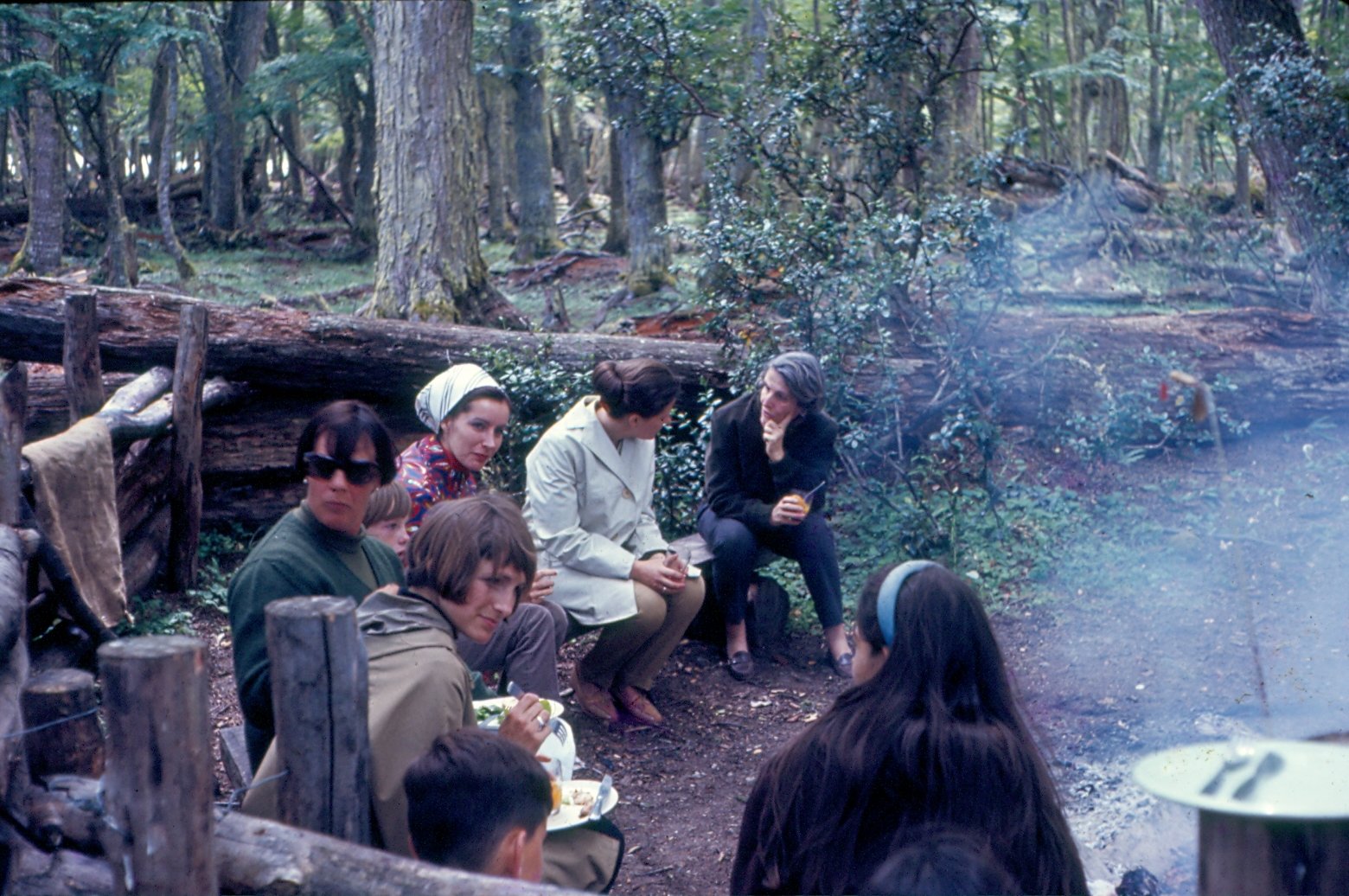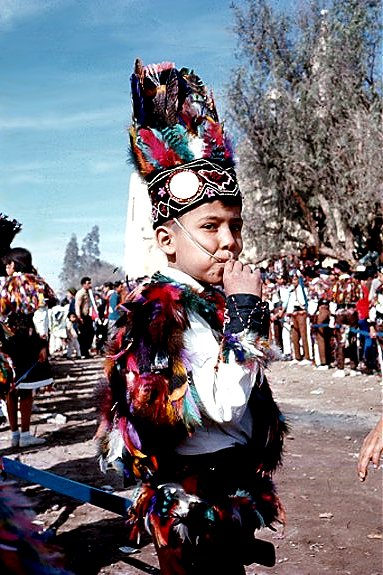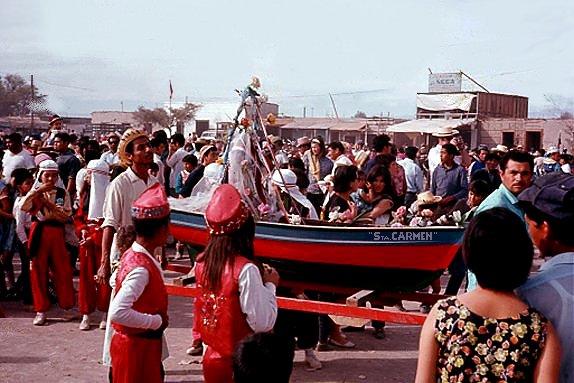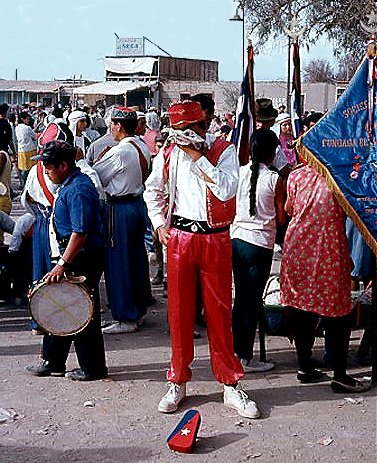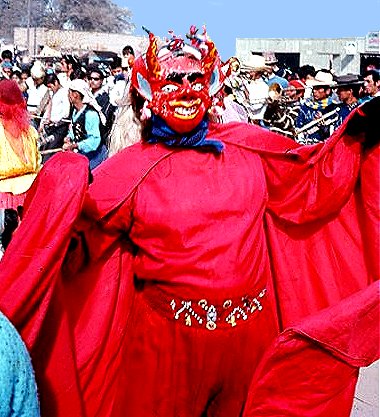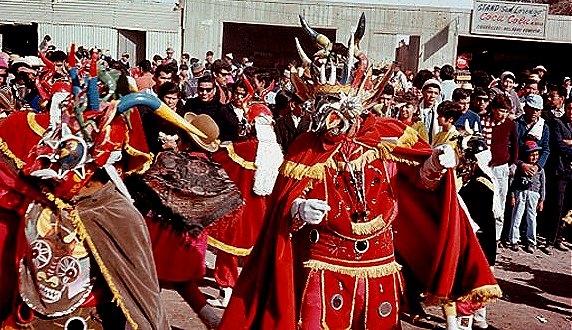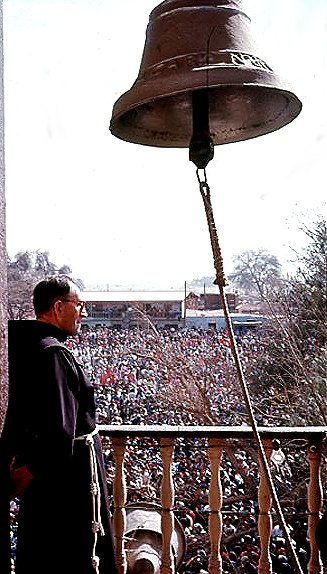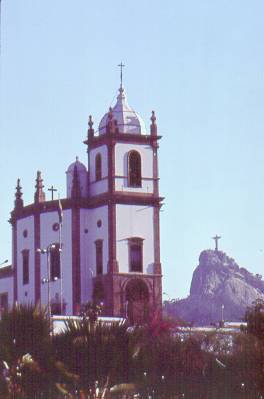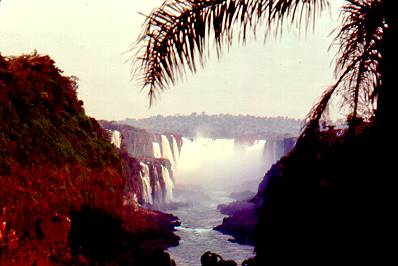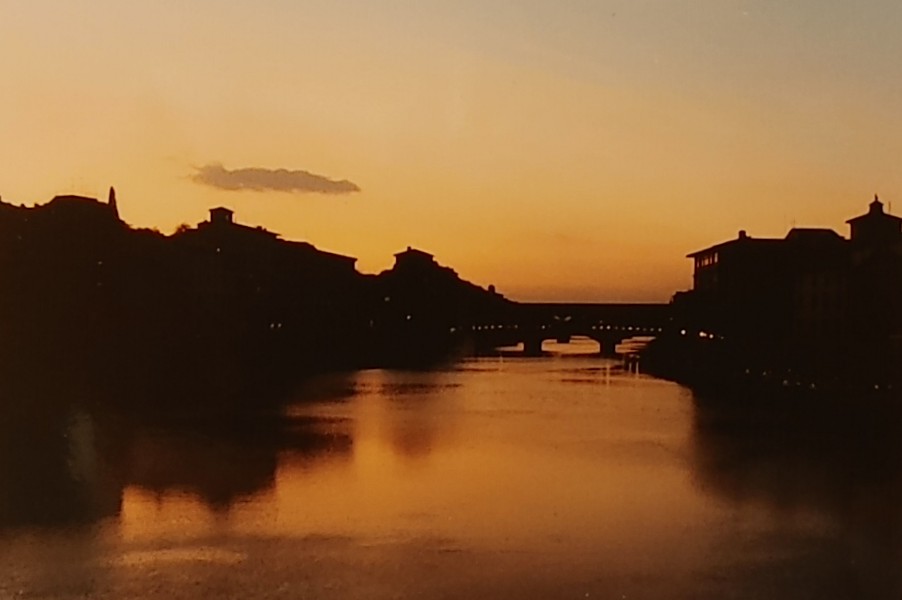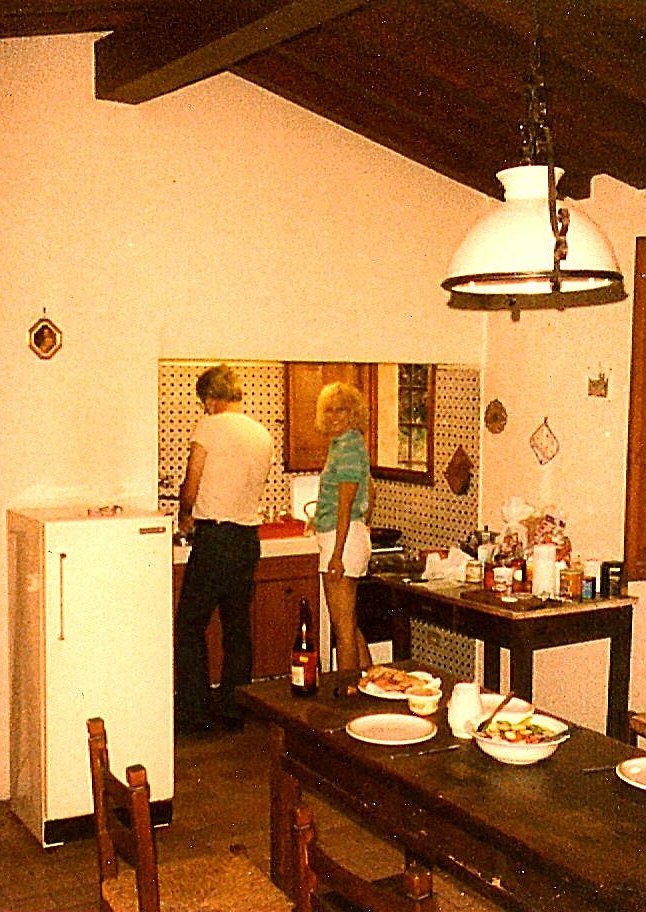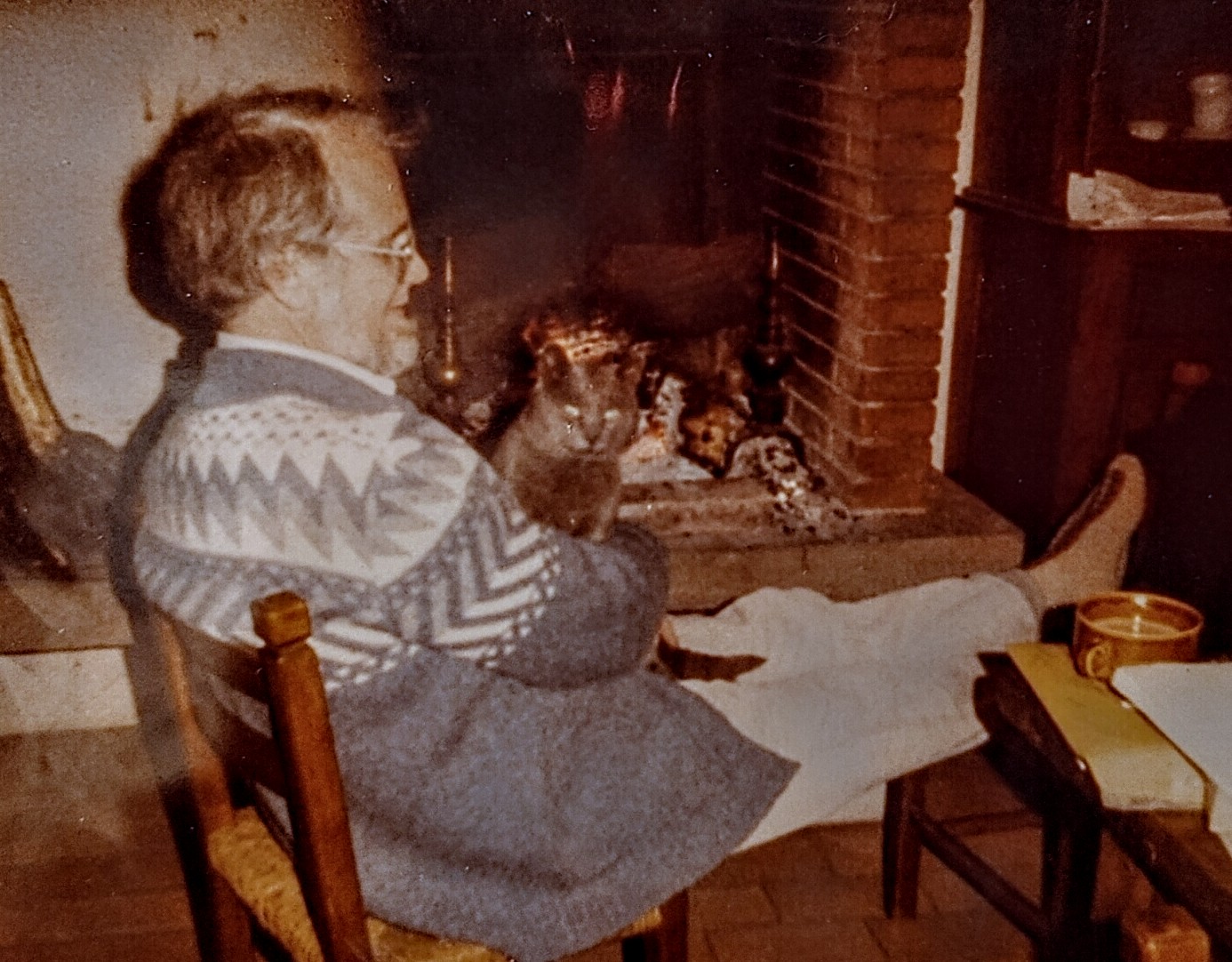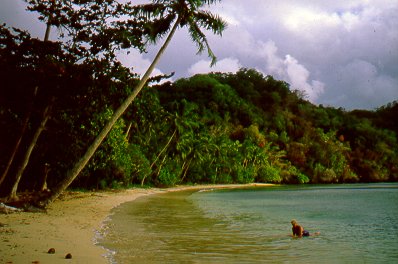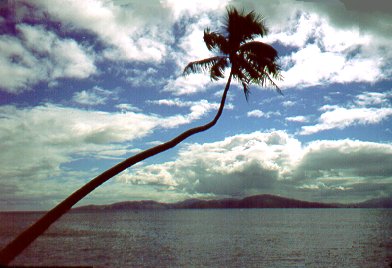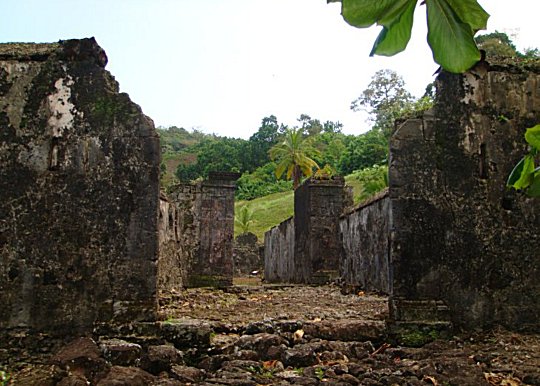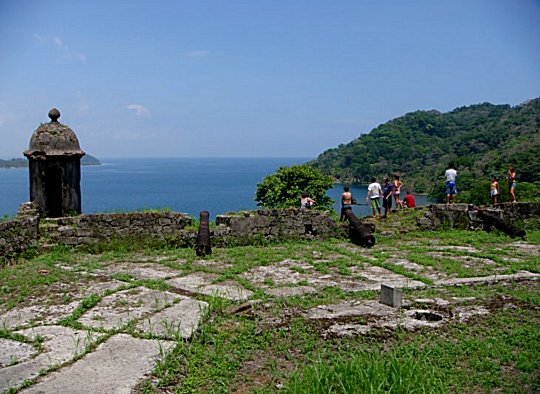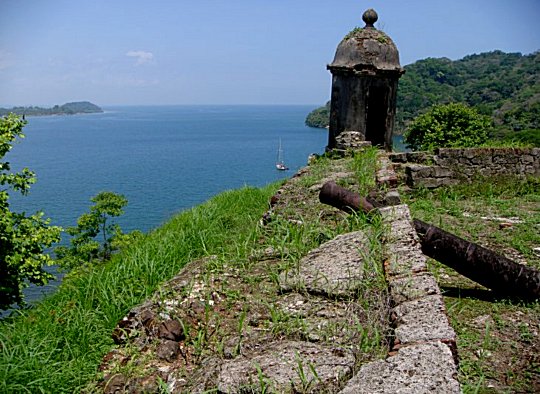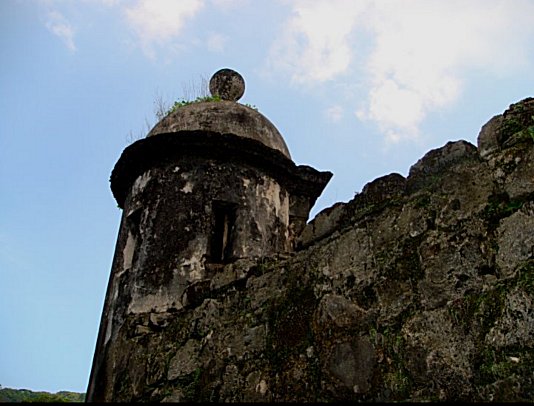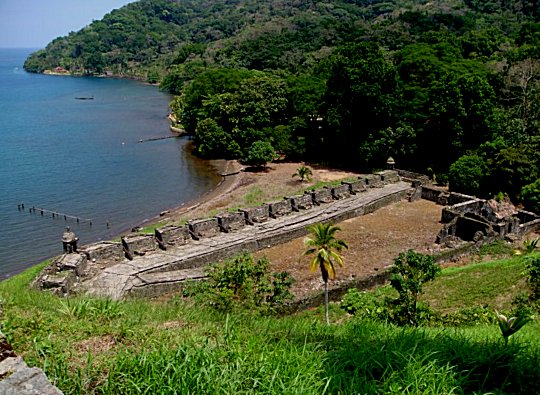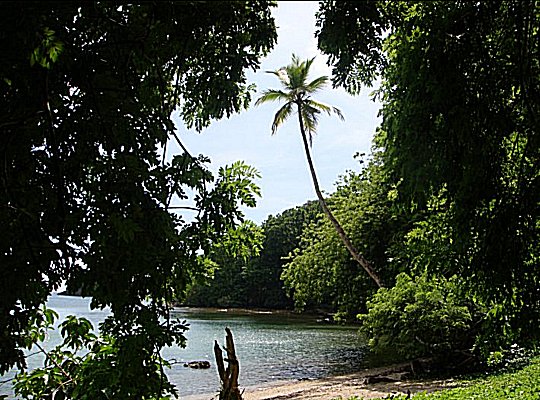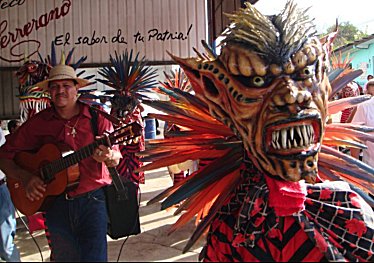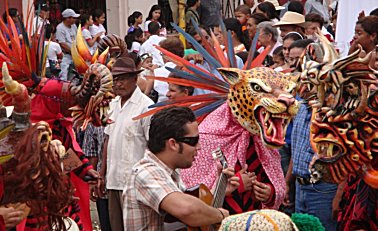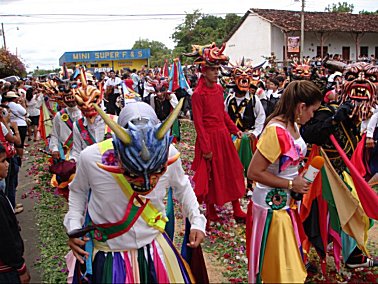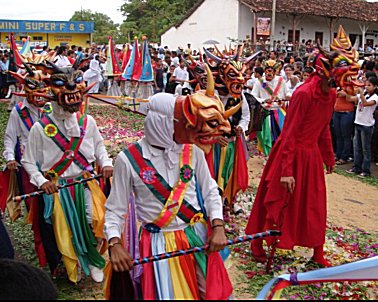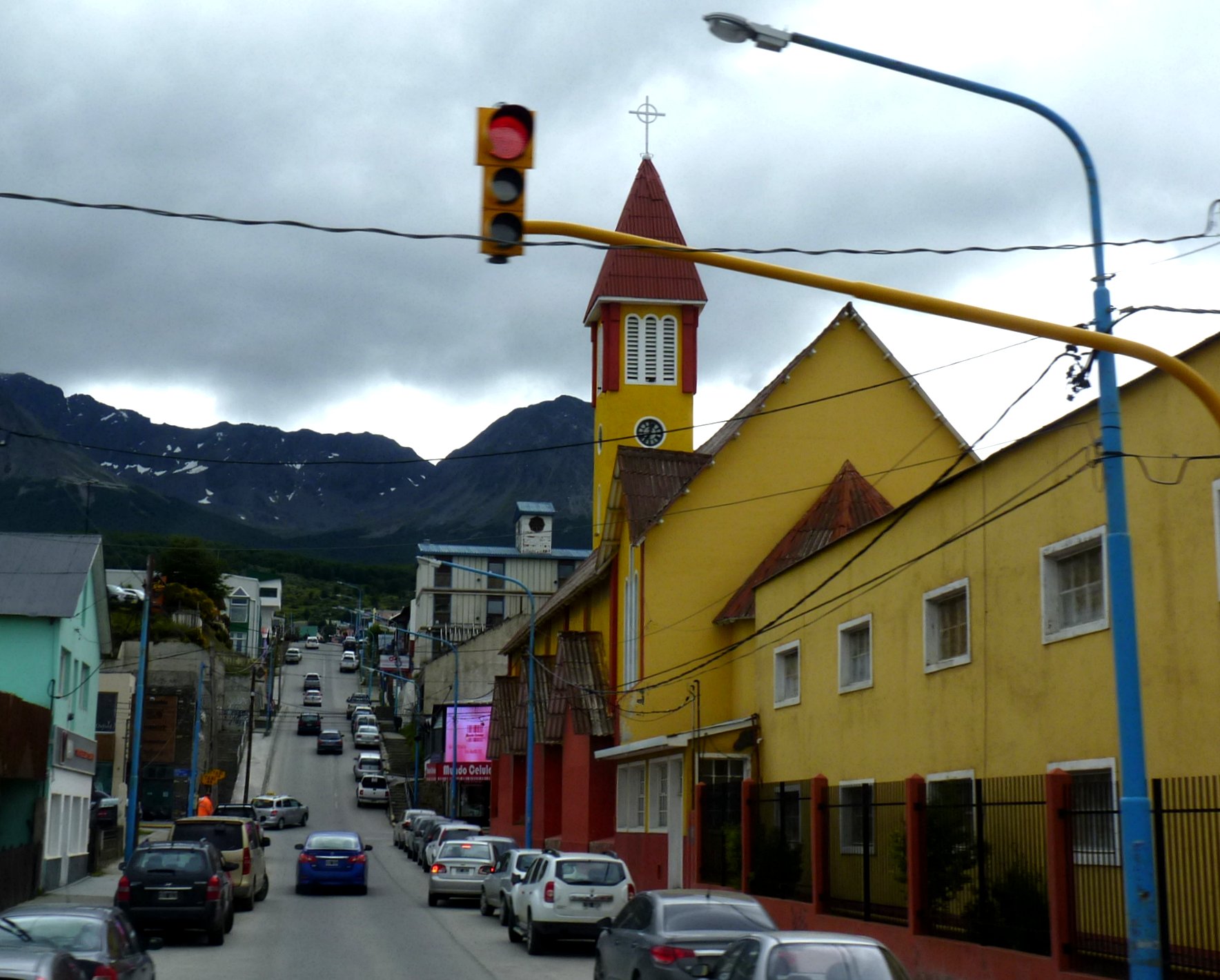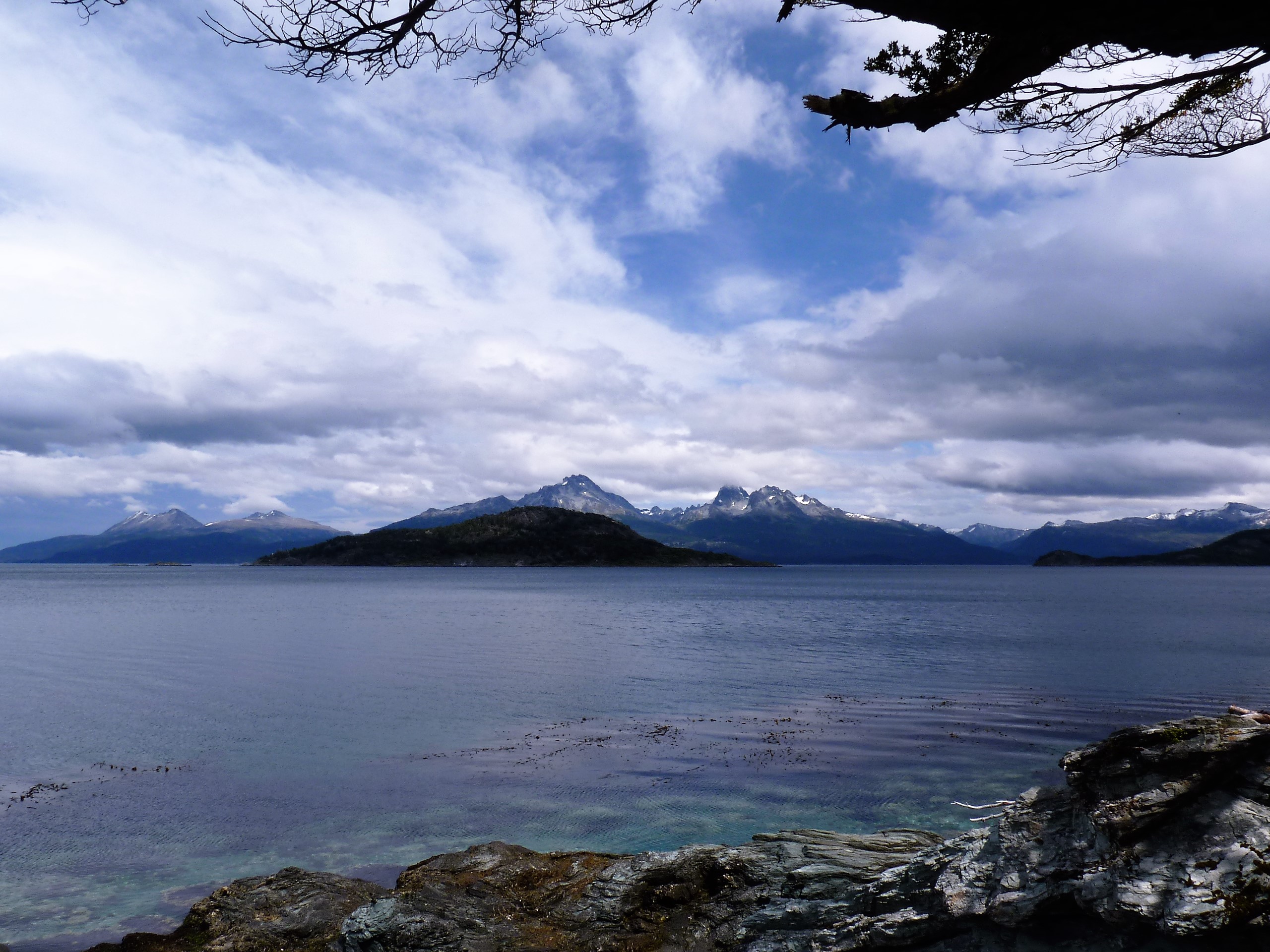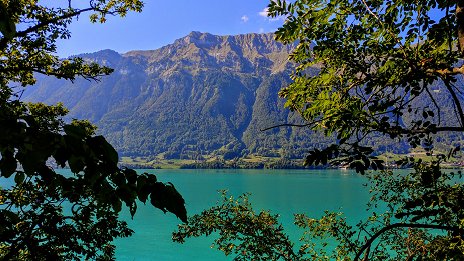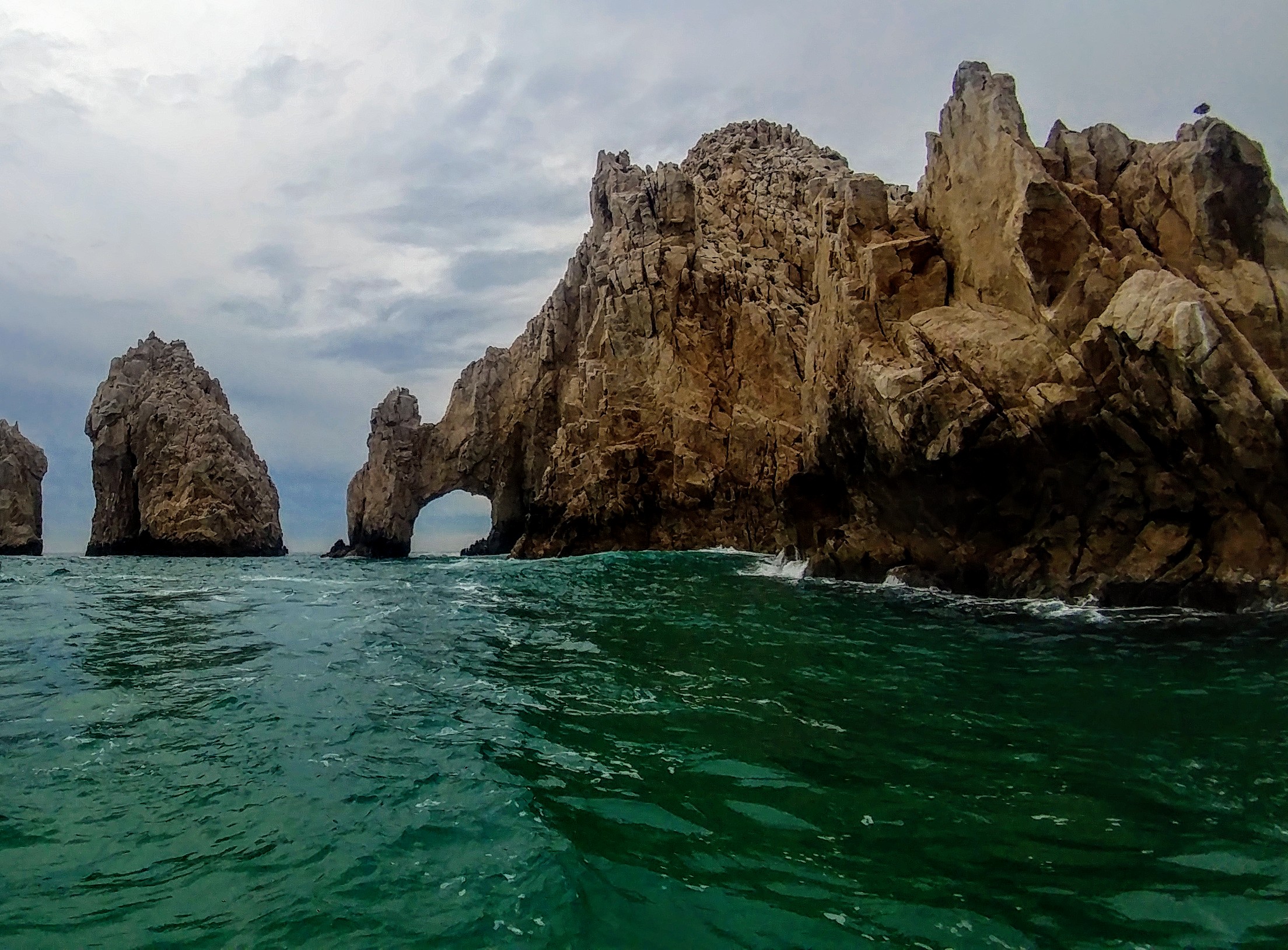Diane and I love to travel, especially to other countries. Ever since we were volunteers in the Peace Corps to Chile beginning in 1966, we have traveled to many places, including many countries and territories within the following regions: South America, the Caribbean, Central America, Mexico, Europe, East Asia, Southeast Asia, Polynesia, Middle East, and North America. In fact, we have been in over 70 countries.
We began our travels abroad in 1966 as Peace Corps Volunteers (PCVs) in Santiago, Chile, where we lived from August 1966 until December 1968. After leaving Chile and traveling for another four months, with many stops in Peru, Brazil, and Trinidad and Tobago, we finally arrived home to Minnesota in April, 1969. In the following pages, Diane and I write about our many Peace Corps Volunteer-related adventures from the late 1960s, or what I refer to as our formative years as grownups.
I (Dale) first began this section of my personal web page, which I title “Travel Tales and Snapshots,” in 2013 with small essays about and digital photographs from various cruises and other travels from that year to the present. These short stories are constantly being updated. Additionally, I am in the early stages of writing stories about earlier travels. Fortunately, in our current process of “down sizing” I came across some itineraries and other documents that help to refresh my memory, such as research field notes and letters written to our parents, which they saved. I begin by simply entering in the data from those sources, and later I try to turn them into interesting stories. These data trigger our memories, lead us to have many discussions about the past, and inspire me to write “travel tales.” I also have taken thousands of photographs, mostly slides and digital pictures, and many of them are included in these pages as “travel snapshots.”
Travels in 1966-1968
Puerto Rico: Peace Corps Volunteer (PCV) Language Training
June – August, 1966.
Diane and I were accepted into Peace Corps Volunteer (PVC) training in the spring of 1966. We were married on June 1965, a year after Diane graduated with BA and BS degrees in English and Spanish at the University of Minnesota, and soon after I finished my MA degree in music (Musicology and Flute Performance) at the University of Minnesota. Therefore, our Peace Corps training period was almost like a second honeymoon. We spent our first months of training at the University of Washington where we had a wonderful time at the beautiful “U-dub” campus in the Lake Washington area of greater Seattle. We visited the Cascade Mountains, saw Mount Rainier every day, visited Seattle’s highlights, cruised on Puget Sound, crossed over to Victoria, Canada, and had many other new experiences for us, including receiving about every vaccination and shot that existed at that time.
After completing our initial training in Washington state, we went for several weeks to Puerto Rico for advanced language training. There we had to find our own housing near the University of Puerto Rico (UPR) in Rio Piedras, and we soon found room and board with a wonderful family, which enabled us to improve our Spajjnish speaking skills. Being at the University of Puerto Rico gave us an opportunity to meet and interact with Spanish-speaking faculty members, which was important because our program in the Peace Corps was University Education and were all going to be teachers in Chile.
test
Insert letter from Diane, August 19, 1966
Insert letter by dale to parent on 9-11-66
Insert letter by Diane Sept. 7, 1966 “Yesterday I met the lady here …”
Insert same letter beginning “Dale has a nice set-up at the Conservatory of Music…”
Diane and I took several excursions with fellow Peace Corps trainees and occasionally UPR faculty members, visiting El Yugue rainforest, Luquillo Beach, and Old San Juan. Walking the streets of Rio Piedras was memorable, because we would hear coquis (tiny frogs) but could never see them; we have never forgotten their loud calls — “koKEE, koKEE.”
After several months we flew back home to Minnesota, then to New York City for our long flight to Chile. We finally arrived in Santiago as bonafide PCVs.
Santiago, Chile (and beyond): Peace Corps Volunteers
June 1966 – December 1968
Diane and I lived in Santiago, Chile, where we worked as Peace Corp Volunteers in group “Chile 19, University Education,” from early September 1966 through mid December 1968. Before our arrival to Santiago on September 15, we knew the city and name of the university where we would teach, but we did not know exactly what we would teach beyond our general discipline — “music” for me at the University of Chile and “English” for Diane at the Catholic University .
Background information about Dale’s musical experiences in Santiago
Dale’s Original Peace Corps Assignment — Recorder Instructor, University of Chile
I was assigned to the University of Chile, Facultad de Artes y Ciencias Musicales, which is a very fancy title meaning “Department of Musical Arts and Sciences,” or simply “Performance and Musicology.” This sounded good to me, but there were no details provided, and the University was on strike. A few days after our arrival to Santiago, I met with my Chilean host, Dr. Domingo Santa Cruz, the Music Dean of the University of Chile and Chile’s most famous composer. He told me I would be teaching recorder (flauta dulce in Spanish) to individual children after their regular school hours. The program in the University of Chile was called “Extension Musical,” — and it was basically musical instruction for children after school during the late afternoons and/or evenings. This sounded terrible to me! First of all, I wanted to teach during the day so Diane and I could have similar schedules. Secondly, I didn’t want to teach children who probably didn’t want to be in night school anyway. Thirdly, I did not know how to play recorder! Nevertheless, this was my official assignment, so I purchased an inexpensive soprano recorder in a Santiago music shop and in a week I became an expert because of my flute background. In a few weeks when school began, my second fear became true — my small handful of adolescent recorder students did not want to be there, did not practice, and often did not show up for their lessons.
Dale’s Self-Assigned Peace Corps Assignment — Principal Flutist, Philharmonic Orchestra of Chile
An Unorthodox Audition
During those first few weeks in Santiago I became good friends with Juan Bravo, the University’s flute professor and principal flutist with the Chilean Symphony Orchestra (Orquesta Sinfónica de Chile). He said “Dale, there’s an opening in the Philharmonic Orchestra of Chile (Orquesta Filarmónica de Chile) for principal flute. Auditions are next Wednesday, November 23 (1966), and you should go try out.” I did not realize that Santiago has two professional symphony orchestras, the “Symphonic Orchestra” and the “Philharmonic Orchestra,” funded respectively by the University of Chile and the municipal government of Santiago.
I was overjoyed with this opportunity to audition and possibly play principal flute in a professional orchestra. This was my life’s dream as a young flutist. For the next few days I practiced everything in my several music books of flute orchestral excerpts. Wednesday morning I left early to appear at 9:00 at the beautiful Municipal Theater in downtown Santiago. When I 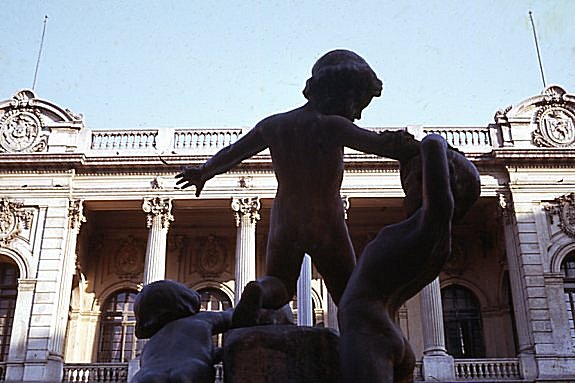 arrived, however, the front door into the ornate foyer was open but nobody was around. I took our my flute and began playing several of the orchestral excerpts I had memorized — I was enjoying the wonderful acoustics in the foyer, and I suspected that my flute music was resounding throughout the concert hall. I was not aware of the orchestra slowly arriving onstage to begin its rehearsal. Suddenly, a bearded man in a suit and tie entered the foyer and said to me in Spanish [my translations follow], “Who are you? What are you doing here? You’re making a lot of noise and we are about to begin our orchestra rehearsal!” I replied, “I’m here for the audition for the principal flute position!” He responded, “The auditions were yesterday! But, can you start tomorrow?” Here I was, auditioning without knowing it, and getting my dream job, but not realizing it. The fact of the matter was, as I found out later, that none of the Chilean flutists that auditioned yesterday was good enough to be hired. My calendrical error was a godsend for me, not only because I was hired on the spot, but also because a primary rule of the Peace Corps is that Volunteers are not allowed to take jobs away from citizens of the host country. I explained who I was, and that I would be honored to become a member of the orchestra. I also explained that as a Peace Corps Volunteer, I could not accept a salary. However, we worked out an arrangement whereby the Orchestra gave me a stipend to pay for our housing and public transportation expenses. It was a deal that made both of us very happy.
arrived, however, the front door into the ornate foyer was open but nobody was around. I took our my flute and began playing several of the orchestral excerpts I had memorized — I was enjoying the wonderful acoustics in the foyer, and I suspected that my flute music was resounding throughout the concert hall. I was not aware of the orchestra slowly arriving onstage to begin its rehearsal. Suddenly, a bearded man in a suit and tie entered the foyer and said to me in Spanish [my translations follow], “Who are you? What are you doing here? You’re making a lot of noise and we are about to begin our orchestra rehearsal!” I replied, “I’m here for the audition for the principal flute position!” He responded, “The auditions were yesterday! But, can you start tomorrow?” Here I was, auditioning without knowing it, and getting my dream job, but not realizing it. The fact of the matter was, as I found out later, that none of the Chilean flutists that auditioned yesterday was good enough to be hired. My calendrical error was a godsend for me, not only because I was hired on the spot, but also because a primary rule of the Peace Corps is that Volunteers are not allowed to take jobs away from citizens of the host country. I explained who I was, and that I would be honored to become a member of the orchestra. I also explained that as a Peace Corps Volunteer, I could not accept a salary. However, we worked out an arrangement whereby the Orchestra gave me a stipend to pay for our housing and public transportation expenses. It was a deal that made both of us very happy.
(Letter by Dale to our parents, November 22, 1966). “I have some exciting news: you probably remember that we explained in an earlier letter that Santiago supports two symphony orchestras — the Sinfonia and the Filarmónica. Well, I am now the first flutist with the Philharmonic Orchestra of Chile. Both orchestras are about the same level — not as good as Minneapolis symphony, but very good, both doing major works. I will have rehearsals every morning from 10:00 to 12:00 except Sunday, and two or more concerts each week. This week, for example, we play a concert Thursday evening, and also play for a ballet production Saturday evening. Additionally, the first hornest, clarinetist, of bassoonest of my orchestra and the first oboist of the Sinfonia have asked me to play in a woodwind quintet with them. So, it sounds like I’ll get a lot of playing experience. Also, this will give me a certain amount of prestige so I won’t be a Santiago nobody who is trying to teach in the conservatory at the University of Chile. I mention this only because it’s important in Santiago, especially within the University of Chile, to have a title in order to have the respect of the students.”
Philharmonic Orchestra Concert Venues
I was hired after the end of the 1966 official concert season, so many of my first concerts were not in the beautiful Teatro Municipal, but rather in other Santiago venues. My very first concert, for example, was in the Club de Union during the evening of November 25, the North American Thanksgiving holiday. Diane wrote the following description of the venue and the concert in a letter to her parents on December 1, 1966: “Man, what a place! The Club de Union is a private club on the Main Avenue (Alameda) in Santiago, and it is quite exclusive, full of tapestry rugs, huge furniture in the several small rooms, chandeliers, statues, huge paintings in golden frames, mirrors, etc. In the very center room, the main salon, the orchestra performed its concert. The building has four floors, including balconies overlooking the main salon. I was quietly sitting one balcony above, looking down upon the orchestra, pretending this was my house, and the concert had been arranged for my sister (who is playing a piano concerto). I thought it was an old mansion and I was trying to imagine what it was like. But then, I got talking to the manager (who found me on the third floor looking down, and told me that the third floor was for men only). He explained that the building was constructed 14 years ago as a club, not a house at all. So I continued listening, quite normally again, to the concert. The musicians all played very well, especially Dale, in my prejudiced opinion. He has a good sound, and blends well. All solo parts he had sounded beautiful, especially in the Debussy piece.”
“The second concert Dale played in was in the Municipal Theater, where most of his concerts will be. This is another beautiful building, with tiered balconies held up by angels, a domed ceiling with a picture on it, a big chandelier, red plush seats, and white and gold trimmings.”
Dale’s Philharmonic Orchestral Repertoires and Schedules
When I joined the Philharmonic Orchestra of Chile, I didn’t have a very good idea of its repertoire or conductors. Diane actually learned some information about that before I did, as I wrote in a letter to our parents in Minnesota: “Di let me in on some news today concerning the Orquesta Filarmónica (my orchestra); it happened she saw a tentative schedule of events, which I had no idea of, and apparently we (the orchestra) will be giving a Brahms festival and a Beethoven festival. We will have several guest conductors including several famous ones from Europe and Latin America. We will be performing La Bohème and four other operas in the spring. It all sounds very interesting, fun, and beneficial for me.”
Diane wrote a letter to her family in Saint Paul, Minnesota, on April 28, 1967, in which she mentioned some meaningful observations about my first seasonal performance with the Philharmonic Orchestra of Chile. Here is an excerpt from Diane’s letter: “Last night was Dale’s official debut with the orchestra in its 1967 season. It was a very good concert, and I find the orchestra surprisingly good (after often hearing it’s the second-best orchestra in this two-symphony-orchestra-city).  Anyway, a person could sit back and enjoy it. Dale played very well, and he told me afterwards that several people, including orchestra members, the president of the orchestra, and also the conductor, had congratulated him and complimented him on his beautiful sound. He had a nice solo in the last movement of the Fourth Symphony by Brahms. I was sitting as far away as you can get, in the fourth balcony [see the very top of this photograph],and it came through great! By the way, I was a bit disillusioned about the beautiful Municipal Theater he plays in after sitting in the 4th balcony — there are no chairs, only step-like things to sit on. Talk about physical discomfort!”
Anyway, a person could sit back and enjoy it. Dale played very well, and he told me afterwards that several people, including orchestra members, the president of the orchestra, and also the conductor, had congratulated him and complimented him on his beautiful sound. He had a nice solo in the last movement of the Fourth Symphony by Brahms. I was sitting as far away as you can get, in the fourth balcony [see the very top of this photograph],and it came through great! By the way, I was a bit disillusioned about the beautiful Municipal Theater he plays in after sitting in the 4th balcony — there are no chairs, only step-like things to sit on. Talk about physical discomfort!”
I (Dale) wrote a letter to my musical colleague and best-man for our wedding, Leland Tolo, on December 1, 1967, in which detailed some or the orchestra’s activities and my experiences. Here is an excerpt from that letter: “Right now the orchestra is in the middle of what is called the spring season, or the summer season — I don’t know when one ends and the other begins. It includes a few outdoor concerts, trips to other parts of Chile near Santiago, and concerts in the Municipal Theater. Last week we played some concerts including Mendelssohn’s Midsummer Night’s Dream and Tchaikovsky’s Fifth Symphony. My flute solo in the scherzo of the Mendelssohn brought bravos from the orchestra members during rehearsal when I played it (I was lucky). This week we’ll be playing Borodin’s Prince Igor and Stravinsky’s Firebird Suite. I can tell now that it’s going to be very difficult to leave in another year, because i enjoy playing so much, and the other members are really great friends. A lot of the members have asked me if we’re going to stay in Chile after the Peace Corps, and Thursday the president of the orchestra asked me to stay for a few more years.” I held the position for two seasons, until the end of our Peace Corps tour in December 1968.
Some Memorable Performances with the Philharmonic Orchestra
Diane wrote the following in a letter home, May 12, 1968: “Last night Dale played for a performance of the ballet Swan Lake by Tschaikovsky, presented by the National Ballet Company of Finland. I went to the Municipal Theater and sat for a while in the orchestra pit behind the basses, but I could not see well. During intermission, an usher found me a third-row seat way over to the side — part of the stage was behind a pillar, but at least I could see the dancers feet. It was a good performance.
“Then yesterday afternoon, I went to the Saturday concert of the Philharmonic Orchestra — an Austrian guest pianist played the Brahms Piano Concerto No. 2. He is also giving a recital on Monday night and he just happens to be playing Ravel’s Ondine — the second movement of Gaspar de la Nuit. When I met him after the concert, I tried to talk him into playing the whole piece, but he said that he needed to do a lot of practicing, although he does know the whole composition. He is very nice man, and we (he, Dale, and I) all had ice cream together in one of the orchestral hangouts, a little restaurant about half a block from the theater. So I’ll have to go to that concert too.
“But as busy as I was with the concerts, Dale was of course three times as busy, starting out with a rehearsal in the morning, and then playing two performances. The past week has been full — extra rehearsals for the ballet. Tomorrow he starts at 10:00 a.m. but won’t get home until 1:00 a.m. — great time for supper! After the ballet last night, some friends of ours came backstage — then Friday night, I also went to another ballet, Romeo and Juliet. I really liked the performance. Now I think I’ve seen enough ballet, at least from the pit (the cheapest tickets cost 35 escudos).”
Dale’s Camaraderie with the Philharmonic Orchestra Members
I made many very special friends in the orchestra, with plenty of joking. 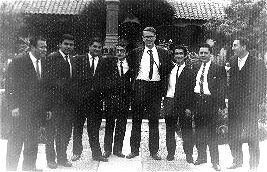 Many times during rehearsals and just before I had a flute solo in some piece, the principal bassoonist would yell “dale que dale!” (my name, of course, but the phrase in Spanish means “go for it!” or “give it all you got” — from the verb dar, “to give”). I started out being called “gringo,” but soon became “gringito,” a big distinction meaning “friend” rather than “foreigner.” We had particularly good times during our orchestral tours outside of Santiago. This photograph was taken in Vina del Mar, on Chile’s coast, in December (summer in Chile), 1967, with me (the tall gringito) in the middle of the picture with a number of the orchestra’s wind players. Our orchestral tours were usually at the end of the season, in the Chilean spring or early summer (November). The following photographs give an idea of the venues, which were often outdoors.
Many times during rehearsals and just before I had a flute solo in some piece, the principal bassoonist would yell “dale que dale!” (my name, of course, but the phrase in Spanish means “go for it!” or “give it all you got” — from the verb dar, “to give”). I started out being called “gringo,” but soon became “gringito,” a big distinction meaning “friend” rather than “foreigner.” We had particularly good times during our orchestral tours outside of Santiago. This photograph was taken in Vina del Mar, on Chile’s coast, in December (summer in Chile), 1967, with me (the tall gringito) in the middle of the picture with a number of the orchestra’s wind players. Our orchestral tours were usually at the end of the season, in the Chilean spring or early summer (November). The following photographs give an idea of the venues, which were often outdoors.
Near the end of my final season with the Philharmonic Orchestra, the wind players held a farewell party for me at a local restaurant one evening. They had rented a small banquet room in the restaurant, and I remember that several long tables were placed end-to-end, covered with white table cloths, nice dinnerware, and a bottle of wine lined up in the center of the tables, as if there was one bottle per person. I don’t remember counting, but everything made for a wonderful and memorable time. The highlight of the party was after the meal when the principal trumpet player climbed up on his chair and sang the “Star Bangled Banner” in perfect English as a tribute to me. That wonderful endeavor still brings tears to my eyes every time I think about it, especially about the friendships I made with all of the orchestra members during those two years.
“The Woodwind Quintet “Arión”
I also became a member of a woodwind quintet made up of the principal wind players in the orchestra. We named our ensemble El Quinteto Arión, and we presented concerts around Santiago, in salons, small concert halls, schools, and other venues. 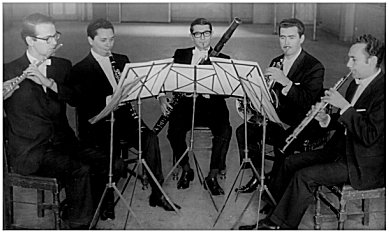 From left to right in this picture are Dale Olsen, flute; Sebastian Acuña, clarinet; Jorge Espinoza, bassoon; Jorge Maltrain, french horn; and Osvaldo Molina, oboe (principal oboist in the Orquesta Symphonica de Chile, i.e., the Chilean Symphony Orchestra).
From left to right in this picture are Dale Olsen, flute; Sebastian Acuña, clarinet; Jorge Espinoza, bassoon; Jorge Maltrain, french horn; and Osvaldo Molina, oboe (principal oboist in the Orquesta Symphonica de Chile, i.e., the Chilean Symphony Orchestra).
Ethnomusicologist with the Chilean Department of Popular Promotion
(Letter by Dale to Diane’s parents, 7.4.68) “Diane hasn’t told you about my new job (I have three jobs now), which used to be Peace Corps Anita’s job until she left Chile. I’m working with a Chilean governmental department called Departamento de Promocion Popular (Department of Popular Promotion), which has a several Chilean folklorists on its staff, working with rural Chilean folklore and music. These fellows, who are folklorists and not trained musicians, go into the remote areas of the Chilean countryside and record the folk music as sung and performed by old peasants (campesinos) in the hills. My job is to transcribe the music from their field recorded tapes into a guitar tablature musical notation. Then, some Chilean musician/teachers will teach those songs to Chilean children in the public schools. The purpose of this project is to save, preserve, and teach old traditional Chilean music so it will not become extinct. It’s great work for an ethnomusicologist, and it is my first contact with this type of folk music and my first experience transcribing it. I like the job very much — it’s challenging and ethnomusicologically very rewarding.”
Diane’s Original Peace Corps Assignment — Professor of English Language Literature, Catholic University of Chile
I (Diane) worked as a professor of English Language Literature at the Universidad Catolica de Chile (Catholic University of Chile), only several blocks from the Municipal Theater where Dale rehearsed and performed the Philharmonic Orchestra . My supervisor was Sister Cyria, a nun from Ohio. Dale and I became very good friends with her, giving flute/piano recitals for the students, going on countryside retreats with the nuns and other teachers, and being treated as colleagues. But it was teaching American literature that occupied most of my time.
Catholic University of Chile
(Excerpts from Diane’s letter to several college and church friends in Minnesota, November 5, 1967): School for me is drawing to a close — November 17 is the last day of classes. I’ve sure learned a lot and have enjoyed it. The students are just great — really friendly. In some of the other Chilean universities, the students have protested having Peace Corps Volunteers because they think we are spies. But the Catholic University here in Santiago is conservative in that respect (thank goodness). The Modern American Fiction course has gone pretty well — we’ve read several short stories. In the last unit we did titled individual, family, society, I got out of some work by assigning various students to teach the different stories. They did nice work! The last novel we are reading is To Kill a Mockingbird. The students are working on a term paper based on an American novel; I’ve been helping them individually with their outlines so they will write something readable.”
Daily Activities
(June 2, 1968, Diane’s letter home) “I am in a very bad mood tonight, so if it shows through the letter, just ignore it. My mood has to do with the fact that after many hours of work this weekend for one of my classes, they didn’t have the patience to wait 10 minutes, and left because I was late ( coming from another class (. This class has already missed a lot because of meetings, Welcome week, etc. I am tired of it, and will probably get mad at them when I see them wednesday. It may be a cross-cultural thing, each misunderstanding the other, but I don’t care. Sometimes Chileans seem to lack respect, but again, maybe that’s a North American interpretation — just to be fair.
“Last Wednesday was Phil Brink’s (Phil and Margaret Brink are new Peace Corps Volunteer musicians) trombone recital, with Dale and I playing a flute and piano piece in the middle of the concert. The Hootenanny group did some jazz and blues things for the second half. Afterwards we all came over here to eat something and rehearse after the performance. But Thursday we made a quick trip to Valparaiso to be on TV. The show was at 11:10 PM — we took a taxi back to Santiago afterwards, and got back about 2:00 AM. Dale couldn’t go along though, poor kid. He was planning to miss a couple concerts in the Philharmonic Orchestra’s Beethoven series, because there are only two flutes. However, the visiting conductor from Leipzig, East Germany, Herbert Kegel, who was also here last week, asked where the first flutist is, the American. So, the president of the orchestra contacted Dale, and he ended up playing Thursday night’s concert after all. This week we are supposed to rehearse at 10:30 PM Wednesday through Friday nights to prepare for a video-taped TV show. I’m not too excited about all these rehearsals, especially when I have so many papers to correct and lesson plans to work on. Sometimes I wish the days were a few hours longe; but, whenever I try to steal a few hours at night, I end up sleeping late the next morning. We have a French test Thursday, all oral! Oh well, at least we have our electric blankets.
We went to see up the down staircase, translated by the way is something something . . . ” END or CONTINUE WITH LETTER
House hunting in Santiago
Our First Housing Accommodations
When we arrived in Santiago on October 15, 1966, we were assigned to a downtown hotel for four days. We had to find more suitable housing on our own, although we were given suggestions for a temporary pensión or rooming house, which included breakfast. We found a comfortable place in downtown Santiago, where other volunteers were staying. Diane wrote the following in a letter home (October19,1966): “We have now moved out of the hotel into a pensión, which is like a boarding house with rooms for rent. Most of the people here are Peace Corps Volunteers — they joke about how the landlady is supported by Peace Corps because when volunteers come to Santiago, they almost always stay here. It is very cheap and comfortable for a temporary housing. It is an old house, with tall ceilings and doors. Compared to some of the other places we looked at, this is really nice and clean.”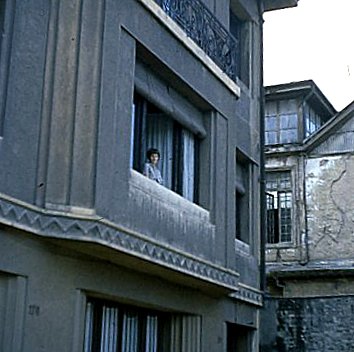
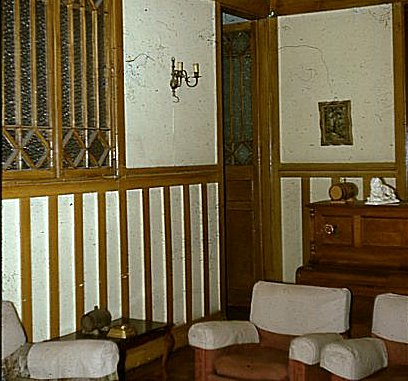
It was in that rooming house where I (Dale) practiced my newly-purchased soprano recorder, which perhaps somehow led to an invitation for three of us PCVs to have lunch with a gentleman who wanted to talk to several young Americans. We don’t remember any of the details of that invitation, but we do remember the lunch because of the food. Although it was very tasty, as newcomers to Chile we recalled all the warnings we had during training about what foods not to eat. One rule was not to eat anything raw, such as lettuce (everything should be cooked for at least 15 minutes). Well, the first course was a salad with tomatoes and fish (we don’t remember if it included lettuce. The main dish was chicken and rice — very tasty! We were particularly warned during our training not to eat fresh strawberries or whipped cream. Wouldn’t you know that our dessert included fresh strawberries with whipped cream! “We really lucked out this time,” the other PCV exclaimed. We decided that, to be polite, only one of us should claim to be allergic to strawberries, and only another could claim to be lactose intolerant and cannot eat dairy products. Of the three PCVs, I think I chose to eat them both. Thankfully, none of us became sick. We figured that the warning probably did not pertain to Santiago, a modern city (in some ways, at least).
Diane explained the pensión’s shower in this interesting excerpt from a letter home (October 19, 1966): “I should tell you about this crazy shower I tried to take. For some reason we thought we did not have hot water in the pensión, so we bought a hot plate and a kettle, thinking we were pretty smart. But that thinking didn’t last very long — we blew a fuse the first time, and only time, we used it. We could hear a lot of commotion around the place, and I don’t know how many rooms were affected. We decided not to try that again. Anyway, the landlady told us that there was a shower down the hall that we could use. Well, that was confusing! Never saw such a contraption before! We lit a strange-looking water heater above the tub, and then I turned on the shower. What a capricious thing! First, pure cold water comes out. Then pure hot water, but not in a steady stream — it kind of spurts. And then, just steam pours out. It was really too funny — I was laughing so hard. I didn’t try to wash my hair like I had planned. Instead, I just had it done the next day at a little shop on the corner, by two girls with three dryers. It was a nice job, too, and cost only about six escudos or $1.20.”
House Hunting
Letter from Diane to her parents, December 1, 1966. “For a few days at the beginning of the week I had a horrible headache and stayed in bed. I’m fine now, though. Part of it was the exhaustion of looking in earnest for a place to live, since we’ve told the rooming house owner that we are leaving by the 9th of December ?? October. Looking in earnest means getting up at 6:30 AM, buying a paper at 7:00, arriving at a place at 7:30 or 7:45, and getting the people out of bed. We are finally catching on to some Chileno tricks, though. When it says you can see the place at 10:00, you arrive at 9:00. And even if you are the first person it’s no guarantee that you will get the place. The landlords love the position of power they have. They seem to delight in half promising 20 people the same place. But our courage continues. We have a strong possibility going for us tomorrow, we will see. At least we don’t have other things to do like lesson plans, shopping, or cooking.”
Our House in Santiago
(Letter from Dale to Diane’s parents, December 4, 1966). “It’s Sunday the 4th of December today, and we have a home, finally! We got up at 6:30 this morning and walked to the Alameda (the main street in Santiago) where we waited for the newsstands to open. After waiting for a half an hour and still nothing opening (they usually open at 7:00), we took off walking for the main part of town where we saw a man reading today’s newspaper. I asked him where he got it, and he sold it to us. Very lucky, too, because we couldn’t find anything open (we figured out that this man must have been our guardian angel). 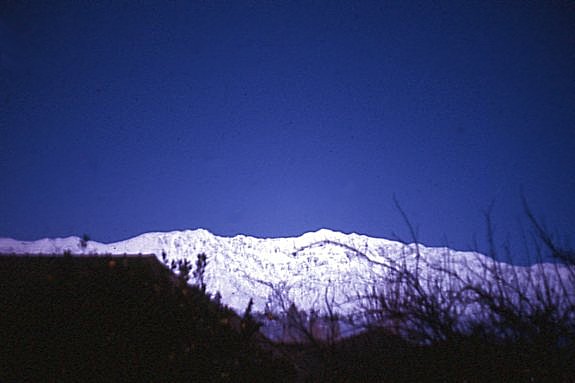 We came across an ad for an apartment quite a ways east, toward the mountains, for 200 escudos ($40). So we hopped on a bus and got there about 8:00, and what a beautiful area — trees and more trees, with the mountains very close and looming in the background, completely covered with snow (it rained in Santiago last night, and when it rains here it snows in the mountains). The apartment is a separate little house built originally for the maid; it is in the backyard patio of the main house,
We came across an ad for an apartment quite a ways east, toward the mountains, for 200 escudos ($40). So we hopped on a bus and got there about 8:00, and what a beautiful area — trees and more trees, with the mountains very close and looming in the background, completely covered with snow (it rained in Santiago last night, and when it rains here it snows in the mountains). The apartment is a separate little house built originally for the maid; it is in the backyard patio of the main house, 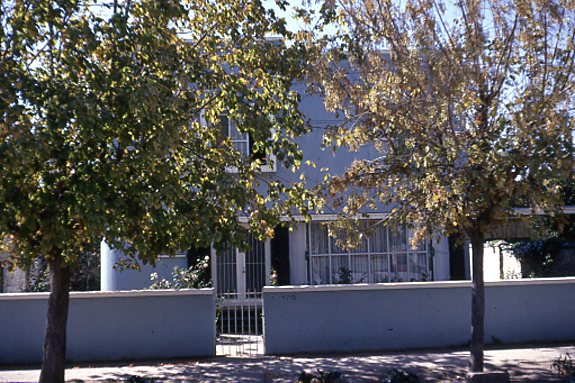 behind and looming over the garage. It is two stories with a kitchen (complete with a sink, stove, and pantry), a living/dining room, and closet downstairs; upstairs is a bedroom, a smaller room with many windows, a closet, and bathroom with hot water and shower.
behind and looming over the garage. It is two stories with a kitchen (complete with a sink, stove, and pantry), a living/dining room, and closet downstairs; upstairs is a bedroom, a smaller room with many windows, a closet, and bathroom with hot water and shower.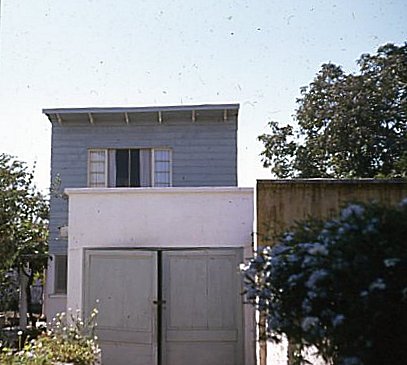
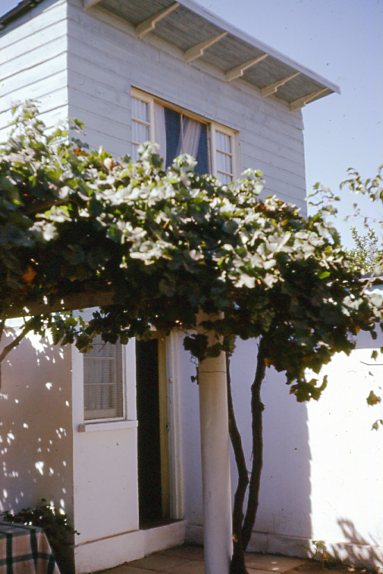 The bedroom has two big windows that give us a nice view of the Andes. It will take a little work to make it nicer. For example, we’re going to paint the inside a color we like, I’m going to build some shelves, we have to buy furniture, a bed, table, etc. We get $600 from the Peace Corps for this, and are saving $100 a month from what most other people are paying, so we can afford a few decent things.
The bedroom has two big windows that give us a nice view of the Andes. It will take a little work to make it nicer. For example, we’re going to paint the inside a color we like, I’m going to build some shelves, we have to buy furniture, a bed, table, etc. We get $600 from the Peace Corps for this, and are saving $100 a month from what most other people are paying, so we can afford a few decent things. 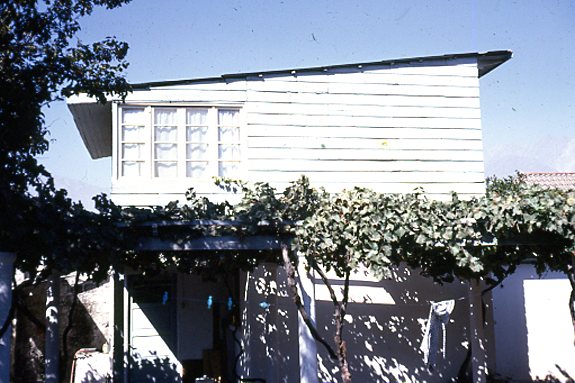
“The apartment is quite a distance from downtown, but only two blocks from a street where buses and vans run almost every 5 minutes (bus service is very good here because very few people have cars) and they go within two blocks from where we work. It is such a beautiful area that it is worth the trouble of taking a bus.
“Mr. and Mrs. Blummel, the landlords/owners that live in a big house, are nice. Mr. Blummel is of German descent (he rattled off some German to me, but I couldn’t understand that at all); their older son is a medical student. We got on the subject of Communism and the Peace Corps, and they said at once that Communism is bad and that they are Christian Democrats (their political party). 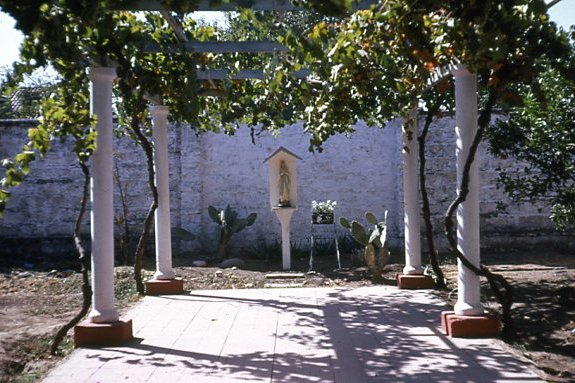
“Not over 15 minutes after we had arrived, a fellow came in to look at the apartment and wanted it, but too bad, fella! About 15 minutes after that, while we were talking, a lady came to see it. Santiago is swarming with people who want apartments, and it’s still hard to believe we got such a good one for so little money.”
Buying Furniture in Santiago
bla
Parties at our House
bla
Other Activities Pursued during “Free” Time
What I (Dale) mean by “free” time is just about anything not related to our professional work as Peace Corps Volunteers. These include looking for housing, fixing up our house, buying furniture, church activities, giving and going to parties, attending concerts other than those of the Philharmonic Orchestra, going to movies, eating out, exploring Santiago and adjacent areas, other weekend traveling within Chile, and more. Lengthy and pre-prepared travels, either within Chile (first year only) or in other countries (second year only) are called “vacations,” and they are discussed under separate headings. Many of our “free” time activities are discussed chronologically when it is convenient to do so.
Exploring Santiago and Environs
During the first several months of our approximate 27 months in Chile, we enjoyed riding local busses to the ends of their routes. Often we would end up somewhere on a western slope of the mountains, where we would just walk in the the prestine foothills of the Andes. Most often there were no fences, no houses, and no commercial buildings — just a bus stop.  Busses usually arrived and left their final, end-of-the-line bus stop every hour, and if we had the time, we would leisurely hike and enjoy the beauty of nature, as Diane is doing in this picture — she’s picking wild flowers. Sometimes we would just stay on the bus and go back to where we first got on.
Busses usually arrived and left their final, end-of-the-line bus stop every hour, and if we had the time, we would leisurely hike and enjoy the beauty of nature, as Diane is doing in this picture — she’s picking wild flowers. Sometimes we would just stay on the bus and go back to where we first got on.
On one particular weekend, Sister Cyria, Diane’s superviser at the Catholic University invited us to go with her for a day to their Catholic nunnary or farm located several miles out of Santiago in Chile’s central valley. There we enjoyed their beautiful flowers and landscaping, including lovely patches of Birds of Paradise and other exotic (to us) flowers. 

The highlight of that excursion with Sister Cyria, however, was the opportunity to ride several of their horses, which Diane especially enjoys. She is actually a very accomplished rider, and Dale, on the other hand, has never enjoyed the activity. Nevertheless, I (Dale) think we both look quite dashing on our nice Catholic horses.
Skiing at Farellones, Chile (September 15, 1967)
Farellones is a ski facility with a hotel about 35 miles east of Santiago. 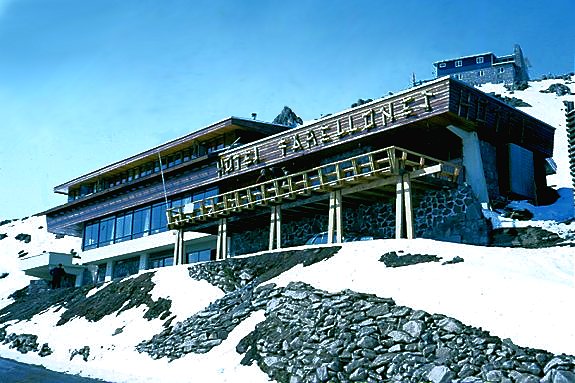 While it is close to the capital, compared to Portillo, for example, it is still in the rugged Andes, albeit at a middle elevation of the Andes mountains. It is a favorite weekend spot for many residents of Santiago because it is fairly close and easy to get to, it is cheaper than the famous Portillo ski resort near the Argentine border, and most of Farellones ski slopes are easy to manage for amateurs. Farellones skiing in September (springtime in Chile) is sweater skiing and the slopes were perfect for us because we had never really skied much before. Skiing in Minnesota was never enjoyable — it was always way too cold for humans, and there are only a few hills around the Twin Cities and they are always crowded. Therefore, we had fun in Farellones because it was like cross-country skiing without trees, with beautiful snow capped mountains in nearly every direction, and there were hardly any other skiers. We got a ride to the ski area with one of Diane’s students from the Catholic University.
While it is close to the capital, compared to Portillo, for example, it is still in the rugged Andes, albeit at a middle elevation of the Andes mountains. It is a favorite weekend spot for many residents of Santiago because it is fairly close and easy to get to, it is cheaper than the famous Portillo ski resort near the Argentine border, and most of Farellones ski slopes are easy to manage for amateurs. Farellones skiing in September (springtime in Chile) is sweater skiing and the slopes were perfect for us because we had never really skied much before. Skiing in Minnesota was never enjoyable — it was always way too cold for humans, and there are only a few hills around the Twin Cities and they are always crowded. Therefore, we had fun in Farellones because it was like cross-country skiing without trees, with beautiful snow capped mountains in nearly every direction, and there were hardly any other skiers. We got a ride to the ski area with one of Diane’s students from the Catholic University.  The following photographs are of us enjoying the snow and cross country skiing at this beautiful place in the Chilean Andes. Most of the time we would quietly glide along the gentle slopes, sometimes we would gently fall, and sometimes ham it up for a photograph — always with lots of smiles and laughter.
The following photographs are of us enjoying the snow and cross country skiing at this beautiful place in the Chilean Andes. Most of the time we would quietly glide along the gentle slopes, sometimes we would gently fall, and sometimes ham it up for a photograph — always with lots of smiles and laughter.
 Later, on weekend in the fall of 1968, we spent a beautiful half day in Farellones with our newly-made PCV musician friends, Phil and Margaret Brink, seen with us in this photograph. They arrived in Santiago in the fall 1967 and left in 1969. We performed many concerts together with them, especially in a folk group that several us PCVs formed in 1967.
Later, on weekend in the fall of 1968, we spent a beautiful half day in Farellones with our newly-made PCV musician friends, Phil and Margaret Brink, seen with us in this photograph. They arrived in Santiago in the fall 1967 and left in 1969. We performed many concerts together with them, especially in a folk group that several us PCVs formed in 1967.
Church Activities
Finding a church home in Santiago during our 30 months living in Santiago was important to us. Shortly after we became settled in our house, after weeks of search for a suitable place, we visited the Santiago Union Church, Santiago’s only English-speaking church in the 1960s. We became very close friends with Rev. Toby Legg and his wife, who was the organist at the church. Months after first attending, we were invited to be the coordinators of the church’s youth group, which we accepted. MORE
“Next Thursday (which is some kind of holiday here ( the Methodist church has asked us to play for some big deal- – it’s Methodist week or something like that. I’m sure glad that we brought our one and only Gospel song book. I’ve been playing that crazy harmonium for the church on Sunday mornings, by the way.” (May 18, 1968 letter)
Peace Corps Volunteer “Hootenanny” Folksong Group
Our particular Chilean Peace Corps group, known as “Chile 19, University Education,” included a number of very fine amateur as well as professional musicians. I was the only professional symphonic and jazz musician in our Santiago contingent, but there were several other talented Peace Corps Volunteers in Santiago pertaining to other groups who were singers, guitarists, and banjo players, and one talented actor. In early 1967 many of these artists, including Diane, joined together and formed what they called the “Peace Corps Hootenanny” group, specializing in North American folksong performance. 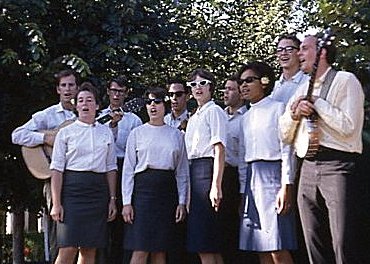
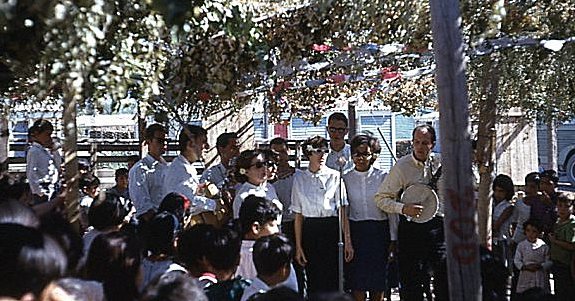 These first two photos show the group in an outdoor performance in Santiago — Diane can be seen in the front row wearing white-rimmed dark glasses. Diane wrote the following interesting paragraph about a particular performance (April 28, 1967, letter home): “Last Saturday night our Hootenanny group took to the road again. This time we went a little south to the town of San Bernardo. One of our group lives in a población (“shanty town”) there, and made arrangements for our group to perform. There was quite a big crowd in attendance, but I think they were attracted mainly by the boxing matches which “sandwiched” us. Boxing isn’t a major sport here, and the boxers weren’t very good. It was a cold night, and the event took place outside. I can imagine the boxers were a little “chilly” (pun intended) in their boxing trunks. We’ve sung on some interesting stages, but this was something else — climbing up to the high stage and then having to crawl through the ropes of the boxing ring! The crowd sure enjoyed that!
These first two photos show the group in an outdoor performance in Santiago — Diane can be seen in the front row wearing white-rimmed dark glasses. Diane wrote the following interesting paragraph about a particular performance (April 28, 1967, letter home): “Last Saturday night our Hootenanny group took to the road again. This time we went a little south to the town of San Bernardo. One of our group lives in a población (“shanty town”) there, and made arrangements for our group to perform. There was quite a big crowd in attendance, but I think they were attracted mainly by the boxing matches which “sandwiched” us. Boxing isn’t a major sport here, and the boxers weren’t very good. It was a cold night, and the event took place outside. I can imagine the boxers were a little “chilly” (pun intended) in their boxing trunks. We’ve sung on some interesting stages, but this was something else — climbing up to the high stage and then having to crawl through the ropes of the boxing ring! The crowd sure enjoyed that!
I joined the group as a singer and jazz flutist during its second year. For two years the PCV Hootenanny Group performed for Peace Corp and Santiago events, and during the second year we also appeared many times on Chilean television, as seen in this black and white photo taken in the television studio. INSERT PHOTO HERE.
Diane wrote the following about one of our performances (letter from May 18, 1968): “Well, the big news is that we are TV stars now. Last Saturday was the first big television performance of our Hootenanny group. It was an interview type show with a big, rather obnoxious master of ceremonies. The show is made up of miscellaneous acts, and we were one of them. Between our songs, the Master of Ceremonies interviewed us, asking us what kinds of jobs we have here in Chile, why we are here, how the wages compare, etc. We sang three songs, including the one we do with Dale playing jazz flute.
“Considering the type of program it was, it is surprising how many people happened to see us. The next day for example, I went to a morning concert, and a lady said she saw me on TV; and at school the kids all commented about it.
“Then, Wednesday night we were on television again, in a different type program entirely, with better organization and planning. They aired pictures of New York during our music, with narration by Bruce, an African American Peace Corps Volunteer, who read a Spanish poem about New York by Garcia Lorca (he actually had it memorized — he’s in a drama group), and us. We sang only two numbers, and the rest were solos or other combinations. Dale, Pete (a guitarist), and Anita (a very good folk singer) performed Summertime by George gershwin, and it was very professional. We enjoyed the camera work and techniques of the TV crew, and it was really great to be a part of the show. The next day, however, we hardly talked to anyone that had seen it. One of the Peace Corps leaders forgot about it, and the other big wigs didn’t know about it. Even sister Cyria missed it, although she very much wanted to see us — she had to stay late at school. So, after doing such a good job (at least we were pleased), very few friends even saw us. Those who did, however, really liked it. Some Peace Corps Volunteer colleagues ran around looking for television sets that were turned on, but couldn’t find any.
“Next Friday, our Hootenany group has been invited to sing in Temuco, which is a 15-hour bus ride south of Santiago. Dale has a concert or rehearsal the next Saturday morning at 10:00 a.m., but the PC big chief, Paul Bell, said Peace Corps would pay for his flight back — thus, he may be able to go. Dale really adds class to the group.
Our first Snowfall in Santiago
Excerpts from Dale’s letter to Louis Paff, a college friend, June 7, 1967. “Cold weather is settling in. On June 5, about 6:30 in the morning, our landlords pounded on our door to wake us up. They were all excited about something. It had snowed here in Santiago overnight. They said that such a momentous event last occurred 20 years ago (i.e., 1947). The Chilenos just loved it. Schools were closed in the morning, although the snow only lasted until about 10:00 AM, if that long. Compared to our strong and hearty Minnesota snowfalls, this was nothing. However, it sure looked odd to see snow on the palm trees, and the Andes mountains to our east are now completely snow covered and so majestic. The snow in Santiago soon became very slushy, however, but the day is perfectly clear and sunny. The snowfall seemed to clean the air and remove the smog.”
Halloween Party In Santiago, October 31-November 1, 1967
Excerpts from Diane’s letter to her family, Nov. 6, 1967. “Last Sunday was completely shot. After church we went to Fernando (the 2nd flutist in the Philharmonic Orchestra) and Liliana’s house for lunch, and after that we went to a flower show at the United Nations building here in Santiago. Then we had to go home and get dressed for the Halloween party sponsored by the Santiago Union Church, organized by and for the church’s youth group, which we direct. Both Dale and I made elaborate masks out of paper mache (papier-mâché) — Dale made a huge monster head and I made a witch’s face mask and a hat (seen below in the following four pictures).
“The Blummels (our landlords) got a big kick out of all our work (we spent about two or three nights making our costumes), and they even helped with the finishing touches of paint. Dale’s head is purple, with big bulging bloodshot eyes. We hung them in our bedroom after we finished making them.
“The fun really began when we got dressed up for the party. Fernando transported us to the vicinity of Paul Bell’s house (Mr. Bell is the Peace Corps director in Chile, and a member of the Union Church), and we had to get out of the car and get “headed” up for our entrance, since Dale’s monster head wouldn’t fit in Fernando’s little car (in this photo Diane is helping Dale adjust his big monster head).  Because we did not want to arrive together, Dale took a quick jog around the block, followed by curious children (Chileans don’t dress up for Halloween). I took a different route and had my following, too. We both looked awful, meaning scary. The street kids called me la bruja fea (“the ugly witch”), of all things! When we got to Bell’s house, I must admit that we both felt a little disappointed because the young people of our youth group hardly did anything to disguise themselves. We fooled them for a while, but, by the process of elimination, we were identified. Paul Bell has a little son about 6 or 7, and it was so cute because he would walk up to Dale and offer his hand, just to be sure Dale was at least a friendly monster. And he was very much in awe of me. I’m sure he was disappointed when I took off my mask, however, because he certainly believed that he had a real witch in his back yard!
Because we did not want to arrive together, Dale took a quick jog around the block, followed by curious children (Chileans don’t dress up for Halloween). I took a different route and had my following, too. We both looked awful, meaning scary. The street kids called me la bruja fea (“the ugly witch”), of all things! When we got to Bell’s house, I must admit that we both felt a little disappointed because the young people of our youth group hardly did anything to disguise themselves. We fooled them for a while, but, by the process of elimination, we were identified. Paul Bell has a little son about 6 or 7, and it was so cute because he would walk up to Dale and offer his hand, just to be sure Dale was at least a friendly monster. And he was very much in awe of me. I’m sure he was disappointed when I took off my mask, however, because he certainly believed that he had a real witch in his back yard!
“During the party there were the traditional Halloween games and barbequed hamburgers. The kids from the youth group did all there own planning — some things went over well, and others not so well. I presume they learned something anyway. The youth ended by playing Charades and singing folksongs.”
A Scary Event in Santiago, December 1, 1967
Excerpts from Dale’s letter to Leland Tolo, a college friend: “Diane and I have been keeping busy, and so far have managed to survive the earthquakes, uprisings, fiestas, and even the riot on Thanksgiving day when five or so people were killed here in Santiago. The trouble was caused by a communist-inspired strike or stop during which many of the city’s workers walked off their jobs, including bus workers, city utility (gas, water, and electricity) workers, and people from about 25 other agencies and companies. Fortunately, we were out of town on a concert tour with the Chilean Philharmonic Orchestra. When coming back on the orchestra bus late at night, we saw army and police in many parts of Santiago with rifles, tanks, etc. I guess they had to use tear gas in a few areas of town to disperse the rioters. Unfortunately, there were deaths, including the death of an innocent 8 year old boy who was accidently shot.”
Travels Outside Santiago during the First Year of our Peace Corp Tenure
During our vacation times from our Peace Corps jobs, Diane and I traveled throughout much of Chile from its far north in the Atacama Desert to Puerto Mont in south/central Chile. We also visited Buenos Aires in northern Argentina, Ushuaia in the extreme south on the Beagle Canal, took a train across the pampas from Buenos Aires to Mendoza, hitchhiked across the Andes from Mendoza to Santiago, skied in Farellones and Portillo, and much more. Some of these trips out of Santiago and daily experiences in the city are written about below, as letters, field notes, diaries, or remembrances. They are presented here in chronological order, because during our first year, PCVs were not allowed to travel out of the host country — In fact, our US passports were safely stored in the Peace Corps office in Santiago.
Vacation to the Chilean Lake District: (1) Temuco, Llaima Volcano, Lake Conguillío in the La Araucanía Region, and (2) Osorno Volcano, Lake Llanquehue and Lake Todos los Santos (January 20-30, 1967)
This was our first extended trip in Chile, which lasted ten days. The following is an excerpt from Dale’s letter to his parents written on January 23, 1967: “We’ve been taking our time (by train and hitchhiking) from Santiago to the central/south of Chile known as the lake district, seeing some of the most beautiful scenery we’ve ever seen. Arriving in Temuco, we visited a Peace Corps Volunteer (PCV) couple at their small cabin that they built themselves on an isolated hill with a perfect view of Mount Llaima, an active volcano. They work with the Chilean Mapuche Indians. From their house we drove north on a farm road with them, another PCV couple who work in forestry, and a Chilean couple, agrarian specialists who drove their vehicle. Soon the farm road ended and we continued driving on narrow winding path on a black lava field created by the large volcano. Before too long we reached Lago Verde from where the path continued into forests of Araucanian pines, bamboo groves, and moss-covered trees, with the snow capped Andes mountains ahead of us. We finally arrived at Lago Conguillío, our destination, and what a beautiful sight it was, with its crystal clear water, backdrop of snow capped mountains, and green forests — completely unexploited by tourism. There we fished, hiked, and ate our picnic lunch.”
Today, this beautiful area is known as Conguillío National Park, which includes ski-tows and ski-runs up and down the snow-capped Llaima Volcano. We were so fortunate to see it in a truly pristine state.
Our next destination was the town of Puerto Varas and Lake Llanquihue, followed by the Petrohue River, Osorno Volcano, and Lake Todo los Santos.
Vacation to Portillo and Christ of the Andes (April 15, 1967)
I wrote the following letter to our parents on April 5, 1967, explaining a little about our plans for a short vacation before our work schedules started: “This weekend we’re going to take a few more days of our vacation: we’re going to take a bus to Portillo and Christ of the Andes. The reason for this trip is because the son of our family, a third year medical student (a Christian Democrat) is going to have an all night party in the main house (we live in a small apartment behind the garage) with 70 of his medical student friends (most of them Communists). 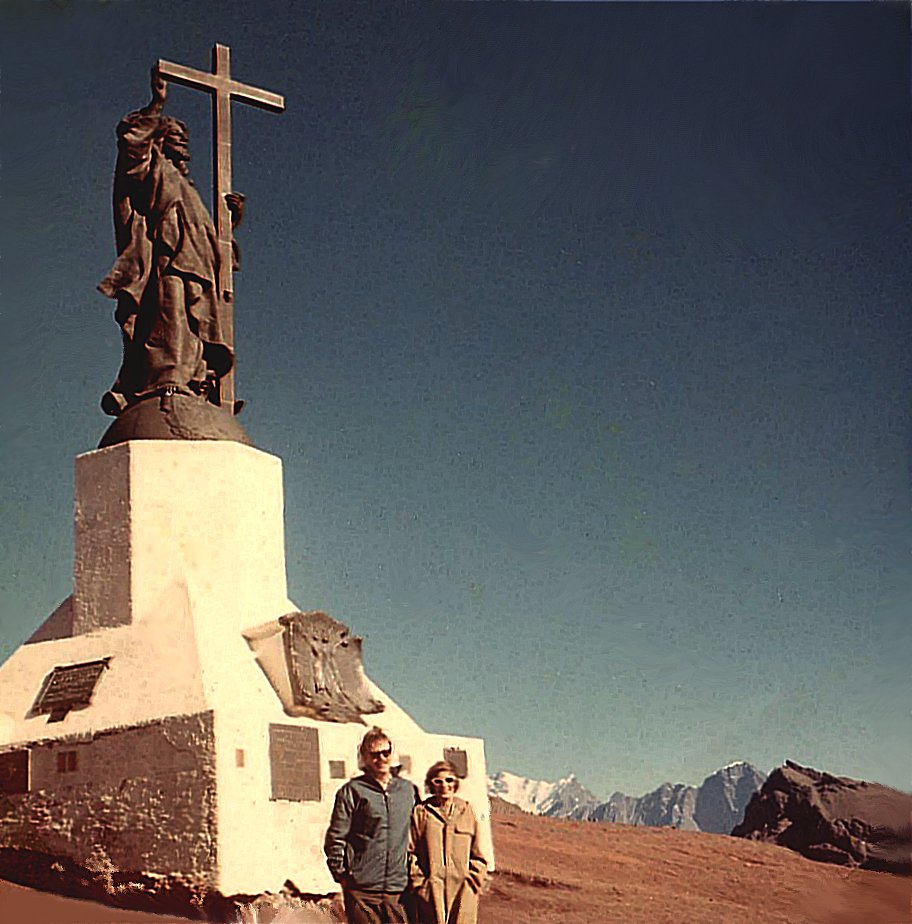 He said his parents are going to sleep elsewhere and he advised the we do the same if we want to get any sleep. Although he did invite us to the party, we decided to go off somewhere rather than argue with Communists all night. We were also encouraged by an American friend who lives in Santiago to visit Christ of the Andes before winter.”
He said his parents are going to sleep elsewhere and he advised the we do the same if we want to get any sleep. Although he did invite us to the party, we decided to go off somewhere rather than argue with Communists all night. We were also encouraged by an American friend who lives in Santiago to visit Christ of the Andes before winter.”
Therefore, we began to prepare for our excursion, and one April weekend in the late Chilean fall we traveled by train high in the Andes with a Chilean friend to a military post where his brother was stationed, and from there we hitchhiked to Portillo, Chile’s best known ski area high in the Andes east of Santiago. From Portillo we hitched a ride further to Christ of the Andes (pictured here to the right), just across Uspallata Pass and the border with Argentina. We spent the night in a small village named Las Cuevas in Argentina, and we will never forget sitting outside our quest house in the very frigid air, looking up at the stars of the southern hemisphere — an unbelievable site. The next morning we got a ride to the statue of Christ of the Andes with an American man who worked with the United Nations.”
The huge statue, supposedly made from melted down cannons, sits upon its concrete bass at 12,572 feet (3832 meters) above sea level. It was created by the Argentine sculptor Mateo Alonso in Buenos Aires and transported piece by piece to its present location in 1904. The Spanish inscription at the base of the statue reads “Se desplomarán primero estas montañas antes que chilenos y argentinos rompan la paz jurada al pie del Cristo Redentor” (roughly translated, “May these mountains be torn asunder before Chile and Argentina ever break the peace treaty made at the feet of Christ the Redeemer”).
Travels Outside Santiago and Outside Chile during the Second Year of our Peace Corp Tenure
Vacation to Patagonia: 1) Punta Arenas and Torres de Paine in southern Chile, and 2) Ushuaia in Tierra del Fuego in southern Argentina (December 26, 1967-January 5, 1968)
During part of our summer vacation, between the day after Christmas 1967 and five days after New Year’s 1968, we traveled to Punta Arenas in the extreme south of Chile on the Strait of Magellan, then further south to Ushuaia in Argentina in Tierra del Fuego on the Beagle Canal. This period of time was in the middle of the summer in the southern hemisphere, when many of the Chileans in Santiago go on vacation.
Diane explained our modes of travel, distance covered, and many details of our adventures in a letter to her parents dated January 17, 1968. “I will begin with where we went and the approximate number of miles covered: (1) south by airplane from Santiago to Punta Arenas = 1400 miles; (2) north by automobile to Puerto Natales and Torres de Paine, then back to Punta arenas = 400 miles; (3) east and south by automobile to Ushuaia, Tierra del Fuego, Argentina = 300 miles; (4) north by airplane to Buenos Aires, Argentina = 1500 miles; (5) west by train to Mendoza, Argentina = 600 miles; (6) west by truck and automobile to Santiago = 250 miles, for a grand total of 4,450 miles in 2 weeks.
“Our flight to Punta Arenas was really beautiful. Luckily, we had a clear day, and our plane, a DC-4, didn’t fly as high as some of the bigger planes. South of Puerto Mont we saw many glaciers, some miles long, endless mountains, estuaries, fiords, and canals. If we would have had time, we would have liked to take a boat trip from Puerto Mont to Punta Arenas, but it’s a 5-day trip. As we flew over the mountain named San Valentin, near Puerto Aisen, it seemed really close to us, completely covered with snow, ice, and glaciers. Punta Arenas is a Chilean port city on the Strait of Magellan in a region known as southern Patagonia.”
Our Methodist minister in Santiago gave us a letter of introduction to the Methodist minister in Punta Arenas, an American missionary, and we were able to stay with him and his family for several days. We comfortably slept on two cots in our sleeping bags in the recreation room of their church. They were wonderful hosts, and Diane and I performed flute and piano music in their little church on Sunday morning.
They invited us to go with them in their car (this photo) to the Patagonian mountain and lake region known as Torres de Paine (“Paine Towers” — paine means “blue” in the language of the Tehuelche native people of Patagonia) where they planned to gather rocks to build a fireplace for their house. We were delighted to go with them — it was a wonderful opportunity for us to visit that incredibly scenic, rugged, and pristine region in the high southern Andes, long before it became a popular tourist attraction, even though it was established as a national park in 1959. The Torres de Paine National Park is today one of the most sought out tourist destinations in the southern Chilean Patagonia, unfortunately replete with hotels and modern tourist facilities. In 1967, fortunately, there were absolutely no facilities — it was truly one of God’s unspoiled gardens.
Our trip began with a five-hour long drive to Puerto Natales, located on a Chilean estuary northwest of Punta Arenas. There we spent the night in our sleeping bags on the floor of a small church. The next day included a three-hour drive on a dirt road across a fairly flat part of the rugged Chilean Patagonia, as seen in these photographs. The only wildlife we saw was a lone guanaco (the southern Andean relative of the central-Andean llama and alpaca) in the middle of the road. 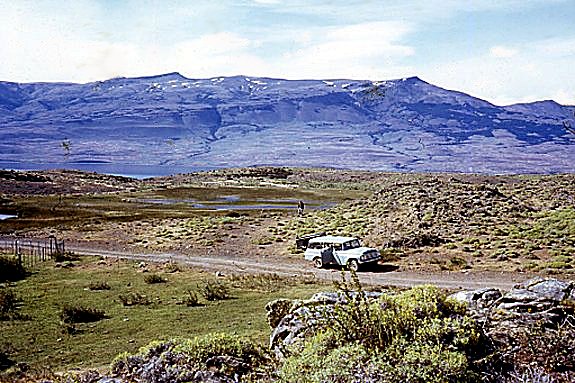
We finally arrived at the site where our missionary friend intended to collect rocks, along the shore of Lake Pehoé, a beautiful sight with the Cuernos de Paine in the background, across a crystal clear fresh water lake fed mainly by the Paine River.
While our friends were off gathering rocks, we were given the task of cooking dinner, which would consist of two mutton legs that we bought in Puerto Natales. The setting for the barbeque was unbelievably beautiful, and very windy and rather cold. This photo is a 1967 selfie of us posing on a hill with Cuernos del Paine (“Horns of Paine” and other particular mountain formations in the Torres de Paine region) in the background.  Our barbequing of the mutton was not a success because it was not tender. We were not told how to cook it, and I was relying my Minnesota Boy Scout cooking-over-a-fire training. We grilled it over my “musician’s” fire (pretty, hot, but inefficient for cooking), but the wind and lack of a cover over the meat caused the mutton legs to be tough. We were later told that we should have stewed it in a pot of water. Who was to know! We have forgotten how tough the meat was, but we will never forget this picture of us two cooks, with the beautiful background of the Torres de Paine. We were so fortunate to visit that outstandingly scenic, rugged, and unspoiled region in the high southern Andes of the Chilean Patagonia, long before it became a major tourist destination.
Our barbequing of the mutton was not a success because it was not tender. We were not told how to cook it, and I was relying my Minnesota Boy Scout cooking-over-a-fire training. We grilled it over my “musician’s” fire (pretty, hot, but inefficient for cooking), but the wind and lack of a cover over the meat caused the mutton legs to be tough. We were later told that we should have stewed it in a pot of water. Who was to know! We have forgotten how tough the meat was, but we will never forget this picture of us two cooks, with the beautiful background of the Torres de Paine. We were so fortunate to visit that outstandingly scenic, rugged, and unspoiled region in the high southern Andes of the Chilean Patagonia, long before it became a major tourist destination.
Back in Punta Arenas, a port city on the Strait of Magellan, its shipping docks are constantly busy, with many large and small freighters coming and going. The town is windy much of the time, and cold at night. It is a very flat along much of the shoreline — Punta Arenas means “sandy point” in Spanish) — and the trees are stunted and wind-blown. This region of southern Patagonia is known for sheep raising. Because Punta Arenas is a freeport, we spent time buying stuff we can’t get in Santiago, like Raisin Bran, Grape Nuts, Whip and Chill, coconuts, cleanser, a dessert mix, and candy. Fruit is expensive in Punta Arenas, and very few flowers grow here. The sheep, however, grow like crazy, and the hundreds of sheep, the herders with their horses and sheep dogs, often congest the main road into Punta Arenas during their often daily migrations.
The town is windy much of the time, and cold at night. It is a very flat along much of the shoreline — Punta Arenas means “sandy point” in Spanish) — and the trees are stunted and wind-blown. This region of southern Patagonia is known for sheep raising. Because Punta Arenas is a freeport, we spent time buying stuff we can’t get in Santiago, like Raisin Bran, Grape Nuts, Whip and Chill, coconuts, cleanser, a dessert mix, and candy. Fruit is expensive in Punta Arenas, and very few flowers grow here. The sheep, however, grow like crazy, and the hundreds of sheep, the herders with their horses and sheep dogs, often congest the main road into Punta Arenas during their often daily migrations.
After Punta Arenas we hitched a ride on a small freighter, crossing the Strait of Magellan to Porvenir, a tiny Chilean village on the north shore of Tierra del Fuego. We weren’t sure what to do when we walked into the ship’s hold with our stuff. Once the boat began its crossing, one of the sailors saw us huddled in the hold and invited us up on deck where were were offered coffee and food. We weren’t expecting such service, and we were trying to be invisible so as not to be charged for the trip. The crew, however, was very hospitable, and they were very happy to give us a lift.  When we arrived on land once again, on this huge island known as Tierra del Fuego, meaning “Land of Fire” (so named because of the many bonfires the Native Americans always had burning during the age of Spanish and Portuguese exploration when Ferdinand Magellan first sailed through the strait that now bears his name), we disembarked and I took the following photograph of Diane, the ship, and the calm waters of the strait. I call this photograph la inmigrante, “the female immigrant” in Spanish, who just landed on foreign soil and looks lost. The terrain on this northern part of Tierra del Fuego is very flat everywhere, and is very different from anything we have seen on the Punta Arenas side of the Strait of Magellan — you also see hundreds of sheep grazing on the land and a lot of oil development.
When we arrived on land once again, on this huge island known as Tierra del Fuego, meaning “Land of Fire” (so named because of the many bonfires the Native Americans always had burning during the age of Spanish and Portuguese exploration when Ferdinand Magellan first sailed through the strait that now bears his name), we disembarked and I took the following photograph of Diane, the ship, and the calm waters of the strait. I call this photograph la inmigrante, “the female immigrant” in Spanish, who just landed on foreign soil and looks lost. The terrain on this northern part of Tierra del Fuego is very flat everywhere, and is very different from anything we have seen on the Punta Arenas side of the Strait of Magellan — you also see hundreds of sheep grazing on the land and a lot of oil development.
Our plan was to hitchhike to Ushuaia, Argentina, on the Beagle Canal in the southernmost part of Tierra del Fuego. We were fortunate to immediately hitch a ride in the back of a pickup truck eastward to the Chilean village of Cerro Sombrero,  close to the Argentine border in northeastern Tierra del Fuego. The driver was not talkative at all, and he had a rifle in his back window, which was concerning to us in this extremely lonely part of the world. However, everything was cool, literally, as we huddled in the back of his truck for several hours, enjoying the strange landscape. Happily, we were heading eastward on the only road, soon to arrive to “Hat Hill” (the translation of Cerro Sombrero) where we were told we would certainly find a ride south to the “end of the earth,” or at least the end of the South American continent. As this photograph shows, it was also the end of a rainbow, which we interpreted as a very positive sign.
close to the Argentine border in northeastern Tierra del Fuego. The driver was not talkative at all, and he had a rifle in his back window, which was concerning to us in this extremely lonely part of the world. However, everything was cool, literally, as we huddled in the back of his truck for several hours, enjoying the strange landscape. Happily, we were heading eastward on the only road, soon to arrive to “Hat Hill” (the translation of Cerro Sombrero) where we were told we would certainly find a ride south to the “end of the earth,” or at least the end of the South American continent. As this photograph shows, it was also the end of a rainbow, which we interpreted as a very positive sign.
Our missionary friends in Punta Arenas explained that Porteños (people from Buenos Aires) or other Argentinos from Río Gallegos and/or other Argentine coastal towns, often drive to Ushuaia for the holidays, and that we should be able to hitch a ride south, especially because it is a lengthy holiday (between Christmas and New Years). All cars coming from the north have to go through Cerro Sombrero in Chile, and it is the last outpost before making the difficult drive to Ushuaia. 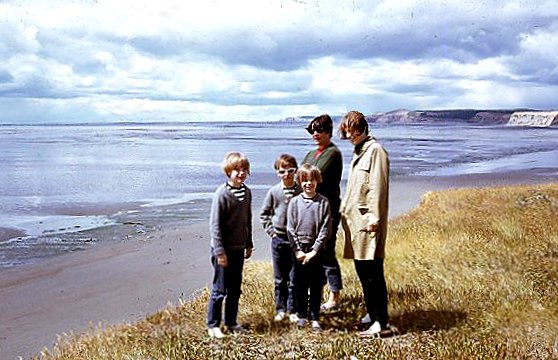 Once we arrived in Cerro Sombrero, a wonderful family (mom, dad, and 3 pre-teen daughters) from Buenos Aires stopped for us and agreed to take us with them to Ushuaia. Dad was an architect in Buenos Aires, Mom was a mom, and the three little girls were little talkative and curious dolls. The family became like our long-lost relatives — they were interested in our lives and we were interested in there’s. We had so much fun speaking Spanish to them and trying to understand their Argentine accents, especially of the little girls. When we asked them donde está tu mamá (“where’s your mother?”), they would reply, something that sounded like sia (sounds like
Once we arrived in Cerro Sombrero, a wonderful family (mom, dad, and 3 pre-teen daughters) from Buenos Aires stopped for us and agreed to take us with them to Ushuaia. Dad was an architect in Buenos Aires, Mom was a mom, and the three little girls were little talkative and curious dolls. The family became like our long-lost relatives — they were interested in our lives and we were interested in there’s. We had so much fun speaking Spanish to them and trying to understand their Argentine accents, especially of the little girls. When we asked them donde está tu mamá (“where’s your mother?”), they would reply, something that sounded like sia (sounds like Asia) jhegó asia, for ya llegó ella (“she just arrived”). Notice in this photograph that the middle daughter is wearing Diane’s white-rimmed dark glasses.
It was a most interesting trip, especially when the road over the mountain pass as we reached the southernmost Andes became mostly mud (first picture below), situated high above the beautiful Lago Fagnano (second picture below). After several unsuccessful attempts to make it over the pass, all of us passengers got out to push, and we finally made it.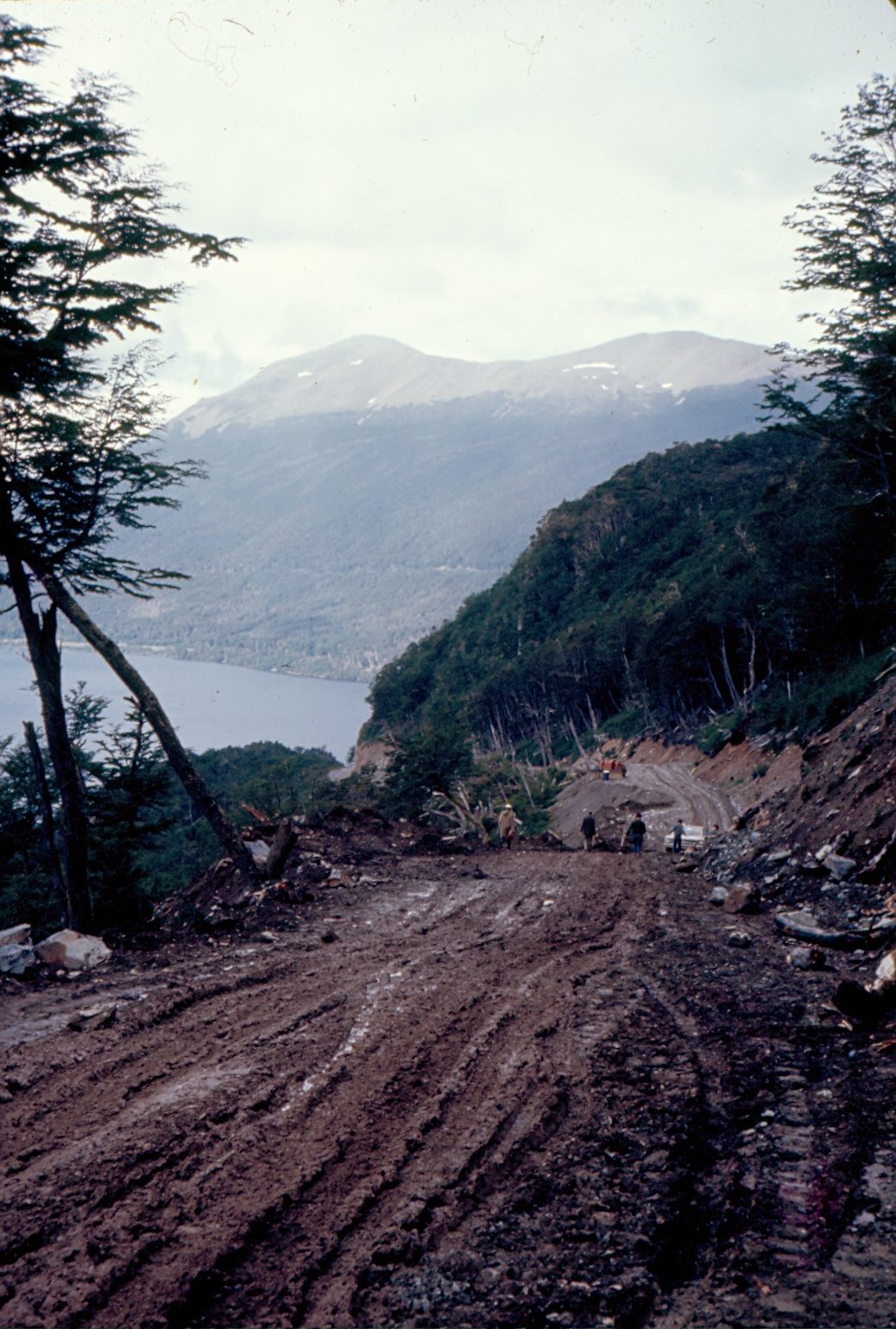
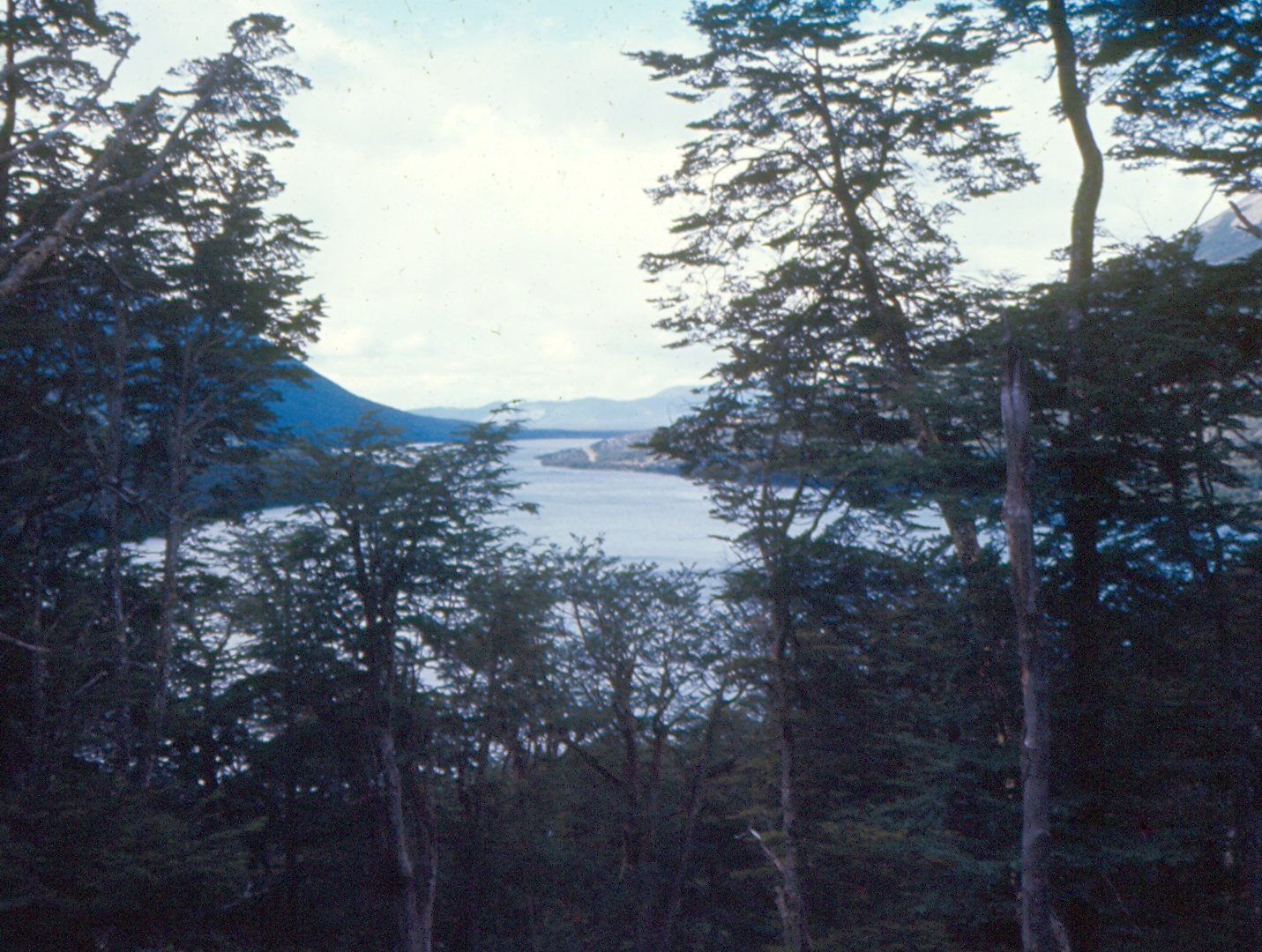
Ushuaia in 1967 was a small town on the Beagle Canal, unspoiled by tourism. Diane wrote, “What a contrast Ushuaia is to Punta Arenas! Here, mountains are all around us, and lakes, estuaries, and forests abound — it’s really beautiful! All the houses we have seen are made from wood, many unpainted and stark, while others are brightly tinted. Many have colorful roofs, like this boathouse built on the shore of the Beagle Canal.” 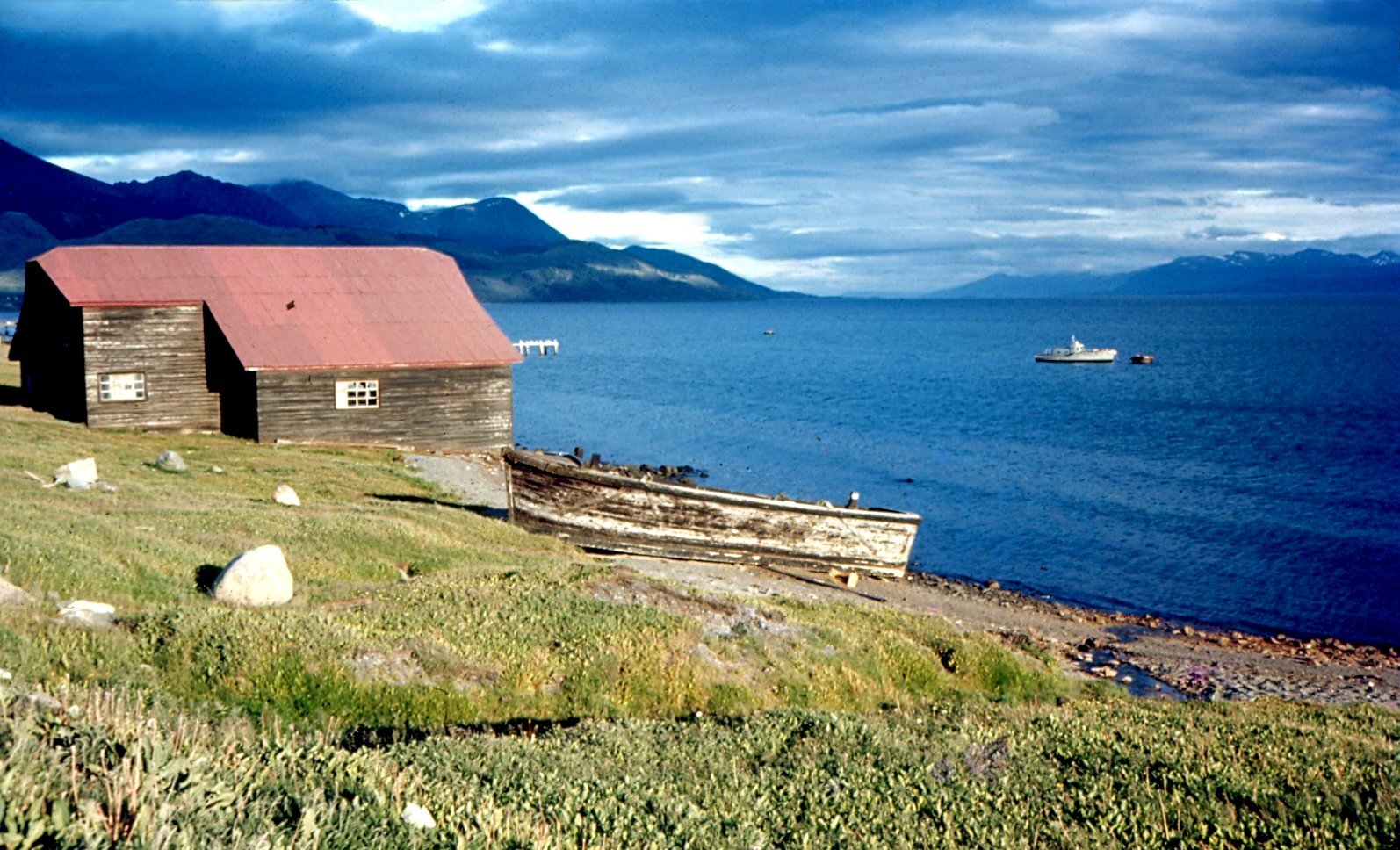

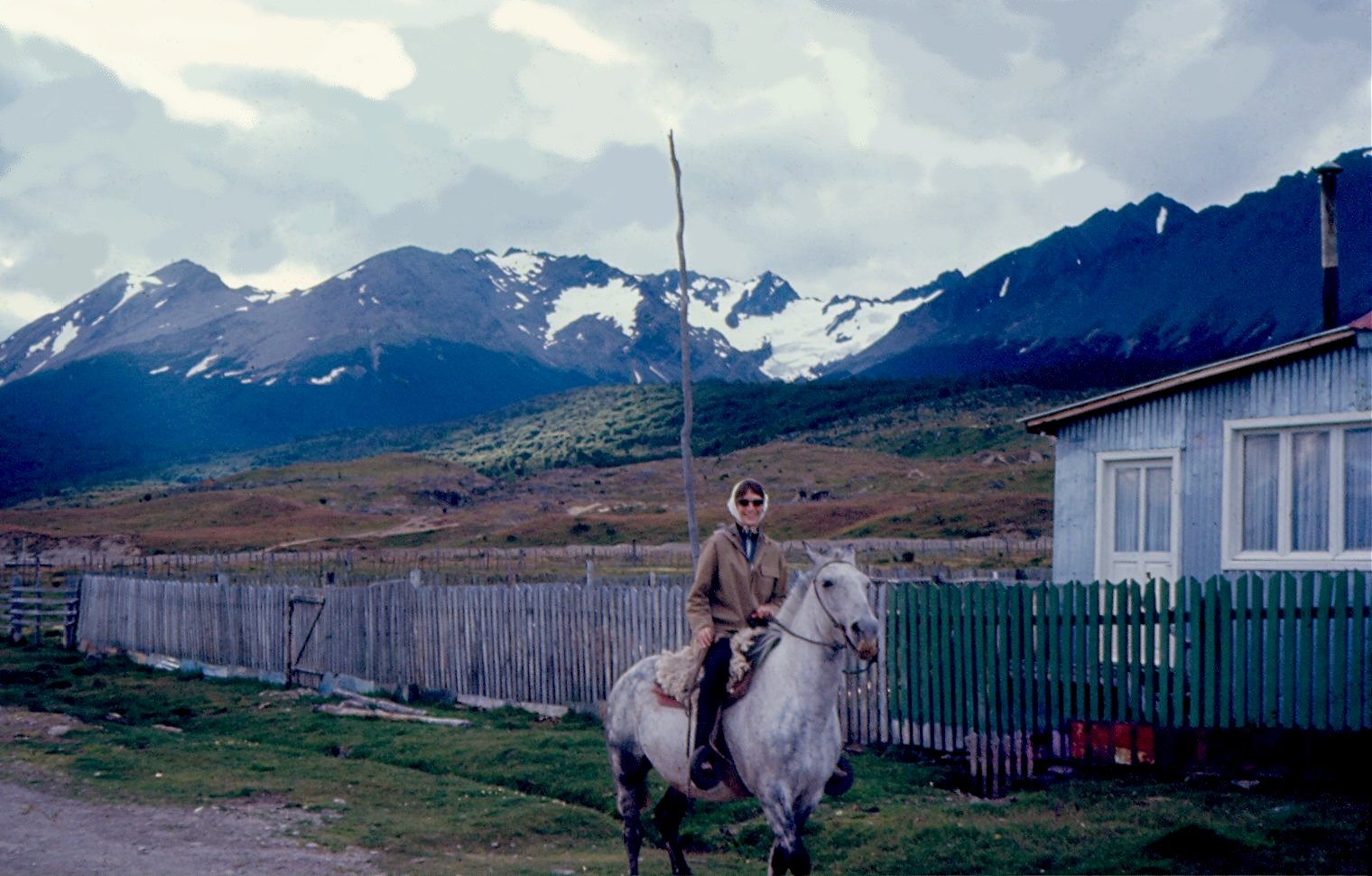 We had no contacts in Ushuaia, but we explained our dilemma and needs to two Canadian clerks (two more of our guardian angels) in an English-speaking Christian book store in the town, and they contacted a local Pentecostal minister who agreed to let us sleep on the floor of his garage, as best we can remember. Either he or his neighbor owned a horse, and Diane, an avid rider, asked if she could have permission to ride the horse around the area. Her wish was granted, and she spent part of our second day in Ushuaia horsback riding on some of the local town dirt roads. I accompanied her on foot and photographed her excursion and the beautiful vistas, as seen in these photographs of the mountain range north of Ushuaia and Ushuaia over 50 years ago.
We had no contacts in Ushuaia, but we explained our dilemma and needs to two Canadian clerks (two more of our guardian angels) in an English-speaking Christian book store in the town, and they contacted a local Pentecostal minister who agreed to let us sleep on the floor of his garage, as best we can remember. Either he or his neighbor owned a horse, and Diane, an avid rider, asked if she could have permission to ride the horse around the area. Her wish was granted, and she spent part of our second day in Ushuaia horsback riding on some of the local town dirt roads. I accompanied her on foot and photographed her excursion and the beautiful vistas, as seen in these photographs of the mountain range north of Ushuaia and Ushuaia over 50 years ago.  Other than the horse, our only transportation around the town was our feet, and Ushuaia is very steep from south to north. We lived up near the top of a hill, and we recall making our hiking easier by saying “push” / “trudge” for our left and right steps. It seemed to help by taking our minds off the physical exertion.
Other than the horse, our only transportation around the town was our feet, and Ushuaia is very steep from south to north. We lived up near the top of a hill, and we recall making our hiking easier by saying “push” / “trudge” for our left and right steps. It seemed to help by taking our minds off the physical exertion.
After a few days of exploring the town, we hitched a ride to the Tierra del Fuego National Park, west of Ushuaia, where we stayed two nights (New Year’s Eve and Day) as guests of the National Park hotel, as Diane explained it in a letter home. “We spent New Years Eve and Day with some Argentine friends (two families) we had made in the National Park of Tierra del Fuego, 20 km west from Ushuaia. We stayed in the National Park hotel for almost nothing because we were “missionaries of peace” as they called us. The only thing we paid for were meals — good thing, too, because we were running out of money. The pay scale is higher in Argentina than in Chile, and everything is very expensive. Thinking in Chilean escudos, the money went fast. In US dollars it wasn’t too bad, because they thought we were “missionaries of peace.” Argentina has never had Peace Corps Volunteers, and the term Cuerpo de Paz was not familiar to the hotel administers. Their understanding of who we were and what we were doing, however, was certainly correct, and we were very thankful for their gift to us.
In the National Park of Tierra del Fuego, west of Ushuaia, we observed wild horses and other wildlife, hiked several trails along the shore of Lago Roca (“Rock Lake”), and enjoyed grilled barbecue steaks with the other guests on New Year’s Eve. We made friends with some of the Argentine guests, and just tried to absorb the beautiful scenery of the snow-capped mountains, lakes, estuaries, and rugged landscapes. Here are four photographs of that memorable place on the southernmost part of Argentina (from the top to bottom are Lago Roca with some new friends; wild horses grazing along the shore of Rock Lake; another view of the lake from the shore; and Diane conversing with other Argentinian National Park visitors at a barbeque on New Year’s Eve, 1967).
Diane wrote, “When we returned to Ushuaia after New Year’s Day we had an interesting experience because we once again stayed with the Pentecostal Minister and wife, but this time we slept in an extra room in the back of their house and we performed music for the Wednesday night service at their church. Dale played hymn melodies on his flute and I sang alto. Their service wasn’t so different from ours [we are lifelong Baptists], really, except that everyone prayed out loud at the same time. They knew the same hymns we did, like The Old Rugged cross, In the Garden, What a Friend we have in Jesus, Ivory Palaces, and others.” Music has such wonderful powers of communication, building friendships, and creating trust, and the opportunity we had to share our God-given gifts with fellow believers at the bottom of the Western Hemisphere in Ushuaia, Argentina, was an awesome experience.
Late evenings in Ushuaia during the summer months of December and January are spectacular because it is light almost all night, being so close to Antarctica.  One of the sights that has always stuck in our minds
One of the sights that has always stuck in our minds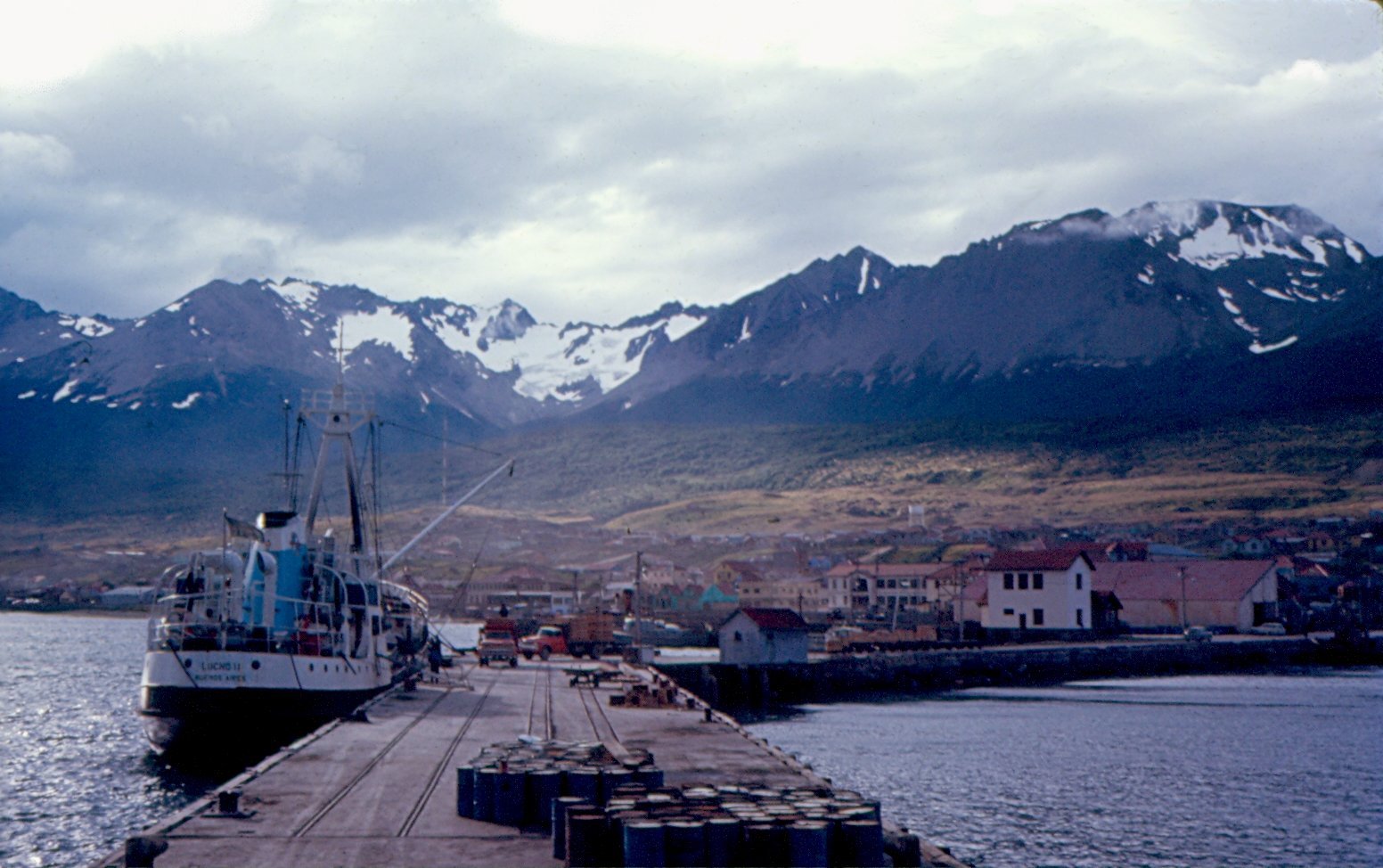 is of an old ship (HMS Justice, aka Saint Christopher) that partially sank in the Beagle Canal during an earthquake in 1957. The shipwreck is seen in this photograph through the rigging of another sailing ship tied to the main pier (the next photograph is of the main pier in 1967). Interestingly, this historic shipwreck is still there, officially recognized today as a memorial to an earthquake from long ago (although there are conflicting stories) — we saw it again in 2016 when we visited Ushuaia on a cruise from Buenos Aires to Santiago. The downtown of Ushuaia can be seen in this photograph of the main pier. [Diane’s letter home] “One of the big building in Ushuaia, located at the beginning of the pier on the main street, is the Hotel Albatross, a very social place — in fact, the only social place in town in 1967. It looks out over the harbor.”
is of an old ship (HMS Justice, aka Saint Christopher) that partially sank in the Beagle Canal during an earthquake in 1957. The shipwreck is seen in this photograph through the rigging of another sailing ship tied to the main pier (the next photograph is of the main pier in 1967). Interestingly, this historic shipwreck is still there, officially recognized today as a memorial to an earthquake from long ago (although there are conflicting stories) — we saw it again in 2016 when we visited Ushuaia on a cruise from Buenos Aires to Santiago. The downtown of Ushuaia can be seen in this photograph of the main pier. [Diane’s letter home] “One of the big building in Ushuaia, located at the beginning of the pier on the main street, is the Hotel Albatross, a very social place — in fact, the only social place in town in 1967. It looks out over the harbor.”
 In 1967, other than its proximity to the Tierra del Fuego National Park, Ushuaia was sustained by its military base and little more. At one time the area was a penal colony, and the old train that sits on display at the Argentine military base is a memorial to that earlier time. [Diane’s letter home] “The lifeline for this town is an Argentine military base. We got to know it pretty well by constantly checking on a crazy military flight to Buenos Aires that we wanted to take. We were planning to take the flight all along, but hadn’t anticipated that there would be any cost. Some friends of ours in Santiago took an Argentine military flight from Ushuaia to Buenos Aires for no free last year. Finally, with a certain amount of talking, daring, luck, and finagling [see Dale’s addendum below] we got to Buenos Aires. Otherwise, we would have had to go back to Punta Arenas and try to get a plane from there, and there was nothing definite that we knew about. We were indeed fortunate to get on the military flight.”
In 1967, other than its proximity to the Tierra del Fuego National Park, Ushuaia was sustained by its military base and little more. At one time the area was a penal colony, and the old train that sits on display at the Argentine military base is a memorial to that earlier time. [Diane’s letter home] “The lifeline for this town is an Argentine military base. We got to know it pretty well by constantly checking on a crazy military flight to Buenos Aires that we wanted to take. We were planning to take the flight all along, but hadn’t anticipated that there would be any cost. Some friends of ours in Santiago took an Argentine military flight from Ushuaia to Buenos Aires for no free last year. Finally, with a certain amount of talking, daring, luck, and finagling [see Dale’s addendum below] we got to Buenos Aires. Otherwise, we would have had to go back to Punta Arenas and try to get a plane from there, and there was nothing definite that we knew about. We were indeed fortunate to get on the military flight.”
[Dale’s addendum] From Ushuaia we talked our way on a military flight to Buenos Aires, since we did not have enough money for the commercial flight. Actually, we did not even have enough money for the complete military flight to Buenos Aires, so we just paid a fee to fly to Rio Gallegos, Argentina, which is about 200 miles east from Ushuaia near the Atlantic entrance to the Strait of Magellan. Nobody on board had a printed ticket, and when we landed in Rio Gallegos everyone had to get off the plane while it refueled. We left our sleeping bags and sparse luggage in and by our seats — which were folding chairs! — intermingled with the other passengers on the tarmac, and then got on board when we were all told to do so by the pilot. Thus, we literally “stowed away” to Buenos Aires, about 1200 miles. There were no questions asked of us at all, and we slept (or feigned sleep) on the entire long last leg of the flight. Perhaps the pilot, crew, or “flight attendant” (there wasn’t one that we could tell) knew we were “hitchhiking” and did not care — we’ll never know. We made the assumption, however, that since the logical thing to do for a couple who pays for passage to a particular place is to leave the airplane with their luggage upon landing, the crew would assume we had tickets; however, there were no tickets, and not even a passenger list! Needless to say, we were the first people to get off at the airplane in Buenos Aires, the first to get off the tarmac, and the first to go through customs.
We spent only one night in Buenos Aires, mostly trying to figure out how we could make the trip back to Santiago on our very limited budget. The next morning we took a bus to the train station and purchased second class train tickets to Mendoza on the other side of the vast Pampas in western Argentina, near to the western slopes of the Andes. That was a horrible 15-hour ride because it was so hot and dusty.
From Mendoza we began our hitch hiking trip to Santiago, which we found out was not going to be easy! On one leg of the trip we got a ride around 6 PM in a truck with about 35 slightly inebriated Argentine workers that were being transported to work on the road near the Chilean border at an elevation of 10,000 feet or more. I rode in the back of the truck with the workers, while Diane rode in the cab with the driver and the boss. My experience was unforgettable, not only for the beauty of the Andean scenery, but especially my attempts to communicate with the workers using my Americanized Chilean Spanish, while they all spoke their peasant Argentine Spanish, embellished with drunken slurs. I was often offered a swig or two of their cheap wine, but I devised a way to pretend to drink it when they passed around the community bottle — I put my thumb over the opening of the bottle and made guzzling sounds like I was drinking it, then thanking them with a fake drunken Spanish accent. It worked!
Passing by Aconcagua, the highest mountain in the Western Hemisphere at sunset, was an experience Diane and I will never forget. I assume we traveled in the truck most of the night, racing around hundred of mountain curves — frankly, I don’t remember the details. Diane seems to have had a better memory, and she related some details about the trip in the following letter to her parents, dated January 17, 1968:
“The train ride to Mendoza, across the Argentine Pampa, is something to avoid — 15 hours of dust, wind, bumps, and flat flat land. The terrain started out like Minnesota, with lots of grass, trees, farmland, but changed to South Dakota and Montana, without any hills. When our (future) kids are bad, I will threaten to send them to the middle of the Argentine Pampa. After the long and difficult train ride, we stayed over night in Mendoza. The next day we traveled to Las Cuevas on the Argentine side of the border with Chile, and stayed there over night again, like we did a year ago when we went up to the statue of Christ of the Andes. The next day, on a Monday, we finally made it home to Santiago. All in all, it was a good trip and we saw and experienced some country that very few people get to see.”
After waking up in a pensión in Las Cuevas on the Argentine-Chilean border and then going through customs, it took us a while to hitch a ride through the long Andean tunnel between the two countries. Private passenger cars were either full, or the drivers were worried about adding extra (i.e., too much) weight in their vehicles. Nevertheless, we succeeded to get a ride by the grace of God, and arrived in Santiago that night to get a good night’s sleep. We had many many tales to tell.
Vacation to the Atlantic Coast of South America: 1) Buenos Aires, Argentina; 2) Montevideo and Punta del Este, Uruguay; and 3) Rio De Janeiro, Sao Paulo, Santos, Iguazu Falls, Brazil (January 30-February 22, 1968)
blah blah
Personal Ethnomusicological Fieldwork in Chile in 1968
It was partially because of my last, and third, concurrent Peace Corps position in Santiago, which I wrote about above [“. . . working with a Chilean governmental department called Departamento de Promocion Popular (Department of Popular Promotion), which has a several Chilean folklorists on its staff, working with rural Chilean folklore and music. . . “], that I was inspired to attend several Chilean religious folk festivals, record the music, photograph the dances, and write fieldnotes about what I observed. I was looking ahead to perhaps using this research as a basis for a Ph.D. dissertation in ethnomusicology sometime in the future.
Most of the religious folk festivals in Chile, and throughout the Andes, are patronal, meaning that they are Catholic (but not liturgical) celebrations that are in honor of a patron saint. These saints are large in number, and even the Holy Virgin is celebrated in patronal festivals. Catholic churches, villages, cities, countries, and even groups like the Peruvian army, have patron saints and their corresponding festivals.
Festival of the Virgen de Carmen, La Tirana, Chile (July 15-16, 1968)
(Letter to Diane’s parents, July 4, 1968). “Next week Diane and I are going to the extreme north of Chile to record the music of the well-known religious folk festival called La Tirana (“The Tyrant”). For three days the people, most of Native American descent, celebrate the village of La Tirana’s patron saint known as La Virgen de Carmen in Spanish. Catholic believers will be dancing in traditional costumes to the music of drums, flutes, trumpets, and who knows what else. La Tirana is just to the east of the Pan American Highway near Iquique. We will fly up, I think, unless we decide to go by bus.”
Excerpts from Diane’s letter to Greta, a high school friend, August 25, 1968: “About a month ago, Dale and I took a vacation to northern Chile to attend the religious festival known as La Tirana (The Tyrant), which is a patronal festival dedicated to the Virgin of Carmen in the village of La Tirana (El Tamarugal Province, Tarapacá Region). Dale has become interested in the indigenous and folk music of Chile, and he documented (i.e., tape recorded and photographed) a lot of the music and dancing during several days of the festival. Northern Chile is all desert — a huge contrast with the lakes, fiords, and forests of southern Chile. The desert, however, is beautiful in a barren way. We stopped near to the town of Antofagasta, about half way to our destination and about 750 miles north of Santiago, to visit a big U.S./Chilean copper mine named Chuquicamata — it is the largest open pit copper mine in the world. As luck was with us, we happened to meet a Chilean couple — the man is a jefe or leader in the mine — with a truck who took us on a personal tour of the mine and the refining plants, explaining the entire process to us. We were also lucky enough to stay with them for a couple of days. We continued our trip to La Tirana by sitting in the aisle of a bus for six hours. 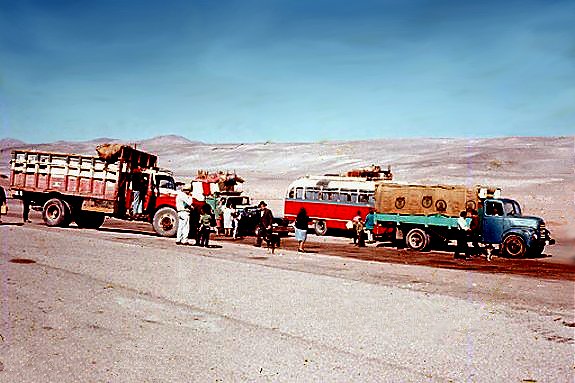 People come to attend this important Chilean festival from all over Chile and Bolivia. The little town of La Tirana normally has about 50 inhabitants, but for this holiday it swells to 20,000 people. They come by the busloads, many with tents and sleeping rolls. To be frank, when we first arrived, I was struck by the hopelessness of our situation — no place to stay, no place to leave our junk safely (we were often warned about robbers), and, a minor point, no place to go to the bathroom! But, we stuck it out, and with luck found a place to stay with a local family in the town. While looking for a place to stay, one of my students from the Catholic University in Santiago startled me by yelling, Mrs. Olsen! What are you doing here? I told him I didn’t really know.”
People come to attend this important Chilean festival from all over Chile and Bolivia. The little town of La Tirana normally has about 50 inhabitants, but for this holiday it swells to 20,000 people. They come by the busloads, many with tents and sleeping rolls. To be frank, when we first arrived, I was struck by the hopelessness of our situation — no place to stay, no place to leave our junk safely (we were often warned about robbers), and, a minor point, no place to go to the bathroom! But, we stuck it out, and with luck found a place to stay with a local family in the town. While looking for a place to stay, one of my students from the Catholic University in Santiago startled me by yelling, Mrs. Olsen! What are you doing here? I told him I didn’t really know.”
“The festival of La Tirana is made up of different dancing groups, or Catholic Clubs, as they are called. They come with their banners and statues of their particular Virgins from many different towns and villages. 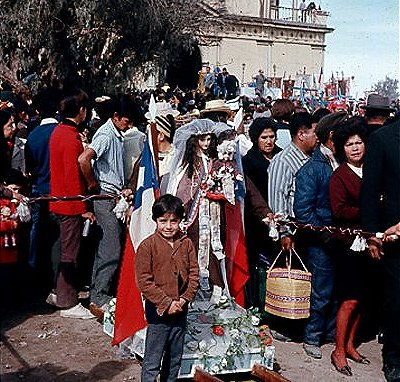 Because La Tirana is close to the Bolivian border, there is some Bolivian influence in the colorful costumes used by some of the groups. Surprisingly, some of the dancing groups also wear North American Indian costumes, with feather headdresses and carrying spears. The many varied groups first present themselves to the patron saint (in this case,
Because La Tirana is close to the Bolivian border, there is some Bolivian influence in the colorful costumes used by some of the groups. Surprisingly, some of the dancing groups also wear North American Indian costumes, with feather headdresses and carrying spears. The many varied groups first present themselves to the patron saint (in this case,  the Virgin of Carmen, aka the Virgin of La Tirana) in the Cathedral. This is a long performance, with all the groups alternating their dances with their songs dedicated to the Virgin. The musical instrument groups consist mostly of drums and brasses, and a few others with drums and flutes. Dale recorded every flute there, I think, because he has a great interest in flutes of all types. The evening is when things got lively, as people milled about the plaza, watching the different groups perform. The masks of some of the dancers have lighted eyes. Toward midnight there were many bonfires and fireworks. Also, participants set off big paper balloons, carried aloft by a little fire under each balloon. The noise and dancing went on until the morning, but we went “home” to our “soft” beds (sleeping bags on the floor).”
the Virgin of Carmen, aka the Virgin of La Tirana) in the Cathedral. This is a long performance, with all the groups alternating their dances with their songs dedicated to the Virgin. The musical instrument groups consist mostly of drums and brasses, and a few others with drums and flutes. Dale recorded every flute there, I think, because he has a great interest in flutes of all types. The evening is when things got lively, as people milled about the plaza, watching the different groups perform. The masks of some of the dancers have lighted eyes. Toward midnight there were many bonfires and fireworks. Also, participants set off big paper balloons, carried aloft by a little fire under each balloon. The noise and dancing went on until the morning, but we went “home” to our “soft” beds (sleeping bags on the floor).”
Indeed, I (Dale) think I probably did record all the flute music (and more) at the La Tirana festival. In fact, this experience was my first ethnomusicology field trip endeavor. At the time I did not know I would someday become a professional ethnomusicologist, although I was vaguely thinking about specializing in Latin American music for a doctorate degree. During those years in Chile I was a symphonic flutist; however, I was also developing an interest in Andean flutes and folk music which we would often hear as we traveled. I was also interested in how and why music plays such an important role in the lives of country and urban folk throughout the regions of South America that we had recently visited. With the La Tirana religious folk festival celebrating the Virgen of Carmen in my mind one day, as I was browsing in Santiago’s only English bookstore, I came across a book titled “Theory and Method in Ethnomusicology” by Bruno Nettl, a professor of Ethnomusicology at the University of Illinois. I purchased the book and read it from cover to cover before setting foot in La Tirana. Therefore, I had some ideas about how to conduct ethnomusicological fieldwork, and for two days in La Tirana, July 15-16, 1968, I observed, asked questions, took dozens of photographs, made copious fieldnotes, and recorded hours of music on a portable reel-to-reel tape recorder. In the following paragraphs I turn my approximately dozen or so handwritten fieldnote pages, titled “observations” and written as an outline, into a short musical ethnography (musical/cultural description) that we title as follows:
“The Religious Patronal Folk Festival to the Virgin of Carmen in La Tirana, Chile, July 15-16, 1968.”
I. The setting. La Tirana is a small pueblo (“village”) in 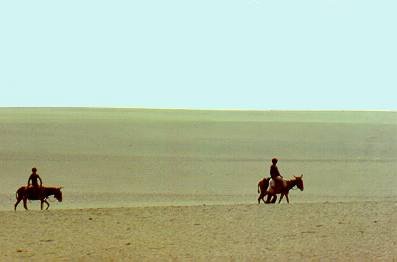 northern Chile with a population of about 50 people. It is located about 17 km east of the Pan American Highway almost directly east of Iquique. Specifically, the village is in the middle of the Atacama Desert, on the edge of the Solar de Pintados, in the Pampa de Tamarugal, with the Andes to the east. This is one of the driest deserts in the world.
northern Chile with a population of about 50 people. It is located about 17 km east of the Pan American Highway almost directly east of Iquique. Specifically, the village is in the middle of the Atacama Desert, on the edge of the Solar de Pintados, in the Pampa de Tamarugal, with the Andes to the east. This is one of the driest deserts in the world.
 La Tirana consists of very small houses called mediagues (“emergency houses”) that are made of adobe or wood with dirt floors. A number of adobe walls surround some of the shacks. During the festival, a number of the mediagues were used by the dance groups as places to change into their costumes, leave their musical instruments and instrument cases, eat food, and relax. This photograph is of one such place, used by dance group called the Catholic Society of Sioux Indians.
La Tirana consists of very small houses called mediagues (“emergency houses”) that are made of adobe or wood with dirt floors. A number of adobe walls surround some of the shacks. During the festival, a number of the mediagues were used by the dance groups as places to change into their costumes, leave their musical instruments and instrument cases, eat food, and relax. This photograph is of one such place, used by dance group called the Catholic Society of Sioux Indians.
A large Catedral (“Cathedral”) is in the very center of the town, the most 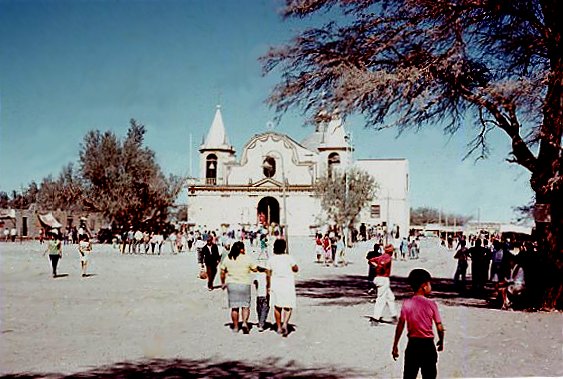 important building in the area. It stands at the eastern end of and faces a large dirt plaza containing three or four trees. Next to the Cathedral is the police station or barracks (cuartal de carabineros), a white and green wooden building. Across the Cathedral and police station is a rather good looking two-story building with a balcony that houses a restaurant, bar, and grocery store. The town has no sanitation system, no water system other than public faucets, and only a few of the buildings have electricity. Garbage disposal consists of a hole in the backyard of each home where the garbage is thrown, and which is later covered with dirt. The main means of sustenance of the few people in La Tirana is growing fruit and olives.
important building in the area. It stands at the eastern end of and faces a large dirt plaza containing three or four trees. Next to the Cathedral is the police station or barracks (cuartal de carabineros), a white and green wooden building. Across the Cathedral and police station is a rather good looking two-story building with a balcony that houses a restaurant, bar, and grocery store. The town has no sanitation system, no water system other than public faucets, and only a few of the buildings have electricity. Garbage disposal consists of a hole in the backyard of each home where the garbage is thrown, and which is later covered with dirt. The main means of sustenance of the few people in La Tirana is growing fruit and olives.
II. The history of the Virgin of Carmen Festival, as explained to Dale. This Catholic religious folk festival, some performers told me, is Bolivian in origin, coming from somewhere high in the Andes of Bolivia. After a time, the statue of the Virgin of Carmen, a regional patron saint, was moved to La Tirana in the Chilean desert, then to Iquique on the Chilean coast, and finally back to La Tirana.
The patronal festival of the Virgin of Carmen takes place each year beginning on July 15th and lasting through the evening of the 16th. During that time, and even days before, about 20,000 to 30,000 people converge onto the tiny village of La Tirana, most arriving by old school-type buses or trucks.
Approximately 90% of the people that attend this festival do so in order to fulfill their mandas or “promises” made to the patron saint. A manda is made and carried out when a person prays to the Virgin of Carmen (“miraculously” a euphemism for the Virgin Mary, I assume), asking her for a good year, healing, good health, or other things. If the prayer is answered, then the person must fulfill his or her part of the promise. This includes an act of sacrifice, such as walking for miles on one’s bare knees with pants rolled up or stockings down. Thousands of people line up in the Cathedral and file past the statue of the Virgin to receive a blessing. Many people burn candles.
About 100 dancing groups perform day and night in front of the church paying their tributes to the Virgin of Carmen. About 87 groups are up to 90 in total of various types are taking place at La Tirana this year.  One of the most popular type of dancing group is based on Native North American cultures, including La Sociedad de Pieles Rojas (“The Society of Redskins”) and “La Sociedad Catolica de los Indios Sioux (“The Catholic Society of the Sioux Indians”), both from Iquique, Chile. Approximately 25% of the dancing groups that participate at La Tirana are inspired by Native North American cultures. The Pieles Rojas, because of its stereotypical name, are perhaps inspired by midwestern or southeastern U.S.A. Indians because of the simplicity of their particular brown costumes and headbands. On t
One of the most popular type of dancing group is based on Native North American cultures, including La Sociedad de Pieles Rojas (“The Society of Redskins”) and “La Sociedad Catolica de los Indios Sioux (“The Catholic Society of the Sioux Indians”), both from Iquique, Chile. Approximately 25% of the dancing groups that participate at La Tirana are inspired by Native North American cultures. The Pieles Rojas, because of its stereotypical name, are perhaps inspired by midwestern or southeastern U.S.A. Indians because of the simplicity of their particular brown costumes and headbands. On t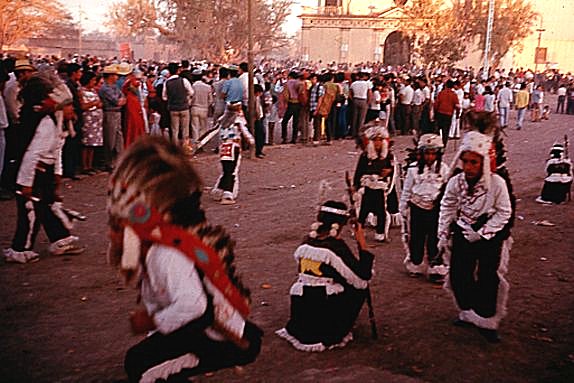 he other hand, the Sioux Indian dancing groups include a chief with full headdress and elaborate costumes for the 10 to 30 members of the dancing troups. All the dancers representing both cultures wear Chilean versions of North American Indian warrior clothing and display such paraphernelia as spears or bows and arrows. Male children, along with both male and female adults, participate as dancers in these Native North American-inspired groups, as seen in the next two photos of two children from different dancing groups (I’m not sure which child represents which group).
he other hand, the Sioux Indian dancing groups include a chief with full headdress and elaborate costumes for the 10 to 30 members of the dancing troups. All the dancers representing both cultures wear Chilean versions of North American Indian warrior clothing and display such paraphernelia as spears or bows and arrows. Male children, along with both male and female adults, participate as dancers in these Native North American-inspired groups, as seen in the next two photos of two children from different dancing groups (I’m not sure which child represents which group).
La Sociedad de Pieles Rojas (“The Society of Redskins”) and “La Sociedad Catolica de los Indios Sioux (“The Catholic Society of the Sioux Indians”) dancing groups perform to the rhythmical accompaniment of drums, such as one or marching band bass drums and three or four side drums — it is curious and noteworthy that these drums performed like North American marching band drums rather than as traditional Native North American drums (i.e., vertically rather than horizontally). A typical musical ensemble (Figure x) also includes three to five metal fifes (small horizontal flutes or pipes). Their music, emphasized by the drums, is in fast 5/4 time (one – two – three – four – five), and the fifes play a certain melodic pattern of notes that are ornamented with trills.
Several other dancing groups are called Sociedad de Arabes (“Society of Arabs”). Their costumes consist of blue and red colored silk-like baggy pants, with white shirts, red vests, and sometimes blue capes. Most impressive, as seen in the following photograph, is the brightly painted red and blue rowboat that is used to transport the Society’s version of the Virgin of Carmen. Each member of the dancing group plays a ratchet (lying on the ground in front of the dancer that is wiping his brow). The instrument, a noise-maker, is given one turn with each of the dancer’s step, which corrosponds to each beat of a bass drum. Other musical instruments are side drums, and either brass instruments or small flutes.
Another category of dancers (of which there were also many) are Gypsies. The Gypsy female dancers wear lengthy and colorful Gypsy-style dresses, while the male dancers wear light-colored trousers yellow shirts, and dark vests. All the dancers wear types of bandanas. Some of the dancers play tamborines as they dance, while others wave pieces of cloth, as seen in the following photograph. The Gypsy groups are accompanied by drums and brass instruments.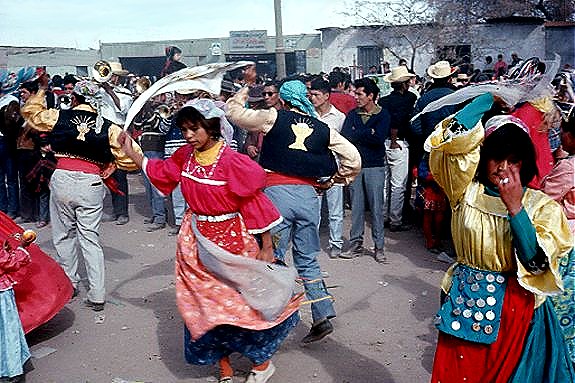
By far the most elaborate and numerous of the dancing groups are the Diabladas (“Devileds”), which is short for “deviled dancers” or devil-styled costumed dancers.” The origin of this tradition is central Bolivia, especially in the region of Oruro. Their costumes consist of elaborate masks with horns and protruding eyes. They are very colorful in their mostly red clothing, accented with other colored ornaments and red capes. The leaders are the most elaborately costumed of the dancers, but even select young children wear full devil-like attire. The following photographs (combined as mosaic) provide examples of but a few of the Diabladas that performed at La Tirana.
These Diablada groups are the most colorful of all the dancing troupes in the La Tirana patronal festival. In some of the groups all the dancers are dressed as deviled characters with masks, while in some of the other groups only the dance leaders wear Diablada costumes and masks — this often includes up to five people in costumes who dance around other members that do not wear deviled outfits. The female dancers, for example, usually wear traditional Bolivian skirts and round derby or bolo hats. The age of the dancers in the Diablada groups ranges from six or seven to perhaps forty to fifty years old.
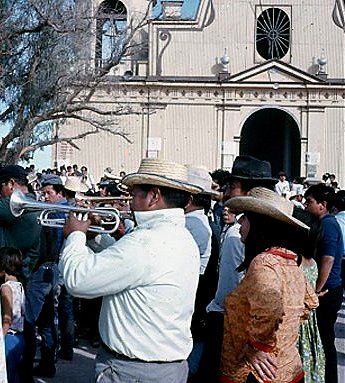 The music for the varied Diablada costumed dancing groups consists of drums and brass instruments, mostly trumpets and baritone horns. The music has a strong marching characteristic.
The music for the varied Diablada costumed dancing groups consists of drums and brass instruments, mostly trumpets and baritone horns. The music has a strong marching characteristic.
During the afternoon and evening of day one, multitudes of the faithful enter the church to pay their mandas or promises, especially by climbing the steps to the alter to be blessed by the Virgin of Carmen.  Other simply kneel and pray.
Other simply kneel and pray. Many light candles. All of those activities are seen in the following photographs.
Many light candles. All of those activities are seen in the following photographs.
Throughout most of the evening the cathedral is aglow with lights. The Sioux and other American Indian dance groups ignite the tips of their arrows and shoot them upwards; they also light bonfires around which they dance. Also in the evening many of these groups ignite special fireworks, and the eyes of many of the Diablada dancers light up, while and many other dancers wave flashlights that are covered with red cellophane or plastic. It is indeed a celebratory time that lasts late into the early morning. 
The following day the statue of the patron saint, the Virgin of Carmen, is removed from her niche in the Cathedral and is carried and paraded outside for all to see and be blessed. This is the climax of the festival.
My final photograph, taken from the bell tower of the Cathedral, captures a view of the hundreds or even thousands of spectators and participants for the final activity on the final day of the festival — the carrying and parading of the Virgin of Carmen, to be seen outdoors for the last time until next year, The Catholic priest is pictured observing the event, perhaps thinking, “well done, good and faithful servants.”
Festival of the Virgen de Guadalupe, Aiquina, Chile (September 7-8, 1968)
About a
Festival of the Virgen de Merced, Isla de Maipo, Chile (September 29, 1968)
experiences
Festival of the Virgen del Rosario, Andacollo, Chile (October 6, 1968)
experiences
Travels in 1968-1969
Peru, Brazil, and Trinidad and Tobago
December 1968 – April 1969.
After living nearly 3 years in Santiago our term of service ended and we became former Peace Corp Volunteers. We had saved up some money and chose to travel around South America for several months before returning home. On a previous trip to Brazil we had arranged jobs in Rio de Janeiro as teachers of English at the Brazilian American Cultural Center oh, so that was our destination 4 several months at least we thought.
Peru. We began our long trip home to Minnesota by flying to Arica in Northern Chile. From there we took a train over the high Andes to La Paz, Bolivia. After a few days in that very high city we continued by train to Cusco (also Cuzco) and Machu Picchu in Peru.
It was in Cusco, that beautiful former capital of the Incas, that we had our only bad experience during our entire time in South America. As our train neared its final destination in Cusco, most of the passengers got up, gathered their luggage, and stood in the aisle. There was no luggage checking system on the train, and our main suitcase was so large that we had to leave it at the end of our train car, rather than take it with us to our seats. Because there was so much commotion and congestion as people were rushing to get off the train, our suitcase was stolen within seconds of stopping. We assume that even before passengers could get off, robbers climbed aboard and stole our large suitcase; or perhaps some other passengers stole it; maybe it was prearranged. Regardless, our large suitcase contained all of our clothes, many personal items for day-to-day living, some gifts, teaching supplies, and other items. Thankfully, I had earlier removed my new Powell flute from the suitcase. What I did lose, however, were all the tape recordings that I had made while doing fieldwork at several religious folk festivals in Chile — materials that I was hoping to use for a future dissertation. Fortunately, several of our friends — former Peace Corps volunteers that we were traveling with — gave us some clothes that they didn’t need, and we survived until we could purchase replacements. On the bright side, our traveling became much easier now that we were no longer burdened by our huge suitcase. Perhaps it was a godsend.
 We had a great time in Cusco and environs, and it was the first time we had ever seen Incan ruins — in Cusco, Machu Picchu, and other sites in the sacred valley of the Incas. About ten of us former PCVs traveled together to Machu Picchu in a second-class train car (I vividly remember the third class box cars that were filled with Peruvian peasants). Hours later, when we arrived at the penultimate stop for Machu Picchu (the last stop was in the Amazon) we had to walk up the long road (called the Hiram Bingham Highway) to the ruins. In 1968, the current tourist hotel in Machu Picchu did not exist and there were no tourist accommodations. However, we were able to sleep in the ruins. There was one ruin that had a thatched-roof and hay on the floor for sleeping, and with our sleeping bags we were allowed to stay there several nights at no charge. In the photograph you see a number of us posing by the main window or entrance to the ancient Incan house that we camped in. It was a memorable and wonderful experience to wake up in the morning surrounded by mist and clouds. I had great fun playing my Peruvian kena (quena) flute each evening, as colleagues read paragraphs from Hiram Bingham’s book about his discovery of Machu Picchu. We all enjoyed our special time together thinking about Incan antiquity and what it might have been like living in Machu Picchu over 500 years ago.
We had a great time in Cusco and environs, and it was the first time we had ever seen Incan ruins — in Cusco, Machu Picchu, and other sites in the sacred valley of the Incas. About ten of us former PCVs traveled together to Machu Picchu in a second-class train car (I vividly remember the third class box cars that were filled with Peruvian peasants). Hours later, when we arrived at the penultimate stop for Machu Picchu (the last stop was in the Amazon) we had to walk up the long road (called the Hiram Bingham Highway) to the ruins. In 1968, the current tourist hotel in Machu Picchu did not exist and there were no tourist accommodations. However, we were able to sleep in the ruins. There was one ruin that had a thatched-roof and hay on the floor for sleeping, and with our sleeping bags we were allowed to stay there several nights at no charge. In the photograph you see a number of us posing by the main window or entrance to the ancient Incan house that we camped in. It was a memorable and wonderful experience to wake up in the morning surrounded by mist and clouds. I had great fun playing my Peruvian kena (quena) flute each evening, as colleagues read paragraphs from Hiram Bingham’s book about his discovery of Machu Picchu. We all enjoyed our special time together thinking about Incan antiquity and what it might have been like living in Machu Picchu over 500 years ago.
After a week or so in Lima, the capital of Peru, we flew to Iquitos in the Amazon jungle. We were still together with our travel friends and one of the things we all wanted to do was take a short cruise on the Amazon River to visit an Indian village. There were professional tours from Iquitos to Indian Villages, but they were very expensive. So we arranged our own boat trip from Iquitos by going to the floating village and finding someone to take us. We found a boatman who owned a long dugout canoe with an outboard motor and little thatched hut in its middle. He said he would take us for half of the cost of the professional cruises, and that he would also include breakfast and coffee, just like the pros. We thought that was a wonderful bargain, so we accepted and met him the next morning at sunrise — he said he had to leave very early because his boat is very slow.
As soon as we got to the middle of the Amazon River, his motor broke down and we drifted for a while until he fixed it. As he finally built up some speed, we all wanted to be at the front of the boat so we could see the scenery; however, the captain said “no, we had to sit in the cabin in the middle of the boat because the weight at the front would cause the outboard motor in the back to be lifted out of the water.” Of course, sitting in the little hut we had no view except from the doorway. We finally reached an island which was simply a shoal and got out to eat our breakfast 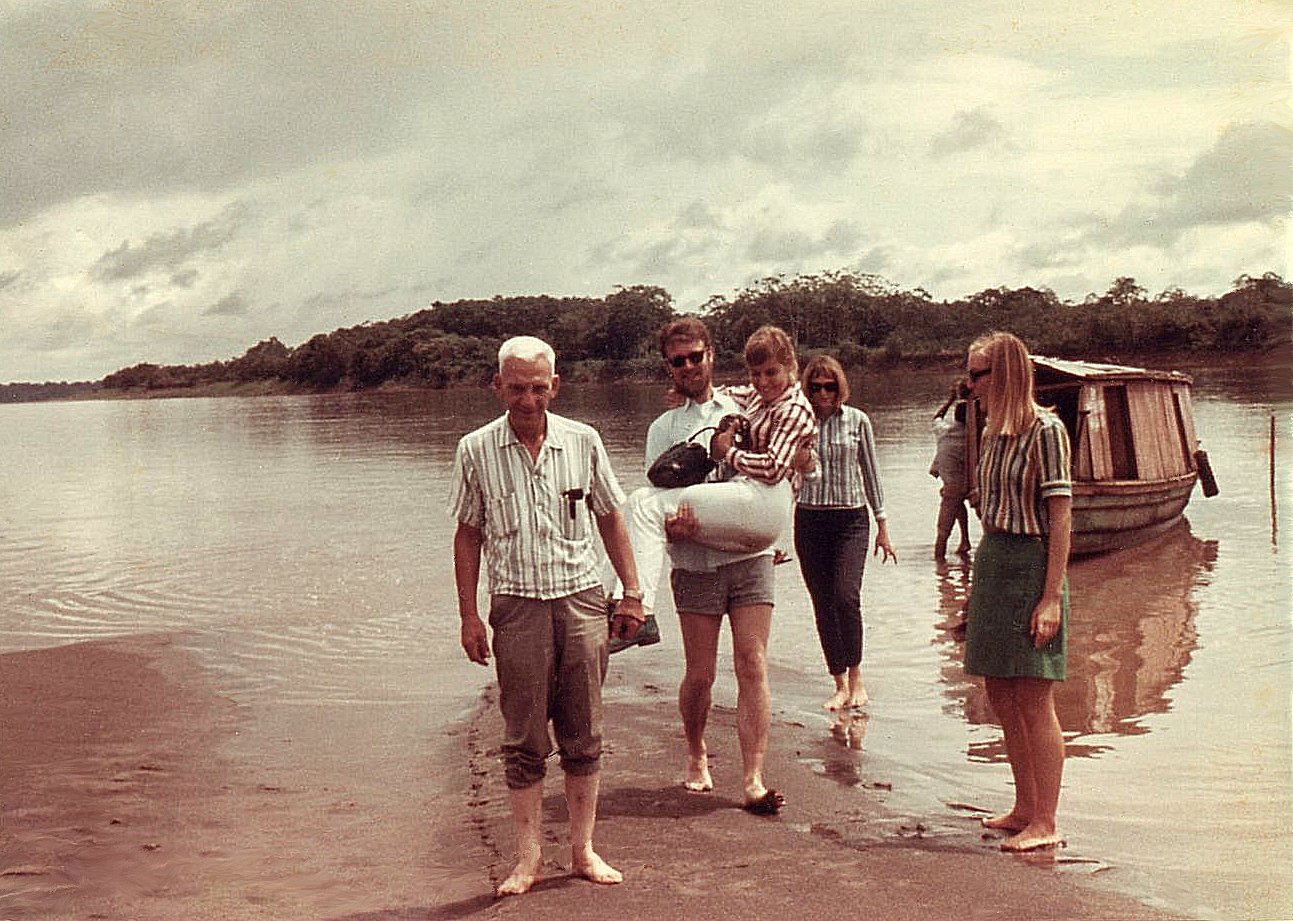 (in the photo I am carrying a PCV friend because she didn’t want to ruin her shoes; Diane is just behind me), which consisted of cold fried eggs that he brought from Iquitos and hot coffee that he made from Amazon River water. Since we were very hungry we ate his breakfast with a lot of laughing. Then the captain said, “this is as far as we can go because I don’t know the area.” “What!” we exclaimed. “What about seeing the Indian village?” He answered, “I don’t know the river beyond this point!” Fortunately, I had a detailed map and pointed out that there is an Indian village just up ahead at the fork with another river. He agreed to go on, I became the guide, and we spent a short time in a Yagua Indian village on the Napo River.
(in the photo I am carrying a PCV friend because she didn’t want to ruin her shoes; Diane is just behind me), which consisted of cold fried eggs that he brought from Iquitos and hot coffee that he made from Amazon River water. Since we were very hungry we ate his breakfast with a lot of laughing. Then the captain said, “this is as far as we can go because I don’t know the area.” “What!” we exclaimed. “What about seeing the Indian village?” He answered, “I don’t know the river beyond this point!” Fortunately, I had a detailed map and pointed out that there is an Indian village just up ahead at the fork with another river. He agreed to go on, I became the guide, and we spent a short time in a Yagua Indian village on the Napo River.
We finally made our way back to Iquitos, but it took a long time because we were traveling against the current of the Amazon River. After we disembarked, one of our PCV friends who was a law student argued with the captain that we didn’t get our money’s worth and would only pay half of what he was charging. After some discussion he agreed, we paid, and left him and his boat at the floating village in Iquitos. He was somewhat disappointed, but the interesting thing is that the next day we saw him walking and he offered to take us on another trip. We had a good laugh about that as we politely turned him down.
Brazil. We said goodbye to our PCV friends, and Diane and I made our way hitching a ride on a small Greek cargo boat heading to the last Peruvian outport on the Amazon River where Peru, Brazil, and Colombia meet. When we arrived, we went by canoe (the local ferry) across the Amazon River from Peru to Tabatinga, a small Brazilian port with an airport. There we caught a flight to Manaus, Brazil, making one stop in an Amazonian rainforest village to unload some unknown cargo and give us a few hours to walk the muddy red clay road and explore the area (see my photo of Diane walking in her orange dress — uma gringa bela, I’m sure the Brazilian men were thinking).  About the only detail I remember of the this experience is how the pilot had to buzz over the airfield before landing to scare the pigs off the dirt runway — those were indeed adventurous days!
About the only detail I remember of the this experience is how the pilot had to buzz over the airfield before landing to scare the pigs off the dirt runway — those were indeed adventurous days!
After several hours we landed in the Manaus of 1969 (New Year’s Eve happened while we were aboard the Greek cargo boat, I seem to recall) where we stayed for a week, more or less. At that time Manaus was not a modern Amazonian metropolis like it is today in the 21st century. 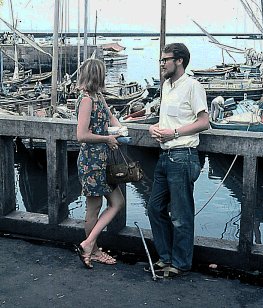 Rather, it was a dirty port town of substantial squalor, with a huge floating village on the Amazon River and many old run-down city buildings. However, it still exhibited many reminders of its glorious past during the rubber boom, when it an was built by wealthy European entrepreneurs as an important port at the junction of the Amazon and Rio Negro Rivers. In this photo we are standing by the harbor, enjoying the river ships and boats of all shapes and sizes.
Rather, it was a dirty port town of substantial squalor, with a huge floating village on the Amazon River and many old run-down city buildings. However, it still exhibited many reminders of its glorious past during the rubber boom, when it an was built by wealthy European entrepreneurs as an important port at the junction of the Amazon and Rio Negro Rivers. In this photo we are standing by the harbor, enjoying the river ships and boats of all shapes and sizes.
During its heyday, the European rubber barons enjoyed European opera, and they constructed an opera house called Teatro Amazonas in 1896 and invited European opera singers to perform. It went into disuse when the trade in rubber ended in the early 1900s, and it was closed in 1924. It was named a World Heritage Site in 1980 and reopened in 1996 after years of reconstruction. When we visited Manaus, the famous Opera Theater was still in a state of disuse. Nevertheless, it remained a majestic structure, as seen in this photo. 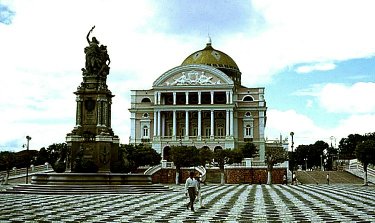
Travels in 1970
Summer in Mexico
June-August 1970
Shortly after our return from three years in South America, Diane and I moved to the Chicago area in the summer of 1969. I landed a great summer job playing second flute in the Grant Park Symphony Orchestra, and Diane worked as a computer programmer for Northwest Railroad. In late August I accepted a position as assistant professor at a college in Arkansas as flute instructor and Diane was unemployed; at several job interviews she was asked, “Why do you want a job? Doesn’t your husband work at the college?). That inspired her to seek a grant to go to graduate school, and before long she was awarded a National Science Foundation grant to study Latin American Studies at UCLA. She said to me, “I’m going to UCLA for my masters this fall. You had better apply to their music program if you want to come along.” Apply I did, and accepted I was–into the UCLA musicology program to study Latin American music. We both decided right then and there to resign from my position at the end of the spring quarter, leave Arkansas, and spend the summer in Mexico. That endeavor had two important benefits: we could save money and we could learn about Mexican culture, history, literature, archaeology, anthropology, music, and more. We loaded up a U-Haul trailer and drove–with our cat and Diane pregnant–to Brownsville, Texas. There we left our trailer filled with all of our belongings (including our dear cat, Canela) with one of my former students, and continued driving our 1960 Ford to Mexico City. We lived with the neighbor of a friend of Diane’s parents, and we alternated weeks by studying at the Benjamin Franklin American Culture Center and traveling in our car to a number of places in Mexico (our travel goal was to visit every archaeological site in central Mexico). The following travel snapshot will highlight some of our explorations, as best as we can remember 51 years ago.
Mexico City, Tenochtitlan, Teotihuacan,
Puebla and Chalupa
Michoacán: Sierra Nevada de Toluca, Playa Azul
Tsintsuntsan: Patzcuaro, San Miguel, Tula
Cuernavaca and San Miguel de Allende
Taxco
Oaxaca
Palenque
Progresso
Chichen Itza
Uxmal
Isla Mujeres
Travels in 1972, 1973, and 1974
The Delta Amacuro Rainforest of Venezuela
These travel tales and snapshots are personal stories derived from my many months over several years of fieldwork with the Warao Indians of Venezuela. Currently, a long essay with photos and audio files titled “Ethnomusicology as Advocacy…” already exists on this website. Therefore, I will not add other Warao stories here, although I may include a few rainforest adventures not included elsewhere.
June-August, 1972
March 16-30, 1973
June, 1974
Travels in 1973
Japan
June-August, 1973
Diane, 2 1/2 year old son Darin, and I went to Japan during the summers of 1973, upon my graduation from UCLA. We lived in the Tenri Kyo Overseas Mission Headquarters in Tenri, Nara province, Japan, as guests of my shakuhachi teacher, Mitsuru Yuge. We spent a lot of time in Nara and Kyoto. We attended the Gion Matsuri (festival) in Kyoto.
Travels in 1974
Venezuela, Colombia, and Peru
dates, 1974
Fieldwork travel experiences as an NEH grantee.
Venezuela. Back to the Orinoco Delta. Attending the Festival of San Juan in xxx. 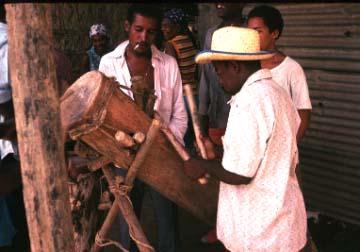
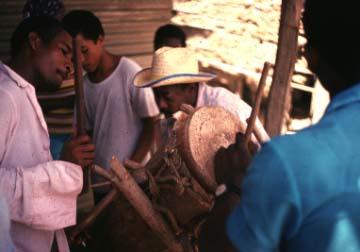
Colombia
Peru
Travels in 1979
Peru
May 21-September 15, 1979
For four months I lived in Peru as a Fulbright Fellow, teaching in Lima and conducting fieldwork in various regions of the Peruvian Andes. Diane and our 8 year-old son, Darin, joined me for a month from July 12 to August 14.
Several of my fieldwork research excursions were to attend religious folk festivals in the Peruvian Andes. Andean Catholicism, or “folk Catholicism,” is the syncretic blending of ancient pre-Spanish religious traditions with Spanish Catholic traditions into something new. In the Andes, pre-Catholic fertility, harvest, and other indigenous rituals have fused with Catholic calendrical and patron saint celebrations. The results are combinations of both, although the degrees of syncretism cannot be effectively measured.
Virgen of Carmen Festival. One of the patronal festivals I researched was the celebration of the Virgin of Carmen in the very small community of Alto Otuzco, Cajamarca, in the northern Peruvian Andes. Carmen is the female patron saint (personified as the Holy Virgin) of many communities in Peru. Her celebration is July 16, which occurs in the Quechua month of Anta Situa (Earthly Purification), making it a folk Catholic version of a cleansing ritual. Thus, an obvious religious syncretism is observed. I attended this celebration in 1979, when the entire festival was run by the villagers themselves, because the parish priest became bored and left, according to the villagers I talked with. The music for this festival was performed by two kinds of aerophones, called clarín and flauta y caja.
The clarín is a side-blown bamboo tube “trumpet” measuring from nine to eleven feet in length with a metal cone bell on its distal end. It is pictured here to the left being held vertically, but not played. The musician is taking a break from playing his clarín as he stands in front of the local church. This instrument may have its origins in ancient Peru, because clay trumpets were used by the Moche on the northern coast of Peru. The fact that the clarín is side-blown rather than end-blown, however, makes it unique.
 The flauta y caja (flute and drum) pictured here to the right is similar to the Spanish pipe-and-tabor, where one musician plays both a vertical fipple flute and a drum at the same time (like a one-man-band). This combination was common in the European Renaissance, and the technique was probably brought to Peru (and Mexico) by the Spanish. The very large size of the bass drum is unique to Peru. Several pre-Columbian Peruvian cultures, however, played panpipes and large drums at the same time, so the one-man-band idea was known and practiced since antiquity. The tradition was more common in southern Peru in the vicinity of Lake Titicaca, than in the north of the country.
The flauta y caja (flute and drum) pictured here to the right is similar to the Spanish pipe-and-tabor, where one musician plays both a vertical fipple flute and a drum at the same time (like a one-man-band). This combination was common in the European Renaissance, and the technique was probably brought to Peru (and Mexico) by the Spanish. The very large size of the bass drum is unique to Peru. Several pre-Columbian Peruvian cultures, however, played panpipes and large drums at the same time, so the one-man-band idea was known and practiced since antiquity. The tradition was more common in southern Peru in the vicinity of Lake Titicaca, than in the north of the country.
Saint John the Baptist Festival. Another religious folk festival that I researched was San Juan Bautista (St. John the Baptist), which took place in the small village of Acolla in the northern Mantaro Valley region of central Peru.
Details of and Experiences at the 1979 Patronal Festival of San Juan Bautista. My observations of and participation in the patronal folk festival of San Juan Bautista were centered almost exclusively around one orchestra for three days, from June 23rd through June 25th, 1979. Unlike other patronal festivals I attended, such as the Virgin of Carmen in Cajamarca, Cajamarca, and Santa Rosa in Yungay, Ancash, the festival of St. John the Baptist in Acolla, Junín, revolves more around numerous cofradías (brotherhoods, fraternities, or societies) that are made up of important families and their guests. There is a great feeling of competition among these fraternal organizations, especially visible when their members process around the main plaza or town square on Sunday afternoon with their hired orchestras or bands. During these processions, and in fact during the entire patronal folk festival, there is no display of the patron saint and no participation of the Church, except for a Sunday morning mass in honor of St. John the Baptist. The rest of the festival revolves around the people and their brotherhoods.
The San Juan Bautista patronal folk festival begins with the víspera (‘vespers’) on the evening or June 23rd. This is the part or the festival that displays the most pre-Christian elements, and is the only real non-Catholic and perhaps Quechua part of the week-long events. Juan de la Cruz and I arrived in Acolla on June 21, two days before vespers. Juan stayed with his sister in her small and very rustic adobe house, and I stayed with his niece and nephew, María de la Cruz and her husband Macario Castro Álvarez, and their six children, in an equally small adobe house. The children gave me their room, where I placed my sleeping bag on top of their rustic bed, which was basically a rectangular pile of hay. I wrote the following impressions in my fieldnotes shortly after a nice meal of oca, maskua, palpita blanca, otongo, and dulce de quínoa with my new Peruvian family: It’s very cold here. I’m shivering as I write my notes by candle light. Nevertheless, it’s great being here with Maria de la Cruz and Macario Castro. There is a wind shooting through my room, however, and I wish I had my long underwear. It’s 8:15 PM now, and I’ve heard only one waqra pukru (cowhorn trumpet). Tonight is visperas for the fiesta of San Juan Bautista. I love the type of Spanish spoken here. The “s” is pronounced in a unique manner: the word “mientras” (‘meanwhile’), for example, sounds like “mients” or “mientrs.” María’s and Macario’s six children call me “mi tio” (‘my uncle’). I love them! I can tell this is a great Christian family, and so are Juan de la Cruz and his sister. She lives in really poor conditions, yet she said “mi casa es pobre, pero mi corazón es grande” (‘my house is poor, but my heart is large’)—she’s a wonderful Christian person, filled with charity and love.
I should add to this last impression that all of Juan de la Cruz’s relatives are devout Catholics, and the patronal festival of Saint John the Baptist has important Catholic meaning for them, as well as traditional Quechua significance. For many days prior to the vespers, for example, the Castros and other Quechua-derived families in Acolla gather their oldest clothes, and each family makes a life-sized scarecrow that is dressed and stuffed with the old belongings. It is believed that the old clothes that lay around day after day collect evil; the clothes, in an anthropomorphic form of a scarecrow, are then burned, an act that sends off the evil spirits dwelling in the clothes into the cosmos. The pre-Christian belief, therefore, is one of cleansing, and the cleansing bonfires symbolize the rebirth or the sun (Ibid.). At about 8:30 on the evening of the 23rd of June, under a clear and cold winter Acolla sky (about 95% of the village has no electricity), fires could be seen burning in every direction, as I wrote in my fieldnotes at 11:15 PM, after witnessing several vespers events: I’m so cold that it is hard writing this. My hands are the coldest. I’m saying this to remind me about Peruvian winters in the Andes. Acolla is about 3000 meters or more above sea level, and compared to Minnesota where I grew up, this is nothing. So much for my discomfort—live with it! Maria and the kids were burning their scarecrow earlier tonight, and fires were burning all around the valley. We all warmed ourselves by their fire. It’s amazing how they let their children play in the fires. The girls, for example, burn the tips of their braids of hair to make the hair grow. Later, Macario, two of his older children, and I went to the main plaza where a huge doll was burning and rockets were being shot off. From there we could also see fires burning in all directions. We could also hear brass band music and the sound of a wakra pukru being blown, accompanied by a tinya drum.
The ritual behavior during vespers was explained to me as being indigenous, but other sources describe nearly identical characteristics in pre-Christian (some call it pagan) Europe, as explained by Catholic scholars:3 “All over Europe, from Scandinavia to Spain, and from Ireland to Russia, Saint John’s Day festivities are closely associated with the ancient nature lore of the great summer festival of pre-Christian times. Fires are lighted on mountains and hilltops on the eve of his feast. These Saint John’s fires burn brightly and quietly along the fiords of Norway, on the peaks of the Alps, on the slopes of the Pyrenees, and on the mountains of Spain (where they are called Hogueras). They were an ancient symbol of the warmth and light of the sun which the forefathers greeted at the beginning of summer. In many places, great celebrations are held with dances, games, and outdoor meals.”
“Fishermen from Brittany keep this custom even while far out at sea in the Arctic Ocean. They hoist a barrel filled with castoff clothing to the tip of the mainsail yard and set the contents on fire. All ships of the fishing fleet light up at the same time, about eight o’clock in the evening. The men gather around the mast, pray and sing. Afterward they celebrate in their quarters, and the captain gives each crew member double pay.”
“Another custom is that of lighting many small fires in the valleys and plains. People gather around, jump through the flames, and sing traditional songs in praise of the saint or of summer. This custom is based on the pre-Christian “need fires” (niedfyr, nodfyr) which were believed to cleanse, cure, and immunize people from all kinds of disease, curses, and dangers. In Spain these smaller fires (fogatas) are lighted in the streets of towns and cities, everybody contributing some old furniture or other wood, while children jump over the flames. In Brest, France, the bonfires are replaced by lighted torches which people throw in the air. In other districts of France they cover wagon wheels with straw, then set them on fire with a blessed candle and roll them down the hill slopes.”
In contrast to the solitude and almost magical transfixation of each fire on the evening of June 23, 1979, a rock band was warming up their amps in the municipal coliseum located on a corner opposite the town square (where there is electricity). At a little after 10:00 PM two electric guitars, electric bass, electric piano, and drum set opened with a rock or chicha (Peruvian popular music of the 1970s and ‘80s) version of the wayno from “El Cóndor Pasa.” Many of the youth of Acolla stayed to “do the Travolta”—which they call modern disco-styled dancing—until 5:00 AM the following morning. It was a good band, and the young people filed in, although their dancing seemed to be slowed down by the cold. I left around 10:45 with my Peruvian family; it was getting late and the major celebrations were to begin early the next day. I wrote a few more lines about 11:30 PM, ending with “I’m going to bed because I’m freezing!” At 7:40 AM I awoke and wrote the following: I slept very well and I was warm inside my sleeping bag with all my clothes on (shirt, sweater, sweat shirt, ski jacket) and four blankets over me. After 8 AM a few rockets went off and a marching band began to play. I had breakfast and then went for a walk, following the band. They were marching—walking, actually—to a school or the stadium. From there they processed to and through the main plaza, playing four or five waynos in succession. Dressed in light blue suits, they were led by four men in brown suits, with one drunk man keeping time. The instrumentation of the band included five baritones, one valve trombone, one sousaphone, five trumpets, three clarinets, a bass drum, and several snare drums. According to Mecario, this was the local military band.
The family cofradía celebrations begin in earnest on Sunday following the vespers and last for six days. Much time is spent on Sunday morning and subsequent mornings with the preparation of food, because large noon feasts are held Sunday and throughout the coming week at the houses of certain members of the society. The term “brotherhood” is certainly a meaningful translation for the term “cofradía,” because this is truly a man’s world. The only women who take part are the hostesses or wives of certain important men. These handful of women do not drink but they will dance with the men, although it is very common to see the men dancing by themselves with only their canes or bastones as partners. With his bastón in his right hand and his left hand on his left hip, each male dancer makes a stately sight, perhaps reminiscent of ancient days when Amerindian village leaders used their varayoc or royal staves as symbols of authority (Dobyns and Doughty 1976:93-94).
Don Juan found me on the Sunday morning of July 24, 1979, and we went together to the Plaza La Libertad, several blocks from the central plaza. There we met the orchestra Selección del Centro that was hired to play for the cofradía de Pacarina, which included several of our friends from Lima, notably Tomás Palacios on saxophone and others, and Narciso Blanco on harp, the best harpist in Acolla and professor of arpa indigena in the local school of music. On this early Sunday morning, the orchestra was incomplete, consisting of one alto saxophone, two tenor saxophones, three clarinets, three violins, and one harp. Soon, after the 10 o’clock mass, the orchestra was expanded with the addition of several more saxophones. Also, after the mass the participants, guests, and musicians processed to the house where the feast was held, and the drinking and dancing within the house’s patio walls began.
On this early Sunday morning, the orchestra was incomplete, consisting of one alto saxophone, two tenor saxophones, three clarinets, three violins, and one harp. Soon, after the 10 o’clock mass, the orchestra was expanded with the addition of several more saxophones. Also, after the mass the participants, guests, and musicians processed to the house where the feast was held, and the drinking and dancing within the house’s patio walls began.
During the hour prior to the Sunday noon lunch on the main day of the patronal festival of St. John the Baptist, just after the mass when the icon of St. John the Baptist is honored and the congregation enjoys its forgiveness for their sins the evening before, many participants and guests sing, dance, drink beer, and engage in conversation and people watching, all to the accompaniment of the music of the hired typical orchestra. As I was taking pictures of the events, the president of the cofradía of Pacarina asked me to buy a case of beer (liter-sized bottles) for his family, guests, and the musicians, which I happily agreed to. This is what I wrote in my fieldnotes about the experience (June 24, 1979, 6:15 PM): The custom in Peru is to take a glassful of beer and pass the bottle on to someone else, say “salud” (‘health’ or ‘cheers’), drink the beer, shake out the last drops of beer and foam, give the empty glass to the person you gave the bottle to, and say “sírvese” (‘serve yourself’). Then I committed a gringo faux pas, which created more laughter than resentment. When I was given my glass, poured and drank my beer, and was handed the large bottle of beer, I unknowingly poured beer into the glass for the man next to me, gave it to him and said “salud.” The faux pas is that the man who just drank the beer must give an empty glass to the man next to him; a full glass is passed on only to a woman! I had thus treated the man next to me as one would treat a woman. There were no hard feelings, but I was pretty embarrassed. Stupid gringo!
Lunch began about noon, and I couldn’t resist writing the following impressions about the types of food and the general ambiance of the large room just inside the large adobe house next to the central open-air patio where the music and dancing take place: For lunch, Don Juan and I sat at the main table and feasted. We started with a salad of potatoes covered with a mayonnaise sauce. The center of the table was filled with piles of little round potatoes which, I learned, are to be eaten by peeling each potato with your thumb nail and throwing the peelings on the dirt floor where numerous guinea pigs scurry around to have their own feast. After the potatoes we were served a soup with quinoa and meat, perhaps chicken. Then came a large plate of rice, lamb, more potatoes, and carrots. No desert was included, except for glasses of chicha (corn beer), which I passed up.
After this typical central Andean feast, speeches were given by the next year’s person who will host next year’s lunch, as I wrote: Then Don Juan stood up and gave such a touching speech that it brought tears to my eyes. As he talked, he was also choked with emotion. Juan spoke about the value of Acolla’s folk music and folklore, about which he knows a lot because he is director of the National School of Folkloric Arts in Lima, and because he was born in Acolla on July 18, 1910. He is a dear old man, and I think this particular festival is really a good experience for him. He hasn’t attended the San Juan Bautista festival for many years, and hasn’t seen his sister for five years.
After the speeches the music and dancing continued, followed by a procession to the Plaza La Libertad where the orchestras, bands, and dancing groups perform as if in competition. As the days progress, the afternoon dancing in the various plazas becomes very colorful because the dancers don very elaborate costumes. 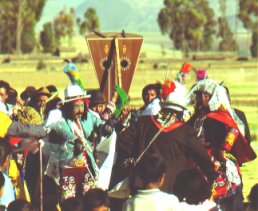 Although it is seemingly a man’s world, some of the men dress in costumes that make them resemble women, including wear hats made from peacock feathers, embroidered scarves, and other fancy attire. Other men wear costumes representing old men and even animals. The most elaborate are the tunantadas or chunginos, male dancers representing Spanish nobility.
Although it is seemingly a man’s world, some of the men dress in costumes that make them resemble women, including wear hats made from peacock feathers, embroidered scarves, and other fancy attire. Other men wear costumes representing old men and even animals. The most elaborate are the tunantadas or chunginos, male dancers representing Spanish nobility.
Travels in 1981
Peru and Brazil
May 27-June 8, 1981
I returned to Lima, Peru for about two weeks to continue my fieldwork with Japanese-Peruvian musicians. On June 9, I flew to Sao Paul, Brazil, to begin fieldwork with Japanese-Brazilian musicians. On July 26 Diane and Darin arrived and we toured various regions of Brazil, including Iguazu Falls and Rio de Janeiro. They accompanied me to various musical performances and gatherings in Sao Paulo as well. We returned to Florida on August 30.
Travels in 1985
European Adventure: England, Sweden, Finland, Norway, Denmark, Germany, France, and Spain
July 21-September 2, 1985
Fly from Orlando to Manchester, England; car rental to tour Buxton, Stratford-upon-Avon, central England (July 22-27); train to Newcastle on Tyne and Danish Seaways Ferry to Goteborg, Sweden (July 28-29); Stockholm with Karin Sharma (July 29-August 7): attend ICTM in Stockholm and Helsinki, Finland; Purchase 1982 Volvo diesel 240 in Stockholm; drive to Oslo and close to Bergen, Norway (August 9-11); drive to Denmark, visiting Copenhagen, Arhus, Skagen (August 12-14); drive in Germany, Mosel and Rhine River regions (Aug. 15-17); drive to Paris, Chartre, Pontiers, Anguoleme, France (Aug. 18-22); drive to Burgos, Madrid, Avila, Cordoba, Andalusia, Barcelona, Spain (Aug. 23-28); drive through France to Florence, Italy (Aug. 29-Sept. 2).
Travels in 1985-1986
Italy: Teaching with the FSU Florence Program, and Homeward
September 2, 1985-January 3, 1986
Teaching, Exploring, Skiing, and Researching in Italy (Fall Semester at the FSU Florence Overseas Study Center). Fall semester teaching from September 9-December 11 while living in Florence; field trips with faculty and students: Sienna and San Gimignano, Rome; Etruscan research trips and other tours with Diane and Darin: Tuscan hill towns, Oviedo, Tarquinia, Milan and Lake Como, Bologna and Venice, Elba, Pisa, Lugano, skiing in Cortina d’Ampezzo, etc.; drive to and stay in Paris (Dec. 19-26); drive to Antwerp, Belgium to leave Volvo for shipping to Florida (Dec. 27-28); train to and stay in London (Dec. 28-Jan. 3); fly to Tallahassee (Jan. 3, 1986).
Travels in 1987
The Netherlands, Germany, etc.: Research and ICTM Music Archaelogy Study Group Conference
dates, 1987
experiences
Travels in 1989
Germany, Switzerland, and Austria: Research and ICTM Conference
July 1-August 19, 1989
Itinerary: July 1 drive to Tampa; July 2 arrive Frankfort, West Germany, to Dusseldorf; July 3-4 Koln; July 5-6 Hannover; July 7-10 West Berlin; July 11 East Berlin; Jully 12-13 Nurenberg; July 14-17 Frankfort, Diane and Darin (with his bicycle) arrive on 16th; July 18 Augsburg; July 19-21 Munich; July 22 St. Morintz Switzerland, Darin at windsurfing camp for one week at Lake Silvaplana; July 23-29 Schladming, Austria for ICTM to give paper; July 30 Schaffhausen, Switzerland (Darin begins bike tour across Switzerland for two weeks); July 31-August 4 Vienna, Austria; August 5-11 Prague, Czechoslovakia; August 12 Vienna; August 13 Schaffhausen, Switzerland to pick up Darin; August 14-18 Zurich, Bern, Gasel Switzerland; August 19 fly from Frankfort to Tampa, drive to Tallahassee.
Travels in 1993
Hong Kong, People’s Republic of China, Korea
dates, 1993
I had a sabbatical for the Fall semester of 1993, and I had invitations to give lectures in Hong Kong and Beijing in November. Diane and I left for Hong Kong on October 28 and spent two weeks in Hong Kong, living with Joshua and Ruth Wong.
On November 11 we flew to Guilin in the People’s Republic of China
Then we flew to Beijing on November 14.
On November 20 we flew to Shanghai, and on the 21st we flew to Seoul, Korea where we stayed until the 29th.
Travels in 1998
Puerto Rico: CMS Conference Planning and Spring Break.
March 5-12, 1998
We flew to Puerto Rico. Stayed in …
Tonga, New Zealand, Rarotonga, Fiji, Hawaii: Research and Celebration
June 21-July 29, 1998
Tonga. We flew from Tallahassee to Los Angeles, to Oahu, and then to Tongatapu Airport in Nuku’alofa, the capital of the Kingdom of Tonga, where we stayed for over two weeks as invited guests for the King of Tonga’s 80th birthday (see the photo of our invitation from the Prime Minister of Tonga). I also had a grant from FSU to research Tongan traditional music and dance during that gala celebration.
I also had a grant from FSU to research Tongan traditional music and dance during that gala celebration.
One of the highlights of our 15 days in Tonga was attending the Methodist Church where King Taufa’ahau Tupou IV gave the sermon (see photo of the King) and the huge choir sang resounding hymns in a unique Tongan polyphonic style. The first missionaries to Tonga were Methodists, and their hymn musical influence fused with traditional Tongan choral music to create a unique form of Christian musical syncretism for which Tonga is particularly famous. 
The majority of the traditional music of Tonga is choral, either acapella or accompanied by huge drums. In both cases it is exciting group dance music, not for the public, but by well-trained from competing villages. Best known is lakalaka, seen in this picture of a large double line of singers/dancers. The lakalaka style is performed by a large chorus of female dancers on one end of a long line and male dancers on the other. Their dancing styles could not more different: the women’s dancing is graceful and the men’s is boisterous and somewhat frightening by comparison. 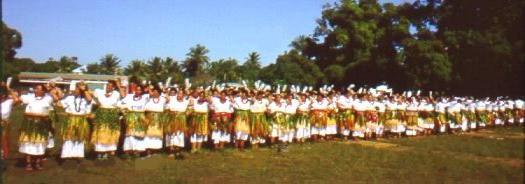
During our extended two week stay in the capital of Tonga we not only experienced the excitement of the King’s birthday celebrations, which lasted nearly a week, but I also gave a lecture at the national school of music. I spoke in general about my discipline, ethnomusicology. How interesting it was when I defined ethnomusicology as “the cultural study of any and all music.” But first I defined music as “humanly-produced organized sound capable of communication, excluding Morse Code.” That definition inspired much debate because the Tongan musicians claimed that the definition of music must also include sounds made by whales. I responded by arguing that we cannot assume that whale sounds are music until we discuss the sound phenomenon with the whales themselves. To assume that whale sounds are music, I maintained, is to be “species-centric,” that is, to use the concept of one species (i.e., humans) to understand the concept of another species (i.e., whales).
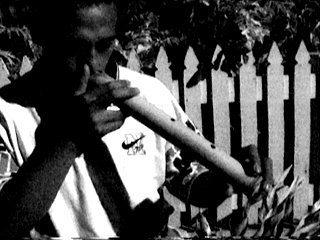 As a flutist, I also took a great interest in a traditional Tongan flute known as fango-fango, a bamboo nose flute (see photo). The fango-fango is played with nose breath rather than mouth breath, and consequently, its sound is very soft. For that reason, perhaps, its only function was to produce soft music to awaken the King every morning. Unfortunately, the fango-fango was no longer found as a surviving traditional musical instrument in Tonga in 2005. However, a young man who was studying at Bingham Young University in Hawaii had revived the instrument, and he was home in Tonga for the King’s 80th birthday. Fortunately, he taught me how to play the instrument and gave me one, which I have used many times when teaching about the music of Tonga at FSU.
As a flutist, I also took a great interest in a traditional Tongan flute known as fango-fango, a bamboo nose flute (see photo). The fango-fango is played with nose breath rather than mouth breath, and consequently, its sound is very soft. For that reason, perhaps, its only function was to produce soft music to awaken the King every morning. Unfortunately, the fango-fango was no longer found as a surviving traditional musical instrument in Tonga in 2005. However, a young man who was studying at Bingham Young University in Hawaii had revived the instrument, and he was home in Tonga for the King’s 80th birthday. Fortunately, he taught me how to play the instrument and gave me one, which I have used many times when teaching about the music of Tonga at FSU.
Many other musical events occurred during the King’s birthday celebration, such as performances by the royal and other singing brass bands. They have that name because after playing a song’s melody once or twice on their trumpets and other brass instruments, the entire band then sings several stanzas. They alternate this practice for the duration of each song. The songs are usually marches, although one of the songs was “The Macarera,” which included “hand and arm dancing,” I call it. Other instrumental music during the celebration included many pop music combos, and they were part of a competition during the evening hours. Another interesting contest was a drag competition, which was exclusively men in drag. There was an enjoyably comical element to the event, and the large crowd of Tongans particularly had a happy time. In Tonga there seems to be no discrimination to men in drag.
trumpets and other brass instruments, the entire band then sings several stanzas. They alternate this practice for the duration of each song. The songs are usually marches, although one of the songs was “The Macarera,” which included “hand and arm dancing,” I call it. Other instrumental music during the celebration included many pop music combos, and they were part of a competition during the evening hours. Another interesting contest was a drag competition, which was exclusively men in drag. There was an enjoyably comical element to the event, and the large crowd of Tongans particularly had a happy time. In Tonga there seems to be no discrimination to men in drag.
Diane and I also traveled around the main island of Tongatapu, visiting beaches and rocky shores famous for their blowholes. One day we took a daytrip by boat to the small Tongan island of Faja where we swam and hiked. Finally, we made some wonderful friends, visitors from South Africa who were sailing around the world, tourists from Denmark and Germany, Australian and British visitors, some who were judges for the popular music competitions, and others. We owe so much to the late Jehan Fisk, an anthopology and art professor at FSU whose specialty was the art of Polynesia and especially Tonga. She alone made it possible for us to have a personal and special royal invitation to this wonderful celebration.
New Zealand. After Tonga we flew to Aukland, New Zealand, where we learned about Maori music and education in Rotorua.
Rarotonga. We then flew to Rarotonga, a small South Pacific Island,where we stayed 4 nights.
Fiji. Then we flew to Fiji and spent a week on the island of Taveuni.
Hawai. Then we flew to Hawaii, spending a week in Hilo and Honolulu.
Puerto Rico: CMS Annual Conference
October 21 – 26, 1998
We flew
Travels in 1999
Japan: CMS International Conference Fun and More
dates, 1999
Not until the summer of 1999 did we have the opportunity to visit Japan again, this time to attend the 1999 College Music society International Conference in Kyoto. It was a much different experience than in 1973, when I was a recent PhD graduate; 26 years later I was President of The College Music Society and I had an important role with the daily Conference activities. My goals in Japan were to (1) attend and give a paper at the CMS International Conference; (2) to research music on Sado Island and among the Ainu in Hokkaido; (3) to meet with Japanese musician friends in Tokyo and perform in concert with them; and (4) to visit sites around Tokyo that I had not visited before.
We left Tallahassee on June 24 and flew to Portland, OR, and after several hours flew overnight to Nagoya, Japan. From there we took the bullet train to Kyoto, where we stayed in a quaint ryokan from June 25 until July 4. The experiences each day during the Conference were very educational and busy. It was after the Conference, however, that were more enjoyable because we were able to make our own itinerary and visit new places for us.
We bought Japanese rail passes and first traveled west from Kyoto to Kanazawa where we spent three nights (July 5-7). Then we traveled north to Ogi, Sado Island, where we spent two nights (July 8-10); next to Hirosaki (July 11-12); then to Sapporo in Hokkaido (July 13-16); then back to Honshu, staying overnight in Morioka (July 17); and finally to Tokyo where we stayed four nights (July 18-21). On July 22 we returned to the USA, arriving in Tallahassee late that night and very tired.
Travels in 2001
Ireland: CMS International Conference and travels with friends
July — August , 2001
During the summer
Travels in 2002
Vietnam I: Teaching with and Directing the FSU Vietnam Program
May 10-August 1, 2002
During the summers I had the privilege to direct and teach in Ho Chi Minh City (HCMC) with the FSU Vietnam Program. Diane and I left Tallahassee for Ho Chi Minh City, Vietnam, at 3:30 PM on May 10, flying to Atlanta, San Francisco, Hong Kong, and finally arriving in HCMC on May 12 at 9:15 AM. Our lodging was in Equatorial Hotel, which was also the site for the FSU classes and student housing. For two weeks all of the students, faculty, and spouses toured many regions in Vietnam, including the following: Saigon (the Vietnamese still call it that) full day city tour; full day tour of Cao Dai Holy Temple and the Cu Chi tunnels; three days and two nights in Da Nang, Hoi An, and Hue; full day tour to My Tho and the Mekong Delta. Diane left HCMC on May 25 for her return flight to Tallahassee, and I stayed in the Equatorial Hotel until the end of the summer session (June 21). For the next month and a half (June 21-August 1) I conducted research in Ho Chi Minh City on Vietnamese popular music. I finally arrived home on August 2.
Travels in 2003
Costa Rica: The CMS International Conference and beyond
June x-July 11, 2003
We had the . . . CMS International Conference, followed by several weeks post conference activities.
I just came across a small notebook that I used to write some sparse field notes/diary. I copy those notes here and will either delete or use them later.
6-27-2003. We went to a great flamenco concert tonight at the Teatro Nacional. We loved it! Then we had dinner at Don Carlos Hotel.
6-28-03. Several us us CMS members and Diane had dinner and spent the evening at Centro Comercial San Pedro, Cocina de la Lena, with a marimba duo. We shopped and spent $$.
6-29-03. Di left this Sunday morning. I went to mass at the main Cathedral. The priest was a terrible singer.
6-29-03. 5:00 PM. It was difficult to see Di leave today. I got a city bus back to San Jose and walked from La Merced station, getting a feel for the city. I checked in to Diana’s Inn about 11:00, read and slept until 2:00, then walked in the area. It began to rain hard, but I was sitting in the park across from Diana’s Inn. I went to my room and waited until now to find a restaurant. It’s raining again as I wait for my 1/4 pollo supper — I have my umbrella this time. I hope all goes well here in San Jose. I miss the Don Carlos Hotel with all its neat little places to sit and all its art. The Diana’s Inn is a 0 star hotel, but it’s cheap, close, and the people are nice — also, it’s clean and safe. I started reading a book titled The Shaman’s Gold. The author interprets the gold artifacts of Costa Rica as a part of the “cosmo-vision indigena” — makes sense.
6-30-03. Met Laura Cervantes Gamboa at Universidad de Costa Rico.
7-1-03. Met Ani Baez for lunch at CCCN.
7-2-03. Terribly noisy this PM and early AM because of an inconsiderate guy with a loud motorbike.
7-04-03. Celebrated 4th of July with FSU International Programs group at Imperial Beer Grounds 8-12 AM. I had a great Sun Burst coffee, many hotdogs without buns, ice cream. Concert band from UCR played.
7-05-03. Went to Centro Neo-tropical Sarapiqui with George and Cristina. Met Jorge Luis Acevedo and Ron Mills, who painted those awful murals at UCR. Met Michael, a Chileno, and others.
7-07-03. Finished my powerpoint presentation in Maria Clara’s office. Did photocopies for handout.
7-08-03. I gave a lecture in evening at UCR. Maria Clara Vargas bought dinner for Laura and me at Roto Pollo.
7-09-03. I listened to a great marimba duo at outdoor cafe in front of the Teatro Nacional.
Travels in 2004
Vietnam II: Teaching with and Directing the FSU Vietnam Program
May 11-June 18, 2004
Teaching in Ho Chi Minh City with FSU Vietnam Program, and continuation of research for book.
Travels in 2005
Spain and Portugal: CMS International Conference fun and more
June 5-21, 2005
Diane and I had the opportunity to visit and travel in Spain and Portugal from when we attended the 2005 College Music Society International Conference in Acala de Henares, Spain, just east of Madrid. I presented a paper at the conference and we got to spend several days with many wonderful CMS friends. Before and after the conference we spent several weeks traveling in Spain and Portugal.
Upon arriving in Madrid from Tallahassee very early on Monday morning, June 6, we rented a car and drove to Toledo, Guadalupe, and Trujillo; we spent our first night in Spain in Trujillo, the birthplace of Pizzaro, the conquistador who changed Peru forever. It was a learning experience to visit several sites pertaining to his background. More interesting, however, were many other historical sites in that city.
On the second day we drove on to Lisbon, Portugal, making numerous stops at medieval towns along the way, including Merida, Spain, with its Roman ruins and Elvas and Evora in Portugal. We stayed two nights in Sintra, visiting Lisbon and Cabo da Roca for several days.
Then we began our drive to Porto, making several stops at important historical sites along the way, including Fatima, Coimbra, and the Roman ruins of Conimbriga, seen in this photograph.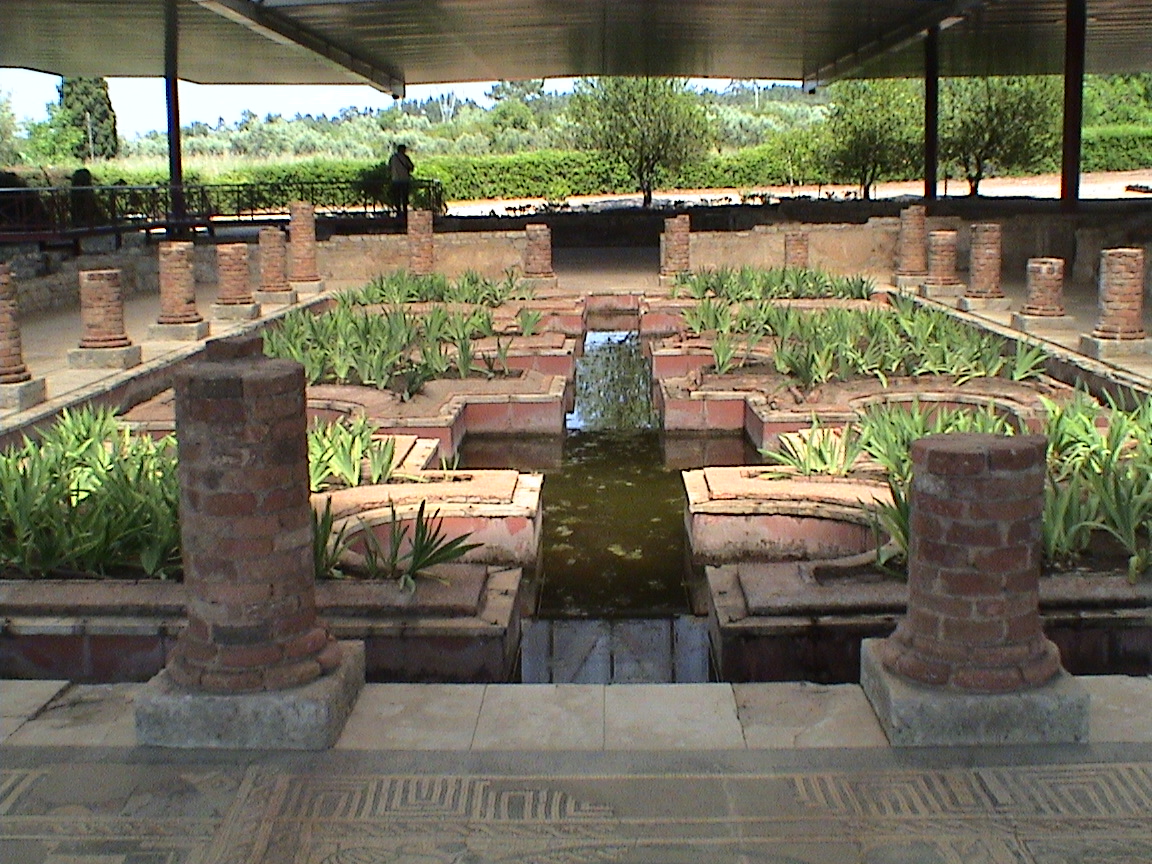
In Porto we stayed in a wonderfully whacky castle known as Castelo Santa Catarina. We particularly enjoyed Porto’s old and picturesque waterfront known as Ribeiro.
From Porto we continued north to Santiago de Compostela, Spain, where we spent two nights in an old medieval pension, taking a side trip to Cabo Finisterre, the westernmost point of continental Europe. The province of Galicia is one of our favorite regions of Spain. The Cathedral of Santiago de Compostela is a phenomenal structure, always a very busy and sacred place because it is the site of the tomb of St. James, which is also the termination of the Camino or “Way of St. James,” the famous pilgrimage route across northern Spain that has its source in southern France.
On Sunday, June 12, we began our long drive back to Madrid to return our rental car. From there we took a train to Acala de Henares, where we stayed until June 17, attending the CMS International Conference. Then we traveled by train back to Madrid where we stayed until Tuesday, June 21, when we returned to Tallahassee.
First CMS blog by Dale (June 14, 2005): Diane and I have been in Spain for a week and a half, which includes three days so far at the CMS international conference in Acala de Henares. It has taken some time to get set up because I have never blogged before. Diane, my wonderful bride of 40 years, will also be blogging under her name. She is much more descriptive than I, and soon I have to leave to present my paper.
We rented a car last Monday, a week and a half ago, and drove to Guadalupe and Trujillo, where we stayed overnight, visiting the abodes of the infamous Pizarro the conquistador and conqueror of Peru. I´ve always wanted to know how he lived in Spain. He was wealthy, and we all know why. The second day we drove to Merida to visit Spain´s most impressive Roman ruins, and then into Portugal, stopping at the medieval towns of Elva and Evora. Finally we arrived in Lisboa around 5 PM, but immediately drove to the coast to see the sunset at Cabo da Roca, the westernmost part of Europe. We finally arrived to our 18th century pension in Sintra, in the mountains outside of Lisboa, about 11 PM, after getting hopelessly lost for about 3 hours (thanks to one of our many guardian angels along the way, we got to the pension). The next day we left our car at the Sintra train station and took the train into Lisboa. There we took trolleys, funiculars, and other transportion around the city, visiting all sorts of great places. The next day we headed up north in Portugal, stopping off in Fatima and Coimbra, and some more Roman ruins before reaching Porto, where we also got lost. Portugal doesn´t believe in street signs, providing exits from the autopistas into town, or indicating which streets are one way on their maps. Finally, after being lost for about 2 hours we found our Castilo Santa Catarina (thanks to several other guardian angels). The next day was a national holiday in Portugal, so there wasn´t much traffic. We drove downtown to the famous waterfront of Oporto. In the afternoon we set off for Santiago de Compostela in Galicia, where we stayed two more nights in an old stone building in the old section of town. What beautiful towns these historical places are. The next day we drove to the coast of Galicia, where the fjords are much like those in Norway. Then on Sunday we drove to Acala de Henares, and Monday we returned our car. We learned so much on this trip, and in my next installment I´ll begin to describe the conference itself, the town of Acala de Henares, the storks on all the rooftops (so it seems), the trip to Toledo, the wonderful food, and the great papers, conferences, and socializing with (and meeting new) friends. Hasta pronto.
Dale A. Olsen
CMS Past President
Second CMS blog by Dale about Segovia and El Escorial (June 17, 2005): Yesterday, a group of us took an enchanting day trip to the charming and scenic city of Segovia, and to El Escorial, the Royal Monastery of San Lorenzo. We had an amazing morning in Segovia, visiting a 2000 year old Roman aqueduct (supposedly one of the best-preserved Roman building projects anywhere in the world) situated at the base of the city center, a castle (the Alcazar, built in the late eleventh at the confluence of Segovia’s two rivers, Eresma and Clamores) straight out of a fairy tale (our guide told us that Walt Disney had visited for 3 days and that probably, some part of his designs for Disneyland came from his visit to this castle) , and a 14th-century cathedral. Segovia is about 90 km north of Madrid, about an hour and a half, by bus.
Groups then splintered off in search of coffee and a quick snack (1 pm being way to early for lunch in Spain) before heading to El Escorial. Tod and I had tapas at a popular and highly recommended Segovian tapas bar, Jose y Maria. It was a wonderful venue, and the best tapas we´ve had in Spain. Amazing little ham and cheese toasted sandwiches, roasted red peppers and garlic, Spanish sausage and peppers, Spanish potato salad, and octopus in olive oil and garlic were some tapas we shared. The custom here, after eating in a tapas bar, is to pitch your small paper napkin to the floor. It is a proud and clean country, and we followed suit! When in Segovia…
El Escorial, about 50 km northwest of Madrid, is a vast and spectacular fortress and monument. It is both a palace and a monastery, and contains an enormous and impressive library. Covering over 30,000 square meters, El Escorial has 9 towers, 9 organs, 16 patios, 73 statues, 86 sets of stairs, 88 fountains, 300 cells, 1,200 widows, more than 1,600 paintings, 2673 doors, an amazing octagonal crypt where all of the Kings of Spain are buried (there are additional crypts), and a functioning cathedral.
This was a day filled with wonderful discussions about the Spanish culture and promises to return, soon.
Third CMS blog by Diane (June 20, 2005): Hello from Madrid, several days after the CMS conference. Sorry that I (Dr. Diane Olsen) haven`t written until we are almost at the end of the trip! It has been difficult to make internet work for us for a variety of reasons — getting lost trying to find our hotels in out-of-the-way places (more of that below), having very late suppers and then right to bed, sight-seeing until late, not finding internets as easily as in Vietnam, etc. The last time we tried, we had paid for 1 hour, and got cut off. I had actually started a letter then, but in disgust, we left. Dale was blogging for the CMS International Conference members, and had written about 4 pages when he lost it all. Usually, they charge you when you finish, so we were a little horrified!
So, I will start this and hope to finish before the time runs out. Dale is back at our little hotel resting, with a very bad cold – pobrecito! Yesterday [June 19] Dale and I did a grand tour of Madrid, and today [June 20] I continued solita with the Royal Palace. Yesterday, we took advantage of the double-decker tour bus, and went around most of downtown Madrid, without stopping to see the individual sites. We felt that was the only way to conquer such a big city — get the lay of the land first.
Madrid is such a huge, but beautiful city. We went to the Royal Palace yesterday, with a great view of the gardens behind, and a whole huge section of the armor, weapons, etc. used at the time of Carlos V and Felipe II (16th and 17th centuries). The rooms of the palace are so elaborate, with so much decoration and style: influences from China in a couple rooms, of course, the Italian and the French art and architecture — great chandeliers, clocks, tapestries, ceiling frescoes, colorful plaster on the walls, floor tiles, draperies, etc. It seems that we only have time for one or two sites a day — still much left to do! Today, while Dale is resting at our hotel trying to sleep off his cold, I went to the Prado for all of one hour! I saw only the early religious art and nightmarish Bosch today. (We´d seen Velazquez, El Greco and Goya before).
So, we have one more day here, and we leave Tuesday [June 21]. Some of the museums are closed so we shall see what we can do.
Did you hear about the anti-gay demonstration here yesterday? We got caught in the middle of it — hundreds of people arrived by bus from all over the country. Posters with “Marriage is for a man and a woman” and “protect the family” held by moms, dads, children, grandparents, etc. It was definitely peaceful — I saw no counter-demonstrations. As you know, the Catholic roots are very deep here.
The CMS International Conference this past week went well. It was held in the small town of Alcala de Henares, about 40 miles from Madrid. That is where Cervantes was born, and it is the 400th year celebration of something – either his birth or the writing of Don Quixote! The town seemed to be celebrating both. We were wrapped up in the conference, and group activities (a tour to Toledo, dinners), so missed some of the other stuff going on around town. We did a walking tour of the town, however, and saw the very early university (1200), one of the oldest in Spain. One field of study at that time was translation, important for translating the Bible, and at that time, they emphasized Latin, Greek, Hebrew, and Amharic. Of course, they also emphasized law, theology, and medicine. Our young guide was from Germany, and explained that her tuition was paid completely by the government. (She is studying international business). It hardly costs anything anyway — very low tuition! Now this college is spread around the town, not just in the initial (small) location.
Dale´s paper was on sesquialtera, a certain rhythmic pattern found in the music of Spain that influenced the dance music of many Latin American countries, and of course, it went well. Throughout the conference, there were many lecture-demonstrations and concerts so we heard a lot of music, this time especially of Spain or Spanish-influenced countries (including the works of Lorca, gypsy and guitar influences). We have several friends who always come to the CMS International Conferences, so that is special as well.
Other things we have done: seen the sunset over the Atlantic from Portugal (Cabo da Roca) and Spain (Ponte de Finestra); visited the religious pilgrimage sites of Fatima in Portugal (this picture) 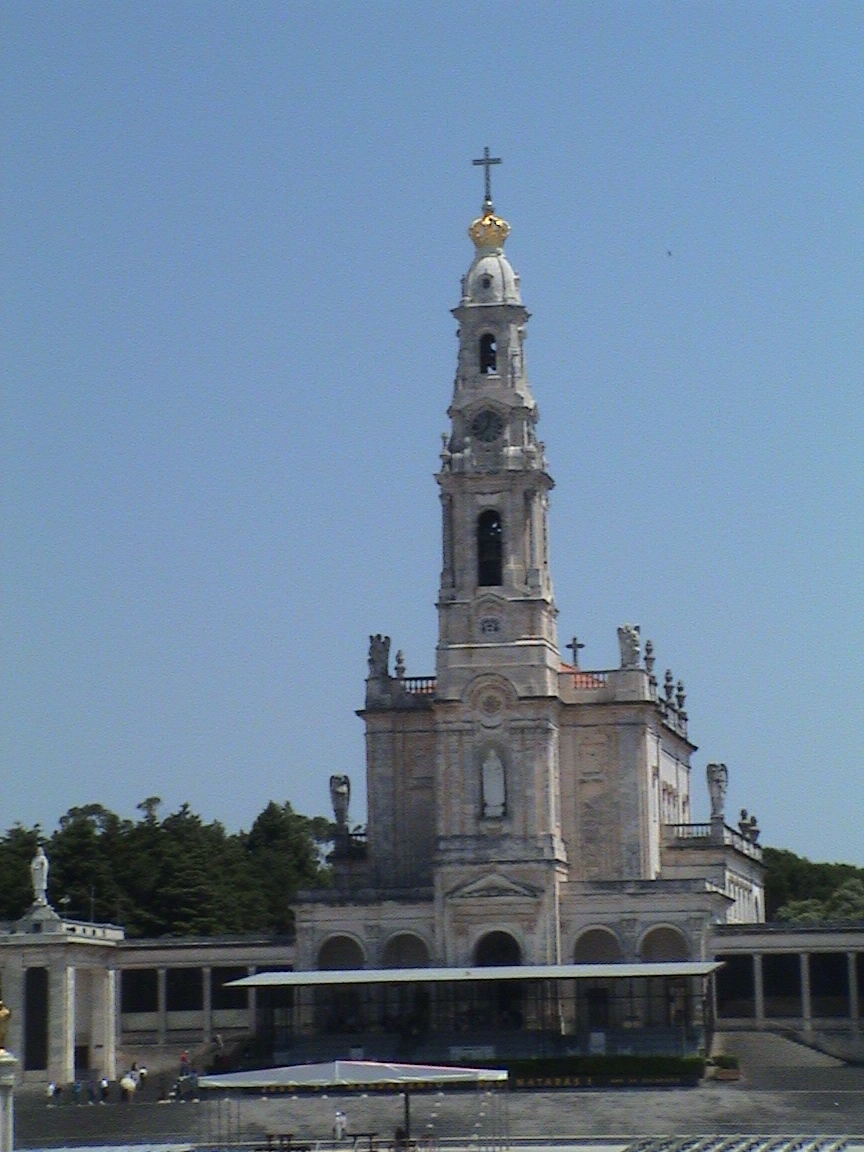 and Santiago de Compostela in Spain — pilgrims walk across across the northern width of Spain on el camino, the road of St. James, ending at the massive cathedral where the apostle is supposedly buried); impressive cathedrals (including the one in Toledo which is also huge like the one in Santiago — both are full of gold, art, carvings of wood, history, bones, etc.); tremendous Roman ruins both in Portugal and Spain; lovely winding streets in little medieval towns, with wrought-iron balconies and lamps, cobblestone roads, ancient walls, storks with their rather large babies in nests at the top of tall chimneys lovely forested hills and farmlands; plus the dry, flat Mancha where Don Quixote and Sancho Panza traipsed.
and Santiago de Compostela in Spain — pilgrims walk across across the northern width of Spain on el camino, the road of St. James, ending at the massive cathedral where the apostle is supposedly buried); impressive cathedrals (including the one in Toledo which is also huge like the one in Santiago — both are full of gold, art, carvings of wood, history, bones, etc.); tremendous Roman ruins both in Portugal and Spain; lovely winding streets in little medieval towns, with wrought-iron balconies and lamps, cobblestone roads, ancient walls, storks with their rather large babies in nests at the top of tall chimneys lovely forested hills and farmlands; plus the dry, flat Mancha where Don Quixote and Sancho Panza traipsed.
We have also stayed a few times in very elaborate, fancy places, which are quite difficult to find in the dark! It took us about 1 1/2 hours to find the one outside Lisbon in the mountain town of Sintra — used by kings and queens to escape the heat in the summer. But our angel helped us – in the form of a restaurant owner who after closing (at 11:00) actually led us to our place! We could never have found it. Our poor map had no road names, and the roads had no names anyway, that we could see! That place, in spite of everything, is delightful. Behind walls, it was an old manor home, now with about 10 rooms for rent, and a beautiful garden including a great swimming pool for laps, which I never had time to use . We think we may return sometime, because we never did see much of the town! Lisbon is also very interesting, especially the castle at the top of a large hill, with great views of the city and river.
So, bye to all! We will see you all soon — and of course, we have (electronic) pictures galore! Love to all! Di
Forth CMS blog by Dale (June 20): Di writes such beautifully descriptive letters. I feel much better now, and thought I would add a final few words about our last day in Madrid, and then sum up the conference.
Today we walked through the beautiful Retiro park, that huge expanse of woods, paths, water, fountains, and exotic buildings very close to our hotel near the Paseo del Prado. We found our hotel, Hotel Mexico, by getting off at the Atocha train station and checking out several hotels hear the station. It turns out that the Atocha train station areas is just several blocks from all the major museums in Madrid, the Retiro park, and beautiful boulevards (I usually associate train stations with red light districts, but not in Madrid). Our hotel is very near the place where Cervantes and Lopez de Vega wrote much of their literature (near the Plaza Santa Ana). It also has AC and is inexpensive (highly recommended). After spending several hours in the park, then shopping for our granddaughter, we rested for a short while and then strolled through the Barrio de Literatura (with the Plaza Santa Ana in the center), on to the Plaza del Sol, to the Paza Mayor, and then we metro-ed back to the hotel area where I am now writing this blog. The Spanish medicines I have been taking have worked wonders, and I feel so much better.
The CMS International Conference of 2005 was a great success. Each one of these is so unique, and I´m sure all of us will be talking about each one with different types of superlative phrases. I learned a lot at this one because of all the papers and performances about Spanish and Latin American music. The input by the large handful of Spanish scholars was excellent, and I made several important friendships with scholars who heard my paper and offered some thoughts. I look forward to nurturing those friendships. There are now a number of CMS faithful individuals who are becoming known as the International Conference Groupies. We all enjoy seeing each other every two years (at least), and sometimes more often than that. It seems that there are a number us us who are world travelers, and we always enjoy each other´s company. One of these persons is Tod, who gets to see all the things we remember several times. What a great job he has, and what a great job he does! I would like to personally thank Tod for all that he has done. I would also like to thank Angeles for her excellent work as program chair, and Judith for all the work she did.
I must sign off now, or I will lose all these pages. Greetings to all, and best wishes. Dale
Western Mexico: 40th Wedding Anniversary Cruise
June 22-28, 2005
For our 40th Wedding Anniversary we took our first cruise ever on Holland America Line with David and Mary Stevenson, our dear friends in Tallahassee since the mid 1970s. We two couples were married on the same exact date, June 26, 1965, in Minnesota and Michigan, respectively, and on this cruise we celebrated our 40th wedding anniversary together. We drove from Tallahassee to Mobile, Alabama, where we embarked at 5 PM for the Caribbean coast of Mexico, specifically Cozumel.
It has been Diane’s and may dream since 1970, when we lived in Mexico, to visit the Mayan ruins of Tulum in the province of Quintana Roo, but there were no drivable roads until decades later. Now, with a cruise ship port on the Island of Cozumel, it is an easy ferry ride to the Mexican mainland and and hour-long drive to the captivating ruins on a high bluff overlooking the Caribbean Sea. Tulum is now a Mecca for tourists.
While David and Mary joined an English-speaking tour group, Diane and I took off on our own because of our interests in archeology. We had excellent guide book in one hand and cameras in the other. Archeologist/art historian Dr. Roy Craven, curator of the Florida State Museum at the University of Florida had inspired wit his beautiful book about Tulum, and now were seeing it and exploring it for ourselves, while staying safely within the boundaries set by the curators of the site.
Vietnam III: Guggenheim Award and book researach
July 2-August 14, 2005
After teaching for two summer sessions in Ho Chi Minh City (HCMC) in 2002 and 2004, and spending a lot of my time conducting bibliographic and field research in HCMC and Hanoi, I was awarded a Guggenheim Fellowship for continuing my research in Vietnam on order to finish my book titled Popular Music of Vietnam: The Politics of Remembering and the Economics of Forgetting (New York/London: Routledge, 2008).
General letter sent to colleagues, students, and other friends (July 25, 2005): Hello everyone, and greetings from Vietnam. I wish you all well, wherever you are, and would like to share a few of my experiences with you from Ho Chi Minh City (which I still like to call Saigon, as many Vietnamese still do).
All is well here and my research is going about as well as can be expected. I have basically finished writing my book, based on what I have researched so far. I need more things, however, like more interviews; that is what I am concentrating on the most, but time is almost running out (I leave here August 15). I have gone to some fantastic concerts, made excellent recordings and video footage, and taken copious field notes. The days have been going by quickly.
For my birthday, which was July 10th, the Riverside Hotel staff gave me a beautiful bouquet of roses with a nice little banner saying “Happy Birthday.” I tell you this because they are sweet and very good to me, their long-term renter. The hotel is right on the Saigon River with a beautiful view, although I choose a city view because it is very quiet. The riverfront is always noisy because there is a busy street between the hotel and the river. From the top floor (where I live) is a balcony-deck that I go out on very often, just to watch the boats. It’s especially pretty at night. Diane told me to look for the full moon, and there it was! I hadn’t ever looked up while walking the streets of Saigon, because it’s important to always look down to see where you are walking, to the sides constantly to watch out for motorbikes or cars (or people), and behind you (I was robbed once several years ago). This city is like an anthill that has been stepped on, only all the movement is with motorbikes. It’s amazing!
I am enjoying the food, and have several favorite spots that I go to. There are Korean, Thai, and Indian restaurants very close by. There are also several Vietnamese places I go to, one in the hotel, another down the street, and another that is a bit of a walk, but close to a big hotel where I have been going to play jazz flute with the hotel jazz combo.  It’s a lot of fun, and the musicians enjoy my participation. Of course, there are Vietnamese restaurants all over the place, so I experience many wonderful tastes. A huge breakfast buffet comes with the hotel, so I eat big in the morning and then don’t eat again until about 7 PM. There are several coffee houses I like to go to where I can write and drink Vietnamese iced coffee (very sweet). I also go to the American office of Cultural Affairs, where I first presented myself by whipping out my official Guggenheim letter. They have helped me a great deal, because both the Cultural Attachee (a young American) and one of his assistants (a young Vietnamese) have many contacts. I will give a lecture there in a few weeks on Native American Pop Music, one of my favorite topics. As you know, the title of my book is “Farewell to the Past: Pop Music, the Politics of Remembering, and the Economics of Forgetting in Vietnam.” So, even for an old fellow like myself, pop music is of great interest. It’s really the social issues that interest me the most, however, although some of the music is excellent, especially Vietnamese rock and heavy metal. There are some very interesting musical things going on here (and also with Native Americans) that have to do with identity, memory, and “glocalization” (globalization mixed with local color).
It’s a lot of fun, and the musicians enjoy my participation. Of course, there are Vietnamese restaurants all over the place, so I experience many wonderful tastes. A huge breakfast buffet comes with the hotel, so I eat big in the morning and then don’t eat again until about 7 PM. There are several coffee houses I like to go to where I can write and drink Vietnamese iced coffee (very sweet). I also go to the American office of Cultural Affairs, where I first presented myself by whipping out my official Guggenheim letter. They have helped me a great deal, because both the Cultural Attachee (a young American) and one of his assistants (a young Vietnamese) have many contacts. I will give a lecture there in a few weeks on Native American Pop Music, one of my favorite topics. As you know, the title of my book is “Farewell to the Past: Pop Music, the Politics of Remembering, and the Economics of Forgetting in Vietnam.” So, even for an old fellow like myself, pop music is of great interest. It’s really the social issues that interest me the most, however, although some of the music is excellent, especially Vietnamese rock and heavy metal. There are some very interesting musical things going on here (and also with Native Americans) that have to do with identity, memory, and “glocalization” (globalization mixed with local color).
Well, this letter was meant to be a “Greetings from Vietnam letter,” and not a thesis on my eating habits or research. Take care, and love to all of you. Dale
Travels in 2006
Panama I: Teaching with the FSU Panama Program
May 3-June 16, 2006
I had the wonderful opportunity to teach in the International Programs at FSU-Panama in Panama City, Panama, for the first time during the first summer session of 2006. This offered me the opportunity to learn about the music of a country in Central America that I had never visited before, except to stop for refueling in the middle of the night on our flight to Santiago as Peace Corps Volunteers back in 1966. One of the most important experiences I had during this first trip to Panama was going on an International Programs trip to the San Blas Islands in the province of Kuna Yara, home to the Kuna Native Americans. Other important outings were to Panama Antigua, the archaeological ruins and reconstruction of Panama City from the time of the early Spanish colonists, before the attack and burning of the town by the pirate, captain Drake; to Portobello, the former Spanish colonial village, fort, and customs. house at the end of El Camino Real (The Royal Road), now an Afro-Panamian enclave famous for its Black Christ and African-derived music; and Chagre National Park.
The music of the San Blas Kuna. Because of my interest in South American Indians, shamanism, flutes, festivals, and other ethnomusicological topics, and because of my friendship with Dr. Sandra Smith, a colleague at UCLA who wrote a book on Kuna panpipe music and culture, I wanted to experience the Kuna and their music for myself. 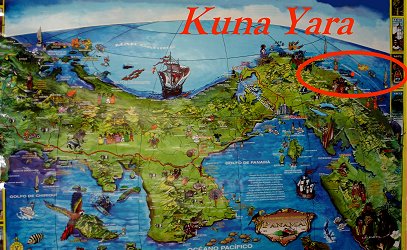 Therefore, during my short stint with the Kuna in the San Blas Islands, province of Kuna Yara off the southern Caribbean coast of Panama, I made lengthy fieldnotes based on my observations, interviews with panpipe musicians and a shaman, and analyses of the music I heard and Kuna culture I experienced. I include some of those fieldnotes in the following paragraphs.
Therefore, during my short stint with the Kuna in the San Blas Islands, province of Kuna Yara off the southern Caribbean coast of Panama, I made lengthy fieldnotes based on my observations, interviews with panpipe musicians and a shaman, and analyses of the music I heard and Kuna culture I experienced. I include some of those fieldnotes in the following paragraphs.
May 27-28, 2006 (Saturday-Sunday). I am on this island with the FSU-Panama group — 4 professors and 9 students (3 girls and 4 guys). We arrived via Air Panama yesterday, after getting up at 4 AM and getting to the airport by 5:00 to leave at 6:00 (so we thought). The plane actually left at 8 AM, and we landed in  Cortí, the main San Blas Island or Kuna Yara administrative island, 45 minutes later.
Cortí, the main San Blas Island or Kuna Yara administrative island, 45 minutes later.
We were met by our Kuna hosts who took us to their village on a smaller island via their motorized canoe called ulu. Some Kuna village members have outboard motors for their canoes, but most local inter-island traffic is very silent, with paddling and sailing the norm. The Kuna sometimes turn their dugout canoes into sailboats, making movement from island to island within the settlements easier and faster than paddling and cheaper and quieter than using outboard motors.
When we arrived at the smaller island home of our hosts, we were given sleeping quarters. I was assigned to be with a family in a small shack that was hot and crowded with no privacy. So, I asked the Kuna hosts if I could sleep outside in the hammock that was strung up on the covered deck of the main community building just next door, a place where the Kuna sell their molas. They said I could. That space was also close to the only bathroom, for which I was thankful.
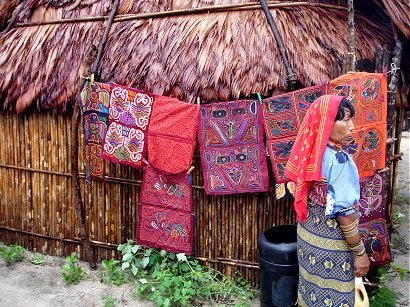 Kuna Indian women (and men) make molas for sale to tourists. The mola is made with a reverse stitched embroidery technique, and it is traditionally sewn into a woman’s skirt and used to ward off evil spirits. Today molas are major tourist items, and most no longer have supernatural significance
Kuna Indian women (and men) make molas for sale to tourists. The mola is made with a reverse stitched embroidery technique, and it is traditionally sewn into a woman’s skirt and used to ward off evil spirits. Today molas are major tourist items, and most no longer have supernatural significance
Shortly, our hosts fixed us a nice breakfast of eggs, bread, and coffee. Soon it began to rain lightly and we all went to our assigned quarters to wait out the rain. About 11:00 AM we left by boat to go snorkeling at Devil’s Island and another outer island. On the way there the captain’s motor broke down, which reminded me of my experiences with the Warao Indians in Venezuela, when my guide’s outboard motor on his canoe broke down several times. However, our Kuna boatman was able to fix his motor quickly. When we arrived to Devil’s Island, the larger of the small two islands for snorkeling, we were met by the sole inhabitants, a small family that immediately wanted to sell us molas — everywhere we went in San Blas, it seems, there were ladies selling molas!
 Between the two islands was a sunken freighter that has been there for 70 years. Three of us swam over to where it was said to be — there was quite a strong current, the water was deep, and I was glad I had my swim fins along. After some searching, we finally located the freighter, which was very long and covered with coral. Swimming over a part of it made me appreciate even more the many Clive Cussler novels I have read (I have read them all!). Swimming back was a chore, and I thought, Dirk Pitt, Kurt Austin, or Sam Fargo I am not! But, I am (was), after all, 65 years old!
Between the two islands was a sunken freighter that has been there for 70 years. Three of us swam over to where it was said to be — there was quite a strong current, the water was deep, and I was glad I had my swim fins along. After some searching, we finally located the freighter, which was very long and covered with coral. Swimming over a part of it made me appreciate even more the many Clive Cussler novels I have read (I have read them all!). Swimming back was a chore, and I thought, Dirk Pitt, Kurt Austin, or Sam Fargo I am not! But, I am (was), after all, 65 years old!
While we rested and explored Devil’s Island, our guide was busy fishing and caught a large red snapper for our dinner. 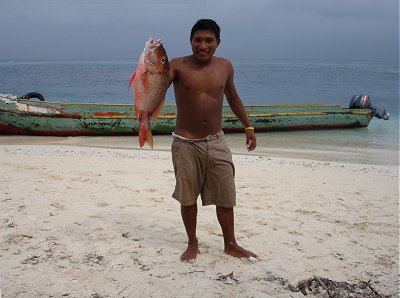
On the way back it began to rain very hard and we all got soaked, which removed some of the salt and cleaned us off a little. When we arrived to our village home we took showers by scooping water from a rain barrel and pouring it over our heads, bodies, and into our swimming suits.
Dinner was soon ready, and we ate wonderfully fresh fish, including a big red snapper caught by our boatman/guide. We all tried to get the recipe, but it was not possible for him to make it understandable to us. We should have watched him cooking it.
After dinner some of the village’s young boys and girls (members of a performance troupe) gave us a personal performance of several animal dances while playing their panpipes and rattles. The boys leaped through the air as they played their panpipes, and sometimes both the girls (playing rattles) and boys darted amongst each other.  Their dances imitated animals and birds, we were told. I thought, this must be the panpipes for play that Sandy Smith wrote about in her book. Each village has a panpipe/rattle troupe, and the Kuna hold competitions between the village troupes. I also learned, however, that panpipe music and dance can also be religious; most of the adult panpipe music, for example, is secret and not performed for tourists. The panpipe ensemble competitions and performances for tourism by youth groups are recent phenomena.
Their dances imitated animals and birds, we were told. I thought, this must be the panpipes for play that Sandy Smith wrote about in her book. Each village has a panpipe/rattle troupe, and the Kuna hold competitions between the village troupes. I also learned, however, that panpipe music and dance can also be religious; most of the adult panpipe music, for example, is secret and not performed for tourists. The panpipe ensemble competitions and performances for tourism by youth groups are recent phenomena.
After several more hours of socializing, I went to my outdoor sleeping quarters. The evening was not enjoyable, however, because my hammock was not a traditional one, but was like an American hammock with wooden bars across each end — quite uncomfortable because it is not possible to sleep diagonally, which is the proper way to sleep in a traditional hammock. My decision to sleep outside was also not wise because of the weather. In the morning about 6:00 AM it rained really hard and I had to exit my hammock outside the main building and seek shelter inside my host’s shack. Even though there was a roof over me and a tarp for a wall, the easterly wind was picking up. It was like a mini squall — hurican (hurricane), the Kuna said, laughing. The floor of the shack became like a river, as water flooded in from the yard and front patio. The rain seemed to stop at about 8 AM.
After breakfast on our second day in Kuna Yara we took a short excursion to visit a small Kuna museum on the main island, which is the Cortí administrative center. There we visited a Kuna museum and had a long and informative lecture by a Kuna historian. 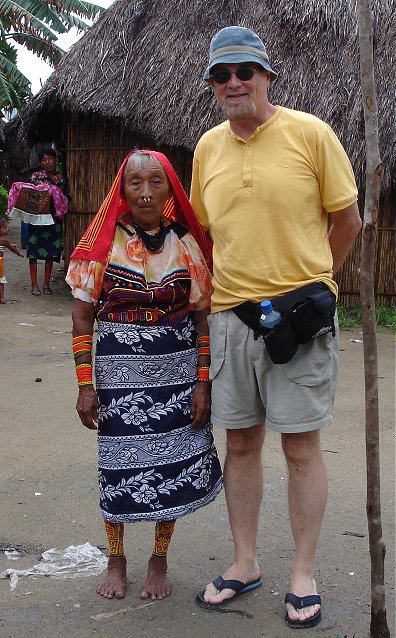 After the lecture I had this picture taken of me with a traditionally-dressed Kuna woman. Then I bought a complete Kuna dress with all the extras for Diane.
After the lecture I had this picture taken of me with a traditionally-dressed Kuna woman. Then I bought a complete Kuna dress with all the extras for Diane.
We returned to have lunch, and I enjoyed a quiet afternoon in my hammock, writing, reading, and watching the canoes–listening to the boatmen blow their conch shell trumpets as they navigate and greet one another. As I reclined in my hammock, enjoying the tranquility of the sea, the sounds of Kuna life, the quiet talking of the Kuna men, suddenly one of the owners of a house nearby turned on his radio or cassette player and played salsa music. What a shocking contrast! Thankfully, it was at a low volume, but was still an incongruous interruption — although I enjoy salsa music — to the peaceful nature of this island paradise.
Sunsets from the Caribbean coast of Panama are beautiful, and it is always strange to see the sunset over the Caribbean in Panama, rather than over the Pacific. 
Travels in 2007
Panama II: Teaching with the FSU Panama Program
May 3-June 16, 2007
I taught Latin American music at FSU-Panama in Panama City, Panama, for the second time during the first summer session of 2007. This offered me more opportunities to travel within Panama, specifically to the Chagres River to visit the Embera Indians; to the colonial town of Portobelo on the lower Caribbean coast; then to Bocas del Toro on the upper Caribbean coast; and finally to the northwestern town of David to visit Rob Knox, my friend and former student at the University of Florida where I taught in the early 1980s.

Thailand, Cambodia, Taiwan: CMS International Conference and beyond
July 10-August 4, 2007
Diane and I attended the CMS International Conference in Bangkok and Ayutthaya, where I presented a paper. We traveled around Bangkok (Chao Phraya River; Grand Palace; Wat Phra Kaeo; Wat Pho) and Ayutthaya ( Wat Phanan Choeng; Wat Phra Sri Sanphet). After the conference we flew to Chang Mai, visiting many points of interest (Ping River, Wat Phra Singh, Wat Chinang Man, Wat Chedi Luang, Wat Suan Dok, Wat Bupparam, Wat Phra That Doi Suthep, Mae Tang River for rafting and elephant watching, outdoor market in Sappong, Chiangdao Cave, Hill tribes north of Chiang Mai, Doi Inthanon National Park southwest of Chang Mai).
We also went to Phuket, visiting Ao Phyang Nga Bay (“James Bond Island” and other limestone karst islands).
Then we flew to Siem Reap, Cambodia, to spend several days at the Ankor Wat complex (specifically visiting Angkor Wat, Angkor Thom, Bayon, Phimeanakas, Ta Prohm, Preah Rup and East Mebon, Ta Som, and Prea Khan).
Travels in 2008
Panama III: Teaching with the FSU Panama Program
May 7-June 23, 2008
 I once again taught Latin American music at FSU-Panama in Panama City, Panama, for the third time during the first summer session of 2008. This offered me more opportunities to do research for a book on the music of Panama. During this term I also met many Panamanian musicians, conducted interviews, and traveled to several religious folk festivals — no, not by horseback, but by FSU van.
I once again taught Latin American music at FSU-Panama in Panama City, Panama, for the third time during the first summer session of 2008. This offered me more opportunities to do research for a book on the music of Panama. During this term I also met many Panamanian musicians, conducted interviews, and traveled to several religious folk festivals — no, not by horseback, but by FSU van.
Portobelo
One of my favorite excursions with several FSU students was to Portobelo, a very the old town of great importantance in Spanish-Panamaian history. Portobelo, established by the Spanish in 1597, is located on the Caribbean coast at the end of El Camino Real (“The Royal Road”), where the old Spanish Aduana Real (“Royal Custom House”) was built, and from which all the gold from Peru and elsewhere in South America was counted before it left by ships to Spain; the beginning of El Camino Real is, of course, Panama Antigua on the Pacific coast. The old forts in this colonial area of Portobelo on Panama’s Caribbean coast are very interesting and relatively unknown to tourists. One of the main reasons I wanted to take this trip again to Portobelo was to visit the old Fort San Fernando, which is accessible only by boat — I had visited the mainland old Fort San Jerónimo (aka Fort Santiago in 2007).
There is a lot of history in this part of Panama. Portobelo was the richest town in the new world, so greedy British and Dutch pirates were a constant threat for the Spanish. The fort system was first constructed in the early 1600s and finished in 1620. They were attacked many times. One thing I found out is that the forts were built from coral, which would not crumble when hit by cannonballs. The coral absorbed the shocks, and the cannonballs could be used again, by the Spanish.
The following pictures are some of my photographs of the isolated Fort San Fernando, off the main coast and across the water from Fort San Jerónimo in the town of Portobelo. All of these historic forts in Panama are World Heritage Monuments.
The heavily forested and seculded coves and beaches of the Caribbean in this region of Panama are some of the most beautiful I have ever visited. It is an unusual area also, because the sun sets off this coastal region of Panama. The unusual shape of the Republic of Panama sort of plays geographical tricks on you — for example, the sun sets over the Caribbean coast (?), to fly to Cargajena in Columba from Panama you fly north (?), in the Panama Canal you travel west from the Pacific Ocean to reach the Atlantic (i.e., the Caribbean), and other anamolies.
Religious folk festivals
May 22, 2008–Corpus Cristi. The folk Catholic festival of Corpus Cristi (Body of Christ) is performed in La Villa de Los Santos in the province of Azuero, Republic of Panama, each year in May. Several FSU-Panama students and I traveled to the La Villa de Los Santos in the province of Azuero, arriving at 11:45 AM, just in time to witness the opening festivities of Corpus Cristi that included a number of Los Diablicos Sucios (“The Dirty Little Devils”) dancing and processing on hundreds of scattered flowers around the main plaza of the village. Individual Dirty Little Devils, often accompanied by a guitarist, move about in the center of the town, performing for visitors and scaring the children — or at least the children were having fun by pretending to be scared. Often the children would chase the devil dancers rather than the other way around. It was a time for having fun before the afternoon parade began. 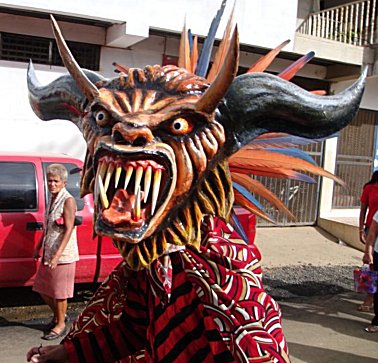
This was shortly followed by a brief opening service in the small Catholic Church built on the outer corner of the plaza. After the service was a recessional by the dancers, the bishop, the people in attendance, and everyone left for lunch. 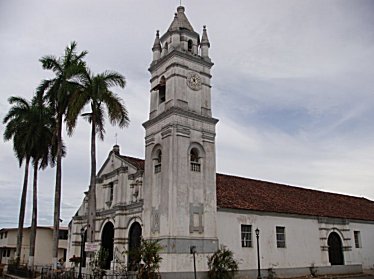
We found a small rustic restaurant, had a quick lunch, and returned to the plaza where there were many children and other young people just hanging out. This was a time for us FSU visitors, fascinated by the extravagant costumes, to borrow some masks and have some fun, scaring ourselves and taking pictures of our fearless silliness.
The main event of the celebration of Corpus Cristi — the parade — takes place after lunch. The following parade pictures show some of the excitement, color, and imagination of this important religious folk festival in central Panama’s best known festival village of Los Santos: they are from the scary Dirty Little Devils and fiercesome jaguars and other animals, to the cuteness of other dancing groups, such as cone-headed dolls to other perhaps Disney-inspired costumed ensembles.
Travels in 2009
Autumn in Korea and Japan
October 24-November 13, 2009
Diane and I traveled with Louise Rill to Seoul, Korea, to visit our friends Hyo and Henry Lee. Then we flew to Japan to visit Bryan and Lisa Rill, Louise in …..
Mexico: SEM Conference Fun and More
November 18-24, 2009
Diane and I attended the annual SEM Conference, held in Mexico City.
Travels in 2011
Nova Scotia, PEI, and Newfoundland: ICTM Conference
July 1-23, 2011
Flew into Halifax, rented a car and drove to Green Gables on Prince Edward Island, to Cape Breton Island, took ferry from Sydney to Port aux Basques in Newfoundland, drove to Rocky Harbour, to St. John’s for ICTM, to Burgeo, to Sydney (Ferry to NS), drove to Halifax, and flew home.
Vanacouver to Alaska
August 12-September 3, 2011
Flew to Vancouver, cruise ship to Seward, etc.
Travels in 2012
Dominican Republic: SEMSEC Conference
March 7-12, 2012
SEMSEC Conference
France and Italy: Viking cruise on the Seine, fly to French Conference in Albrac, bus and train to Provence, Cinque Terre, Aosta, fly to Paris.
August 7-September 10, 2012
During the summer of 2013 I presented an invited paper in French at a French-speaking conference in southern France (Aubrac, Aveyron). We began our summer by taking an 8-day river cruise on the Seine, from Paris to Giverny, Vernon, Rouen, Normandy, Les Andelys, Conflans — then cruising back to Paris where we stayed another week in Verrieres le Buisson with our hosts Pierre, Maica, and their daughter Ananda Hamon (Pierre and Ananda took us to Versaille and Bayeax to see the famous Norman tapestries). The conference organizers provided for us to fly to Rodez, Aveyron, from Paris, and they drove us to Aubrac, a beautiful medieval village at a crossroads that is on the pilgrimage trail that ends in Santiago de Compostela in Galicia, Spain. In Aubrac I presented an invited paper titled “A Musique d’Eldorado” at the Dix-septiemes Rencontres D’Aubrac Conference, which had the topic and was subtitled “Imaginaires de L’Eldorado.” 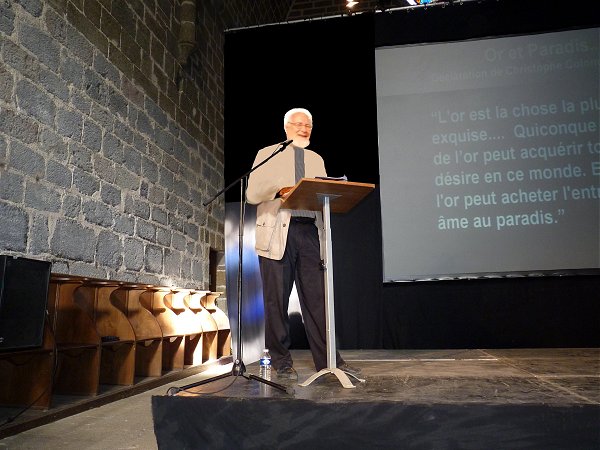 After my paper I immediately performed in a pre-Columbian musical instrument concert with Pierre. That way I did not have to take any questions about my lecture.
After my paper I immediately performed in a pre-Columbian musical instrument concert with Pierre. That way I did not have to take any questions about my lecture.
After the conference Diane and traveled with friends in their car to Millou, and then by bus to Montpellier and train to Avignon, Provence, where we stayed for five days. While in Provence we also went to Arles to visit the haunts of Van Gogh and to Aix en Provence to hike Victoire Mountain and learn about Cezzane.
Then we took regional trains to northern Italy, where we stayed a week in Cinque Terre to hike the famous trails.
Then we took a train to Aosta in northern-most Italy. This picture is of Di and me in the Alps, with Cervino (Matterhorn) in the background. 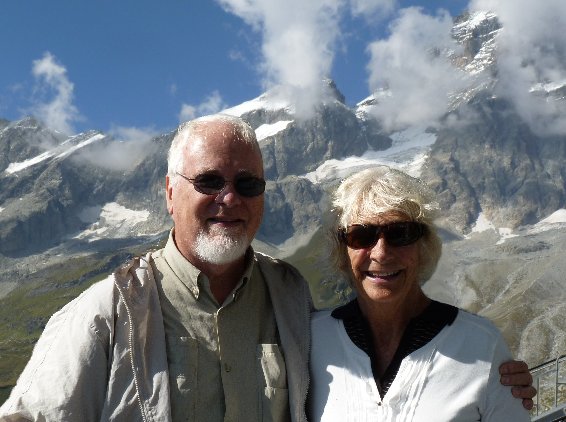
We finally took a bus to Milan and then flew back to Paris for several more days.
Ecuador and the Galapalos Islands
October 20-November 5, 2012
We traveled to Ecuador because I was invited by XXX to present a paper at Ecuador’s International Musicology Conference in Loja in the southern region of the country. We flew to Quito and Cuenca, where we stayed several days. Then we took a small bus to Loja because its airport was closed for repairs. The small bus ride was scary (fast driver, mountain highway, lots of traffic), but the scenery was beautiful. The conference was attended by numerous well-known Latin American and Spanish musicologists who also gave papers. The host arranged several interesting concerts by local folk musicians and a Cuban jazz pianist. After the conference we took another little bus back to Cuenca and then flew to Guayaquil to spend an evening. The next day we flew to Baltra Island in the Galapagos archipelago, took a bus to Puerto Ayora on ajoining Santa Cruz Island where we made our base camp in an interesting castle-like pension. From there we joined a boat tour to Isabela Island for a day. We also visited Bargalome Island. After the Galapagos we flew to Quito, and from there toured Otavalo and Cotacoachi.
The Galapagos islands are located in the eastern Pacific Ocean, roughly 500 miles off the middle coast of Ecuador. The group consists of 18 main islands, 3 smaller islands, and 107 rocks and islets. The first islands formed millions of years ago, while the youngest islands are still being formed, with the most recent volcanic eruption occurring in April 2009.
The flight from Guayaquil lands at the main Galapagos airport on Baltra, also known as South Seymour Island, a small dry island where the main airport is located. Transportation from Baltra to the main island of Santa Cruz (a dormant volcano) is by a short ferry ride and a longer bus ride to Puerto Ayora, the capital of the Galapagos. Santa Cruz is the second largest island after Isabela, and Puerto Ayora is the most populated urban center in the Islands. I had booked lodging for about five nights at a most interesting pension constructed like a small castle, which I also refer to as our “base camp.” There was plenty to see and do in Santa Cruz, such as visiting the Galapagos National Park Administration, its hiking trails and the Darwin Museum; traveling to Los Gemelos, or “The Twins,” which are two huge pits that were formed by the collapse of a magma chamber; Tortuga Bay which is rife with birds (blue-footed boobies are the most unusual), marine iguanas, and colorful crabs; El Chato Tortoise Reserve where we saw many giant tortoises in the wild jungle-like terrain, and many birds flying, such as Darwin finches, flycatchers, and Galapagos rails; and much more.
We went with a day tour to Isabela Island, the largest in the Galapagos (named in honor of Queen Isabela). Puerto Villamil is a small village and the port for day trips from Santa Cruz. Many kinds of exotic animals are found in the area, such as white-tipped reef sharks, marine iguanas, marine turtles, herons, Galapagos penguins, sea lions, rays, starfish and more. Especially fascinating was Las Tintoreras, a series of dark lava rocks and islets covered with white lichen, mangroves, accessible by trails and boardwalks. There we saw dozens of white-tipped reef sharks asleep in some of the rocky coves, and hundreds of Marine Iguanas asleep with their black heads indistinguishable from the black jutting lava.
Bartolome Island, actually a volcanic islet off the east coast of Santiago Island, is a fascinating place. It is a rugged extinct
Bartolomé has a lot to offer, such as its gorgeous landscapes and the interesting, colorful variety of volcanic formations since this island is an extinct volcano; Bartolomé has a volcanic cone (easy to climb) that will give visitors great views of Pinnacle Rock and the other islands. The “lava cactus” is considered a “pioneer” or colonizer plant. It has bright yellow tipped coloring, microphone shapes, and grows in clumped formations. The plant has soft furry spines and grows in clumps to a height of about two feet (60 cm). New growth is yellow, turning to brown, which darkens to gray with age. Flowers are white, but last only hours.
Bartolomé has two visitor sites. At the first one, swimming and snorkeling around Pinnacle Rock are highly recommended because the underwater world is absolutely impressive. Snorkelers may have some amazing, uncommon company like marine turtles, penguins, white-tipped reef sharks, and other tropical fish.
Travels in 2013
Cuba
March 8-18, 2013
Diane and I traveled to Cuba in March 2013 with a group of about 25 people on an organized tour organized by Tallahassee Community College. We flew to Miami and spent a day visiting South Beach, Vizcaya Mansion, the botanical garden, and eating Peruvian food. Bright and early we boarded a charter for the short flight from Miami to Havana, where we spent several nights at the famous old Hotel Nacional (National Hotel) on the waterfront (malecón). We visited a variety of sights in Old Havana during the day—many colonial structures and pre-revolutionary buildings.
Cuba is famous for its old American cars, and I especially enjoyed seeing the 1953, ’55, and ’56 Chevys because those are the types of cars I had in college. We also visited western Cuba, the locale of beautiful limestone haystack-shaped mountains (mogotes) in the Viñales Valley. We also went to one of the oldest towns in Cuba, Trinidad, on the south coast (this picture was taken of us on a balcony adjacent to the roof of the Cathedral in Trinidad, Cuba). Many of these towns and areas are UNESCO World Heritage Sites, and walking in the old streets and unspoiled rural paths is like going back in time a hundred years or more.
 I took my flute with me to Cuba because I love improvising Latin jazz (salsa, guajiro, son, etc.). Fortunately, I got to jam with numerous small groups at restaurants, streets, parks, tourist sites, and other venues. That was great fun and a wonderful learning experience. The Cuban musicians I played with enjoyed having an old gringo play their music with them! In a way, it was similar to my musical experiences as principal flutist in the Chilean Philharmonic Orchestra while living in Santiago, Chile, as a Peace Corps Volunteer. Making music is one of the best ways to create cross cultural understanding, build trust, and create friendships.
I took my flute with me to Cuba because I love improvising Latin jazz (salsa, guajiro, son, etc.). Fortunately, I got to jam with numerous small groups at restaurants, streets, parks, tourist sites, and other venues. That was great fun and a wonderful learning experience. The Cuban musicians I played with enjoyed having an old gringo play their music with them! In a way, it was similar to my musical experiences as principal flutist in the Chilean Philharmonic Orchestra while living in Santiago, Chile, as a Peace Corps Volunteer. Making music is one of the best ways to create cross cultural understanding, build trust, and create friendships.
Western Caribbean Cruise: Roatan, Honduras; Quiriqua, Guatemala; Kohunlich, Mexico
December 22-29, 2013
We took a 7-day cruise with with Tallahassee friends Robert Burke and Janice Hartwell to the Western Caribbean over Christmas, 2013, leaving from Tampa, stopping in Key West, visiting Roatan Island in Honduras, Santo Tomas de Castilla in Guatemala, and Costa Maya in Mexico. Our major objective was to visit some Mayan ruins that we had not seen before, and we did: Quirigua in Guatemala and Dzibanche in Mexico. We also experienced some African-derived Garifuna music and dance in Roatan, Honduras.
Travels in 2014
Israel and Jordan
January 20-31, 2014
Diane and I traveled to the Holy Land (Israel & Jordan) with 25 members from our church (First Baptist Church) in Tallahassee. We flew to Tel Aviv, stayed overnight in Netanya, then went by bus to many archaeological sites, historical regions, and current/active places, often walking where Jesus walked and where many Old Testament events took place. When we reached Tiberius on the shore of the lake of Galilee,  I bought a small cane flute in a store, and throughout the trip I played Christian hymns and other types of music in many sacred and natural sites. We visited many towns and regions where Jesus began his life and carried out his ministry,
I bought a small cane flute in a store, and throughout the trip I played Christian hymns and other types of music in many sacred and natural sites. We visited many towns and regions where Jesus began his life and carried out his ministry, such as Bethlehem, Nazareth, Mount of the Beatitudes, Capernaum, Tiberius, Galilee, and the Jordan River.
such as Bethlehem, Nazareth, Mount of the Beatitudes, Capernaum, Tiberius, Galilee, and the Jordan River.
Then we were off to Amman and Petra in Jordan (the photo below is of the best known ruin — the “‘treasury” — in Petra. I had a great time playing my cane flute in Petra, improvising Arabic music and playing the Indiana Jones theme from the Temple of Doom movie.
We spent the last days and nights of our trip in Jerusalem, where  I also bought another flute — a wonderful Palestinian nai — in the Islamic quarter of old Jerusalem. I taught myself how to play it after returning to Tallahassee. The Muslim mosque on the Temple Mount (seen in this photo) is an awesome structure.
I also bought another flute — a wonderful Palestinian nai — in the Islamic quarter of old Jerusalem. I taught myself how to play it after returning to Tallahassee. The Muslim mosque on the Temple Mount (seen in this photo) is an awesome structure.
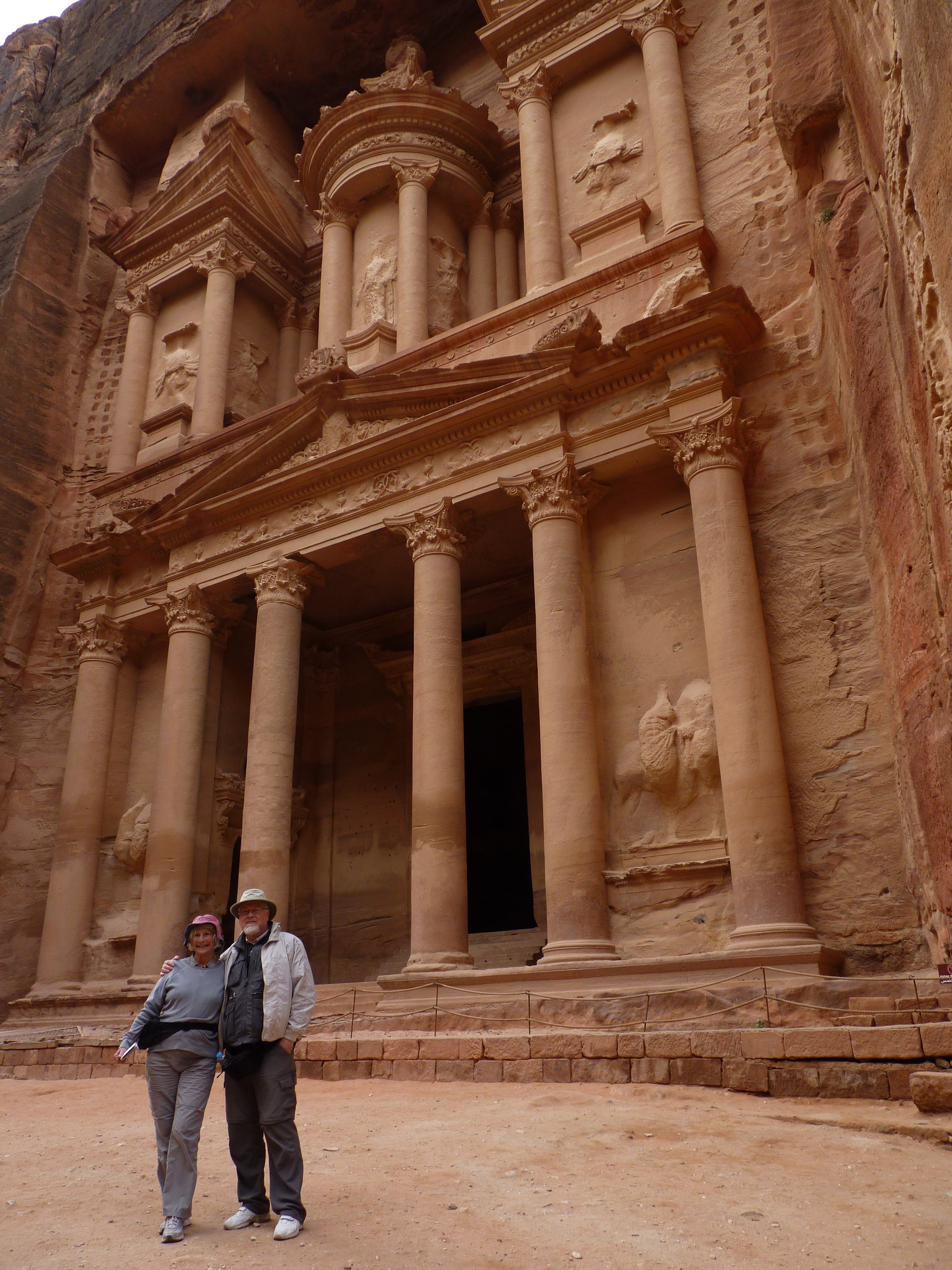
In every way this was a wonderful trip and a tremendous learning experience to walk where Jesus walked and where many Old Testament events took place.
Sweden, Denmark, Shetland Islands, Iceland, Northern Ireland, England: In the Wake of the Vikings
May 28-June 15, 2014
For two weeks Diane and I went on a Baltic and North Sea cruise called “Ice” with the Semester at Sea program. We arrived by air to Stockholm where we were hosted by our dear friend Karin Sharma. From there we cruised to Copenhagen, then to Lerwick in the Shetland Islands (Scotland), on to three ports in Iceland (Reykjavic, Isafjordur, and Akureyri), then to Belfast, and ending up in Southampton, England. We were gone 19 days on this wonderful educational cruise that Diane won in a lottery with OLLI (Osher Lifelong Learning Institute) at FSU. The scenery in the Shetland Islands and Iceland was fabulous, and the lectures on board were educational and very enjoyable. Of course, we ate too much.
I refer to this particular cruise as “In the Wake of the Vikings” because of its emphasis on Viking history and lore. All of my grandparents were born Jutland, Denmark, and I have often thought, albeit with tongue in cheek, that I might have Viking roots. As an anti war pacifist from Minnesota, I was happy to learn that in the Shetland Islands many Vikings were peaceful farmers, as were my ancestors. So, who knows?
One of my ethnomusicology colleagues and a friend for over 40 years, Dr. Ted Solis, also took the cruise (neither of us knew we were going to be on the same cruise), and we had a great time, talking about past explorations of the Semester at Sea and remembering our many friends who had been on the faculty over the years (Max Brandt, Phil Sonnichsen, and others). The Semester at Sea ship for this cruise is new (the MV Explorer), which Ted explained is much better than the old ships used by the Semester at Sea back in the 1970s, 80s, and 90s. There is no longer a gamelan on board (nor are there any musical instruments of any type today, except for a piano), but the library and computer facilities are good. Along with us 800 adults were several hundred students who were getting credit for courses.
 Here is a photo of Diane and me sitting on a cliff by the Eshaness lighthouse in the northern Shetland Islands, overlooking the North Sea.
Here is a photo of Diane and me sitting on a cliff by the Eshaness lighthouse in the northern Shetland Islands, overlooking the North Sea.
Below is a photo of us next to the the Goðafoss (“waterfall of the gods”), one of the most beautiful waterfalls in Iceland, near the northern town of Akureyri. 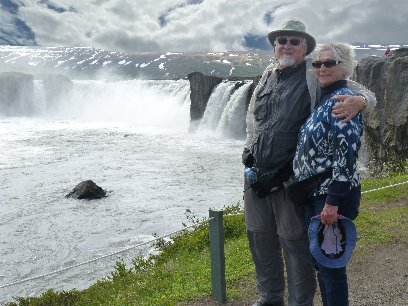 Godafoss translates as “Waterfall of the Gods.” It derives its name from the following legend: In the year 999 or 1000 Thorgeir, chieftain, lawspeaker, and heathen priest of Ljosavatn district, was entrusted with the momentous task of settling the growing disputes between Christians and those who worshipped the old Nordic gods by deciding whether Icelanders should adopt the Christian faith or not. When his decision was formally accepted that they would convert to Christianity, he left Althingi and went to his home on the Skjálfandafljót river by the waterfall where he threw all of his statues of the Viking pagan gods into the waterfall. Hence, the name Godafoss or “Waterfall of the Gods.”
Godafoss translates as “Waterfall of the Gods.” It derives its name from the following legend: In the year 999 or 1000 Thorgeir, chieftain, lawspeaker, and heathen priest of Ljosavatn district, was entrusted with the momentous task of settling the growing disputes between Christians and those who worshipped the old Nordic gods by deciding whether Icelanders should adopt the Christian faith or not. When his decision was formally accepted that they would convert to Christianity, he left Althingi and went to his home on the Skjálfandafljót river by the waterfall where he threw all of his statues of the Viking pagan gods into the waterfall. Hence, the name Godafoss or “Waterfall of the Gods.”
Norway: from Bergen to Kierkenes and back (fjords, islands, and northern ports of call); onward to Amsterdam
August 29-September 18, 2014
Diane and I, along with 14 of our Tallahassee friends, took a 12 day round-trip voyage on a Hurtigruten cruiseship/ferry/mailboat from Bergen to Kirkenes (the most northern town in Europe) and back, cruising in the estuaries and fjords of Norway. This was another cruise that had a Viking emphasis because many of the places we visited were former Viking settlements.
Diane and I ended our 20 day European adventure by spending four nights in Amsterdam where we rented a houseboat on a canal, complete with a traditional windmill just a few feet from the dock. It was so nice to have swans swimming by our window every morning.
Travels in 2014-2015
From Chile across the Pacific to Robinson Crusoe Island, Easter Island, Pitcairn Island, and French Polynesia: A Southern Pacific Adventure
December 16, 2014-January 5, 2015
Over Christmas 2014 and New Years 2015 Diane and went on a South Pacific cruise with Oceania cruise line. We flew to Santiago, took a bus to Valparaiso, and embarked from that Chilean cruise port. It had been 46 years since we had been in Chile, and I was very hungry for my favorite Chilean food, empanada de horno (baked empanada, like a folded meat pie made with hamburger, olives, sliced boiled egg, raisins, and onions). We used to eat empanadas every Sunday after attending our little church in the Nunoa region of Santiago where we lived–there was a wonderful small bakery between our residence and the church, all within a several block walk. The first thing I did when we arrived in the cruise port in Valparaiso was to buy an empanada de horno and a Chilean beer. I cried when I ate it because it brought back decades-old memories.
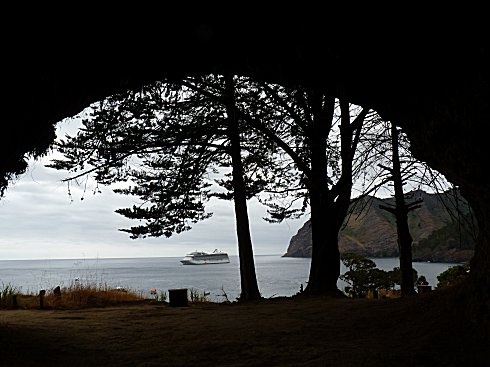 Our first stop in our south Pacific cruise were the Juan Fernandez Islands (administered by Chile), and specifically Robinson Crusoe Island, the main island, named after Defoe’s novel about the marooned sailor, Alexander Selkirk, in the18th century. This island has a very interesting history, rich with episodes about prisoners, castaways, battles, hurricanes, tidal waves, and more. It is also the home of a number of flora and fauna that are endemic to the region, including a beautiful hummingbird that is much larger than North American hummingbirds; and, they are not afraid of humans. The Juan Fernandez Islands are mountainous and heavily forested. Always in search of more empanadas, on Robinson Crusoe Island I ate my first squid empanada. I vowed that it would be my last!
Our first stop in our south Pacific cruise were the Juan Fernandez Islands (administered by Chile), and specifically Robinson Crusoe Island, the main island, named after Defoe’s novel about the marooned sailor, Alexander Selkirk, in the18th century. This island has a very interesting history, rich with episodes about prisoners, castaways, battles, hurricanes, tidal waves, and more. It is also the home of a number of flora and fauna that are endemic to the region, including a beautiful hummingbird that is much larger than North American hummingbirds; and, they are not afraid of humans. The Juan Fernandez Islands are mountainous and heavily forested. Always in search of more empanadas, on Robinson Crusoe Island I ate my first squid empanada. I vowed that it would be my last!
After four more days at sea we arrived at Easter Island where we spent two nights, which gave us ample time to visit most of the archaeological sites featuring numerous moai, the enigmatic and colossal stone heads with torsos.  Because this particular cruise began in Chile, there were many Chilenos on board, and we rented a small van with three Chilean passengers and a knowledgeable Polynesian driver who spoke fluent Spanish (Easter Island also belongs to Chile). These photos are of a large moai quarry on the side of a mountain where there are numerous erect statues and many more lying down on their backs. There are others in various stages of being chiseled from their rocky places of origin.
Because this particular cruise began in Chile, there were many Chilenos on board, and we rented a small van with three Chilean passengers and a knowledgeable Polynesian driver who spoke fluent Spanish (Easter Island also belongs to Chile). These photos are of a large moai quarry on the side of a mountain where there are numerous erect statues and many more lying down on their backs. There are others in various stages of being chiseled from their rocky places of origin. 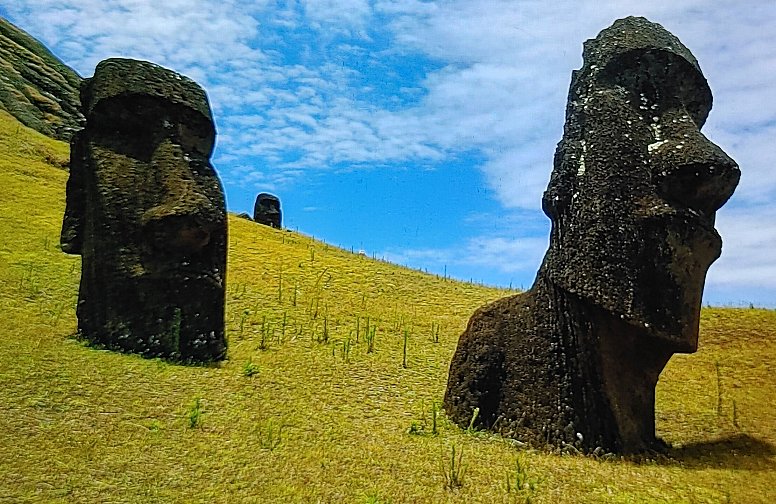
As you can see from this photo, Easter Island is extremely barren. Most of its trees have been cut down and probably used for fuel and construction over the millennia. The mythology of Easter Island is very interesting, and I remember reading Thor Heyerdale’s book about Easter Island when I was young, which was not only about his preparations for his journey on his Kon Tiki raft, but also about crawling through lava vents and much more. Today, the music of Easter Island, after centuries of Chilean dominance, is an interesting mixture of Polynesian and Chilean characteristics. In spite of so much Chilean influence, the Polynesian Easter Islanders still maintain many of their beliefs, some of which are syncretically mixed with Roman Catholicism.
After two more days at sea we arrived to Pitcairn Island, which also has an enigmatic history, although it is not archaeological, but sociological. The famous novel Caine Mutiny is based derived from the history of Pitcairn Island. Unfortunately, the Pacific Ocean was too rough for us to go ashore; instead, many citizens of the Island, including the mayor, came to visit us on our cruise ship, bringing many items to sell. It wasn’t the same as making a landing, but it was fun to personally interact with the islanders.
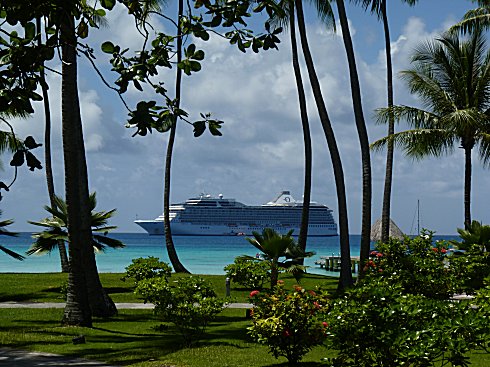
Two more days at sea took us to four islands in French Polynesia: Fakarava, Rangirora, Bora Bora, and the capital, Tahiti. Fakarava and Rangirora are very large and completely flat atolls, with calm water on the atoll sides and heavy waves on the ocean sides. These two islands were easy to explore because the areas with tourist access are quite small. There are small stores, eating places, beaches for swimming, snorkel and dive shops, small homes and churches, and so forth.
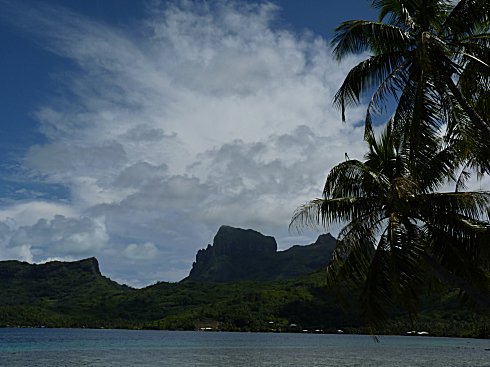
Bora Bora, on the other hand, is a very mountainous atoll that owes it origin to an extinct volcano that sank, creating a beautiful and large caldera. It is also the most developed, aside from Tahiti, the capital and the largest island in French Polynesia. Bora Bora is the home of the rich and the famous, beautiful resorts for tourists, and many rustic and quaint houses for the locals. It has a local bus system, local guides with their transportation, and many roads that circumnavigate the island. Bora Bora is a photographer’s dreamland. 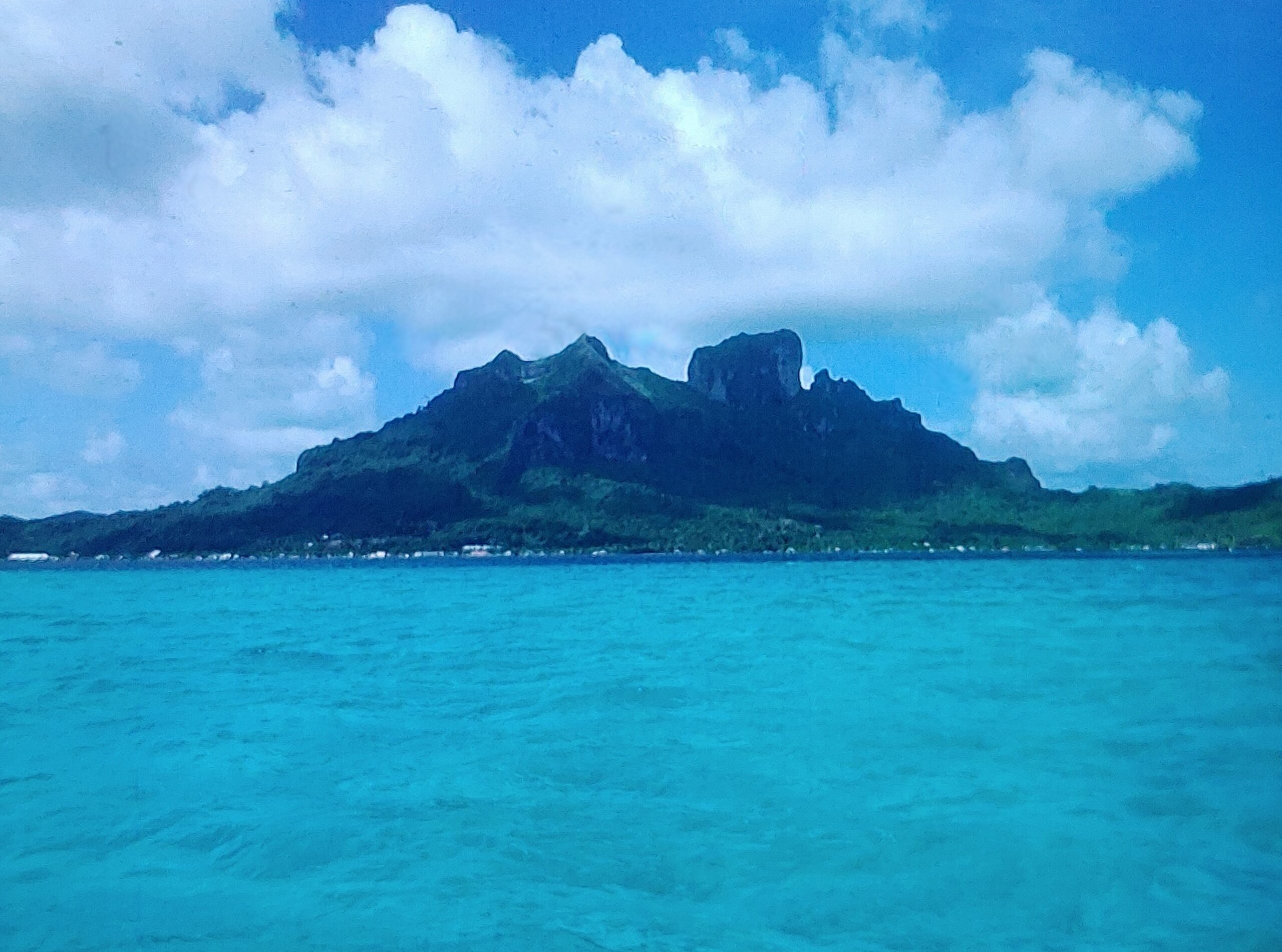
We flew back to Tallahassee from Papeete, the capital of French Polynesia in Tahiti, very early in the morning after disembarking our cruise ship. Thus, we did not see much of Tahiti at all, although it would have been possible to pay more money for a two-day extension.
This South Pacific cruise was one of our favorites for many reasons. It was our first Oceania Cruise Line voyage, which is one of the main reasons it was so enjoyable: elegant accommodations, fabulous food, numerous educational lectures by noted scholars, great entertainment. The ports-of-call and all of the multicultural learning experiences were, of course, the unforgettable highlights of the cruise. But, I think the most memorable aspect for us were two interdenominational Christmas services organized and led by Christian passengers, in which Diane and I participated as a flute/piano duo, along with the beautiful and touching singing by Lawrence, one of the lead singers in an entertainment troupe that performed music and dance many evenings. The three of us performed Christmas hymns for Christmas Eve and Christmas Day services, and those experiences of devotion and love were memorable for us. Lawrence, Diane, and I praised Jesus together through music, and we will never forget it.
Travels in 2015
Slovakian Heritage Tour and Vienna, Austria
September 9-28, 2015
Slovakia. Diane and I flew to Vienna, Austria, where we joined a two-week tour of Slovakia with other tourists of Slovakian heritage like Diane (both her grandparents on her dad’s side were born in Slovakia), of Polish descent, or like me, just someone interested in our beautiful world. We toured many parts of Slovakia, taking cable cars into the high Tatra Mountains, visiting castles, attending festivals and musical events, rafting on a river, eating wonderful Slovakian food, and much more, and making new friends.
We love mountains, most likely because we grew up in flat Minnesota. Whenever we can, we like to visit parts of the world that have high mountains, a love that began when we lived in Chile. We did not know about the Tatra mountains in Slovakia, which are high, rugged, and unspoiled by tourism. On our tour we took several cable car and ski lift rides to several parts of the Tatras, and even in July it was cold and very windy. From the tops of the peaks, or between the peaks where the cable car went, we were told we could see Poland to the north–I hadn’t thought about that, because I, at least, wasn’t thinking geo-politically, just geologically. Such jagged peaks, I thought; and in the winter they must be even more majestic and beautiful. It’s interesting to me to think about how people separated themselves politically because of mountain ranges. It’s logical, of course. More interesting to me is to wonder how the got around, transporting goods, engaging in wars, farming, and so on, with such rugged territory. Diane’s heritage is from the Carpathian Mountains further east, closer to Ukraine.
We also love castles! and Slovakia has many of them that are off the beaten tourist track, but are accessible. Oravsky Hrad (Orava Castle), located in the north-central part of Slovakia, is one of the best known (both of these photographs are of the same castle). Orava Castle was built in the13th century when the entire region of present-day Slovakia 
was a part of the Hungarian Empire. It has burned down and been rebuilt several times, so that the present structure has little to do with the architecture of the medieval castle. Orava Castle has been featured in movies about Transylvania, even though it is located in Slovakia and not Romania.
One of the musical highlights for me was having the opportunity to play music with Slovakia’s most famous fujara player, Mr. Dusan Holik. The fujara is a very long overtone fipple flute with three finger holes, which means that all of the notes used in a musical piece are produced by overblowing. The fingerholes make four overtone series available, and the combinations make it possible for a good player to produce almost all the notes of a chromatic scale, although it is meaningless to make that kind of analogy, as if the chromatic scale is the ultimate in music. Sorry!  The instrument has a unique length because the more upper overtones you play, the more length is required. It is so long that the shorter secondary tube is the head joint into which the flutist blows, forcing his breath into the attached longer primary tube that has the fingerholes and the fipple or notch (sometimes called the window) that produces the sound. This musical occasion was a dinner for our group at a nice restaurant featuring traditional Slovakian cuisine. Maestro Dusan provided the entertainment–at least most of it, because after several songs I took out my flute (which also has a fipple mouthpiece like a recorder) and asked Dusak if he would allow me to improvise with him. He was very agreeable, and after our several pieces we both were all smiles, the universal language because he did not speak English and I do not speak Slovakian. Click here to watch a short video of one of our improvisations:
The instrument has a unique length because the more upper overtones you play, the more length is required. It is so long that the shorter secondary tube is the head joint into which the flutist blows, forcing his breath into the attached longer primary tube that has the fingerholes and the fipple or notch (sometimes called the window) that produces the sound. This musical occasion was a dinner for our group at a nice restaurant featuring traditional Slovakian cuisine. Maestro Dusan provided the entertainment–at least most of it, because after several songs I took out my flute (which also has a fipple mouthpiece like a recorder) and asked Dusak if he would allow me to improvise with him. He was very agreeable, and after our several pieces we both were all smiles, the universal language because he did not speak English and I do not speak Slovakian. Click here to watch a short video of one of our improvisations:
https://m.facebook.com/story.php?story_fbid=10207692815626860&id=1577384698
Here is a photo of that memorable performance, which I will always treasure because maestro Dusak unfortunately passed away several years after our Slovakian journey.
One day we arranged to visit Diane’s second cousins in Habura, whom we had never met. Their daughter, Martina, who is our son’s third cousin, was our interpreter. We had met Martina several decades ago when she visited St. Paul, Minnesota, and lived with Diane’s parents for a whilel.  Diane’s aunt Mary Ann and sister Barbara had visited the entire family in Habura several years earlier. Like long lost relatives, we were treated extremely well when we arrived. We had a great time visiting Diane’s ancestral family homesteads, grave sites of Diane’s ancestors, the Andy Warhol Museum, looking at pictures of other family members, eating traditional food, and just getting to know more of Diane’s Slovakian relatives (this photo was taken in front of the Andy Warhol Museum in Medzilaborce; from right to left are Mikiel–Diane’s 3rd cousin, Diane, Maria–Makiel’s wife, Martina–Mikiel and Maria’s daughter, and I).
Diane’s aunt Mary Ann and sister Barbara had visited the entire family in Habura several years earlier. Like long lost relatives, we were treated extremely well when we arrived. We had a great time visiting Diane’s ancestral family homesteads, grave sites of Diane’s ancestors, the Andy Warhol Museum, looking at pictures of other family members, eating traditional food, and just getting to know more of Diane’s Slovakian relatives (this photo was taken in front of the Andy Warhol Museum in Medzilaborce; from right to left are Mikiel–Diane’s 3rd cousin, Diane, Maria–Makiel’s wife, Martina–Mikiel and Maria’s daughter, and I).
Vienna, Austria. After Slovakia we took a ferry on the Danube River from Bratislava to Vienna, where we rented an apartment for a week in the museum quarter. We had great fun attending many concerts, visiting museums, seeing a show of the Spanish Riding School in the Hofburg Palace, and much more. Our apartment was easy walking distance from some of the main Viennese cultural attractions.
There were so many highlights during our week in Vienna, and certainly one of the most memorable was attending a show of the Spanish Riding School because it was my birthday present to Diane, who has been crazy about horses  since she was a child. In fact, she believed she was a horse when she was an adolescent. In this photo one of the magnificent Lipizanner horses with its stately horseman are performing classical dressage. It is difficult for me to relate in words the splendor of the setting for this majestic Spanish Riding School performance in the beautifully ornate Winter Riding School (built 1729-1735) in the Hofburg Palace of Vienna. We had front row, middle balcony seats that I booked months in advance of our visit. Pricey? Yes, but well worth it–a “once-in-a-lifetime” experience, and I’m not crazy about horses. But, this was perfection, like the musical traditions that have come from Vienna over the centuries–Mozart, Beethoven, Brahms, Mahler, and more.
since she was a child. In fact, she believed she was a horse when she was an adolescent. In this photo one of the magnificent Lipizanner horses with its stately horseman are performing classical dressage. It is difficult for me to relate in words the splendor of the setting for this majestic Spanish Riding School performance in the beautifully ornate Winter Riding School (built 1729-1735) in the Hofburg Palace of Vienna. We had front row, middle balcony seats that I booked months in advance of our visit. Pricey? Yes, but well worth it–a “once-in-a-lifetime” experience, and I’m not crazy about horses. But, this was perfection, like the musical traditions that have come from Vienna over the centuries–Mozart, Beethoven, Brahms, Mahler, and more.
The Caribbean From Boston to Puerto Rico, Bonaire, Curacao, Aruba, Jamaica, Cayman Islands, Cozumel, and New Orleans
October 29-November 14, 2015
For seventeen days we cruised the Caribbean on Norwegian Cruise Lines. It was a “re-positioning” of a ship from Boston to New Orleans, by way of the Caribbean. We had never visited five of the islands on the itinerary, so we got the opportunity to add several more countries to our travel list. This cruise was a part of our extended 50th wedding anniversary celebration, and we traveled with Mary and David Stevenson (our friends who were married on the same day and year as we — June 26, 1965), dear friends Louise Rill and Walt Cory, and many other acquaintances from the Westminster Oaks Retirement Community in Tallahassee (where Mary, David, Walt, and other friends live).
After two wonderful nights and one beautiful day touring and enjoying Boston, we cruised for three days to San Juan, Puerto Rico where we spent one day and night. Our next ports of call were Bonaire, Curacao, Aruba Jamaica, Caiman Islands, and Cozumel, Mexico, with several sea days here and there.
This was the third time we had visited Puerto Rico. The first time we lived in Rio Piedras for several weeks in the summer of 1966 as part of our Peace Corps language training.
Travels in 2016
Trinidad and Tobago: SEMSEC Conference and vacation
dates, 2016
A conference of SEMSEC (Southeast/Caribbean Chapter of the Society for Ethnomusicology), and an invitation to be a discussant on a session, gave us the opportunity to travel by air to Trinidad in March 2-11, 2016. We spent three days in San Fernando in the southwestern-central part of the island of Trinidad, where the conference was held. It was wonderful to see many of my former ethnomusicology students and numerous old friends (and make new friends, as well). We had not been to Trinidad since 1969 when we attended carnival after our three years in the Peace Corps in Chile.
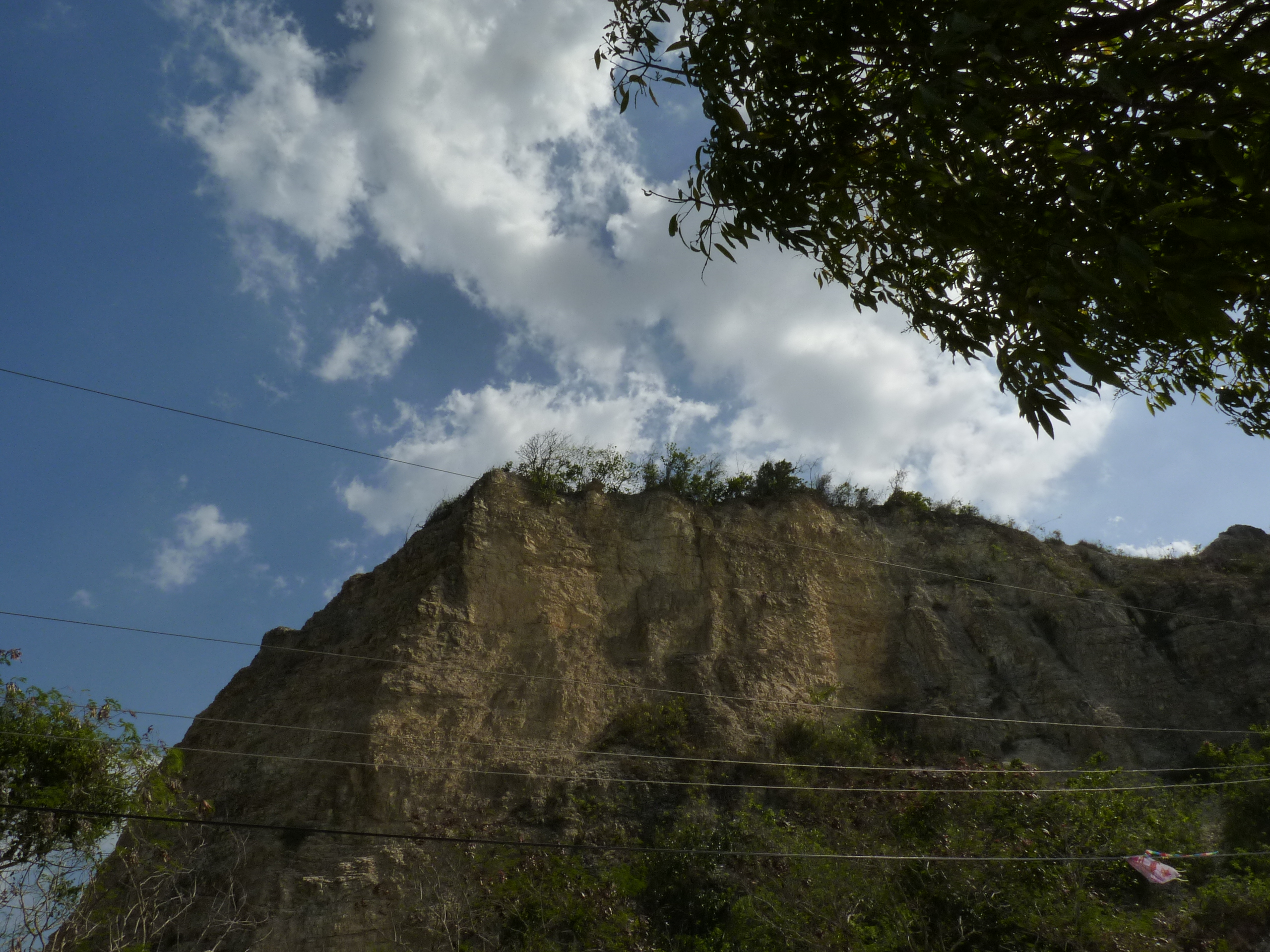 One of the highlights was climbing Nabarima Hill (aka San Fernando Hill), which is a peak that is considered by the Warao Indians (a culture in Venezuela where I did my dissertation research — please link to “Ethnomusicology as Advocacy” from the main page or just below Travels) to be the northernmost sacred mountain in their cosmology — it is a very sacred place for them. While in San Fernando I had hoped to meet some of the Warao descendants that live in that region, but I was not able to make personal contacts. I left a copy of my book and CD for them with a Trinidadian scholar I met at the conference, but I never heard if the Warao descendants ever received my gift.
One of the highlights was climbing Nabarima Hill (aka San Fernando Hill), which is a peak that is considered by the Warao Indians (a culture in Venezuela where I did my dissertation research — please link to “Ethnomusicology as Advocacy” from the main page or just below Travels) to be the northernmost sacred mountain in their cosmology — it is a very sacred place for them. While in San Fernando I had hoped to meet some of the Warao descendants that live in that region, but I was not able to make personal contacts. I left a copy of my book and CD for them with a Trinidadian scholar I met at the conference, but I never heard if the Warao descendants ever received my gift.
Then we traveled in our rental car to Port of Spain where we stayed for another four nights at the very comfortable Heritage Inn. From there we drove to and along the North Coast until the road ended. The beaches and mountains in the north of the island of Trinidad are spectacular. Especially impressive are Maracas Bay, Las Cuevas, and other beautiful beach locations.
One day we drove south to the Caroni Bird Sanctuary on the western coast, where every dusk thousands of scarlet ibis  (the national bird of Trinidad) fly to particular islands in a large lake to roost. The boat tour in the Caroni Swamp was the highlight of our entire trip to Trinidad.
(the national bird of Trinidad) fly to particular islands in a large lake to roost. The boat tour in the Caroni Swamp was the highlight of our entire trip to Trinidad. 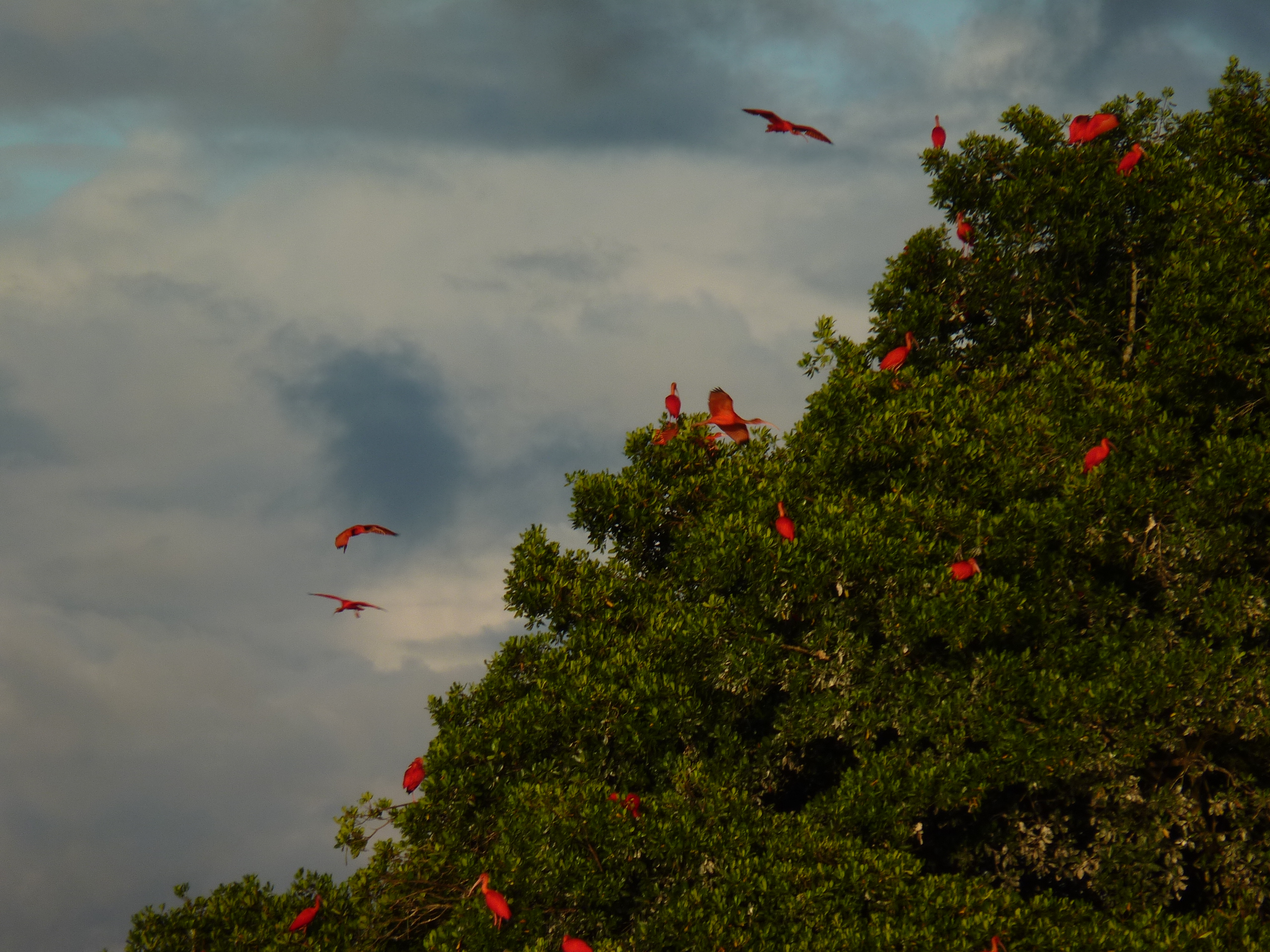
We also visited several Hindu temples on the west coast of Trinidad. While I did not enjoy driving on the left side of the roads, we survived and had a nice time. We heard excellent East Indian tassa drumming, a great steelband, and a good East Indian popular music group. We enjoyed the food, especially bake ‘n’ shark, one of the local specialties.
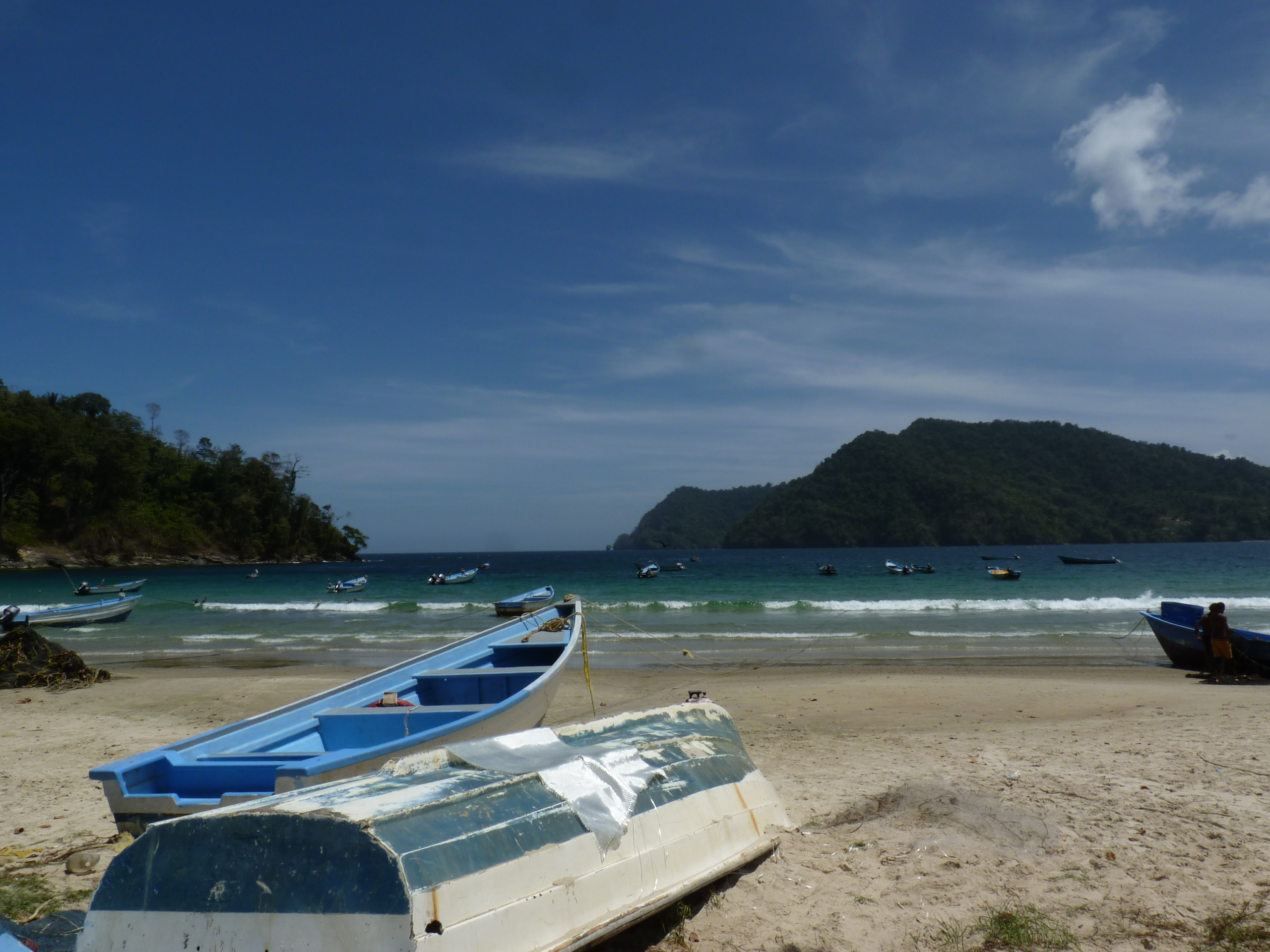 Some of the most beautiful scenery in Trinidad is along the mountainous northern coast, northeast of Port of Spain. A beautiful bay known as Las Cuevas (The Caves) is one of our favorite spots. We were also at this very beach back in 1969 on our way home after living in Chile for nearly three years. At that time there were no settlements in the area, just beautiful sand, endless tropical trees, the Caribbean Sea, and mountains. It is still that way, except it is now a fishing village, which also has great charm.
Some of the most beautiful scenery in Trinidad is along the mountainous northern coast, northeast of Port of Spain. A beautiful bay known as Las Cuevas (The Caves) is one of our favorite spots. We were also at this very beach back in 1969 on our way home after living in Chile for nearly three years. At that time there were no settlements in the area, just beautiful sand, endless tropical trees, the Caribbean Sea, and mountains. It is still that way, except it is now a fishing village, which also has great charm.
Eastern Caribbean Cruise: Port Canaveral, FL; Coco Cay, Bahamas; St. Thomas, U.S. Virgin Islands; St. Maarten; Port Canaveral
September 18-25, 2016
This cruise was with Louise Rill and Walter Cory, aboard the Royal Caribbean ship “Freedom of the Seas.” It was also to celebrate Diane’s 74th birthday.
Southern Cone of South America Vacation: 3 days in Buenos Aires, Argentina, followed by a 14-Day South America Passage Cruise (from Buenos Aires to Uruguay, Falkland Islands, Tierra del Fuego, around Cape Horn, through Chilean Fiords, Lake District, disembarquing in Valparaiso, Chile), and ending with 8 days in Santiago.
December 6-20, 2016
Although we lived in Chile for close to three years back in the ’60s, we never had the time to explore the southern third of the country between Puerto Mont and Punta Arenas, except for Torres de Paine (see 1966-68 Travel Tale and Snapshot above). The southern third of Chile is the fiord and estuary region, laden with amazing mountains and glaciers reached only by water.
In December, 2016, we found the perfect cruise on Holland America for visiting that region. It was a thrilling experience to visit Ushuaia and the Tierra del Fuego National Park in Argentina again after 50 years (we were first there in 1967 for Christmas and New Year’s). Several of these photos were taken 50 years apart, so you can see many changes.

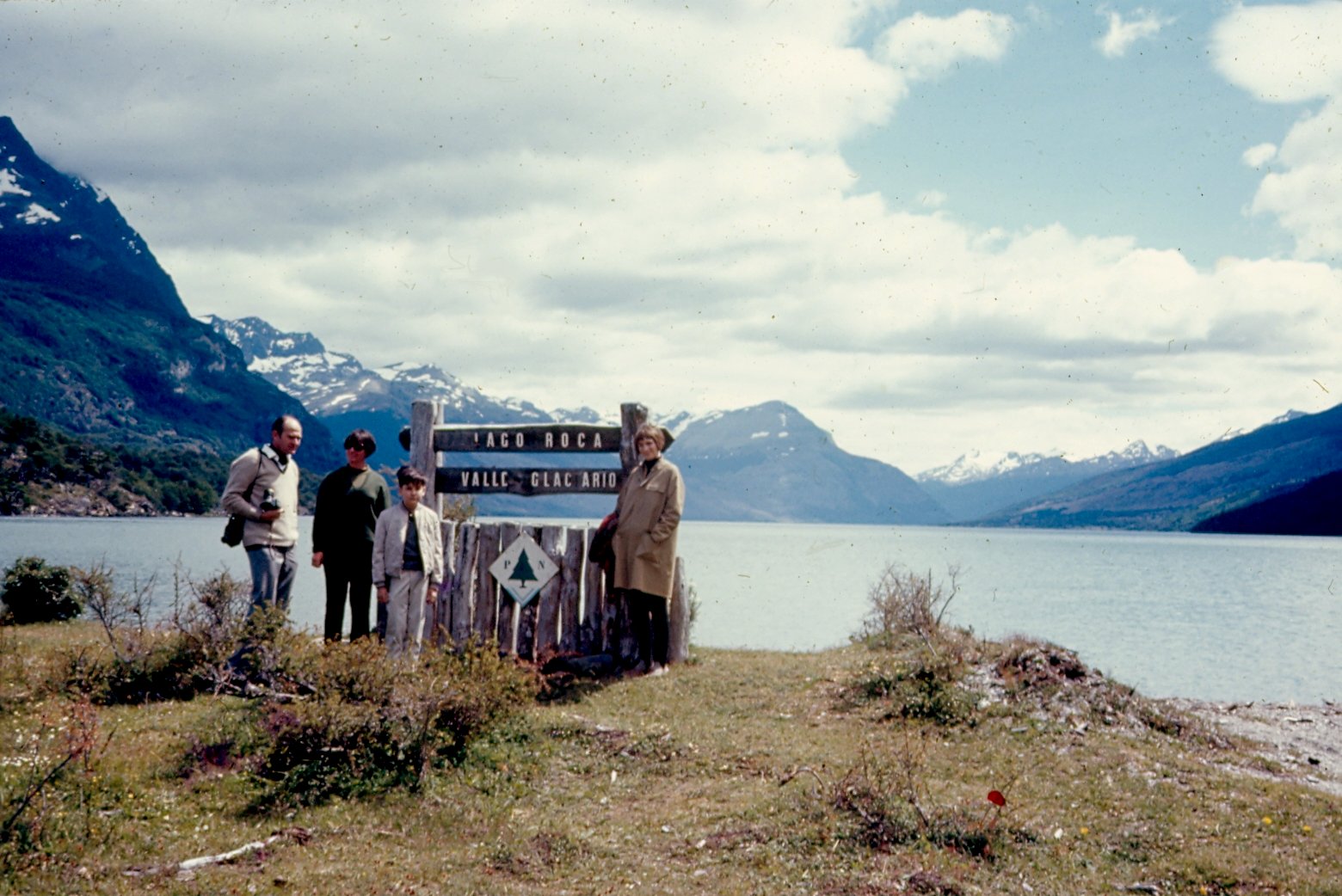
 The cruise ship passed around Cape Horn, which was as calm as on a summer day in the Gulf of Mexico — it can often be so rough that cruise ships will not traverse the area. Then we slowly cruised through the Beagle Canal and the many estuaries of Tierra del Fuego, seeing some of the most beautiful mountains and glaciers in the world. Sadly, many of the glaciers are rapidly receding.
The cruise ship passed around Cape Horn, which was as calm as on a summer day in the Gulf of Mexico — it can often be so rough that cruise ships will not traverse the area. Then we slowly cruised through the Beagle Canal and the many estuaries of Tierra del Fuego, seeing some of the most beautiful mountains and glaciers in the world. Sadly, many of the glaciers are rapidly receding.
After reaching Puerto Mont in the south of central Chile, in the lake district, Diane took a horseback riding excursion in the wilderness of that beautiful region. I am not a horseback rider, but I talked my way into going along free, just to accompany her and spend the day visiting with the Chilean campesinos and making use of my Spanish. It was a very nice day.
When we finally reached Valparaiso, Chile, we spent a day with Chilean friends that we met on our Easter Island trip in 2015, and then took a bus to Santiago and stayed two weeks, visiting old musician friends from the 1960s and celebrating Christmas with our dear friend and UCLA colleague, Dr. Luis Merino. It was so nice to be with him and his family at their country retreat in the coastal mountains. It was a wonderful reunion. We also spent many days walking around Santiago, trying to locate old haunts from the ’60s and exploring new areas. Santiago has certainly changed!
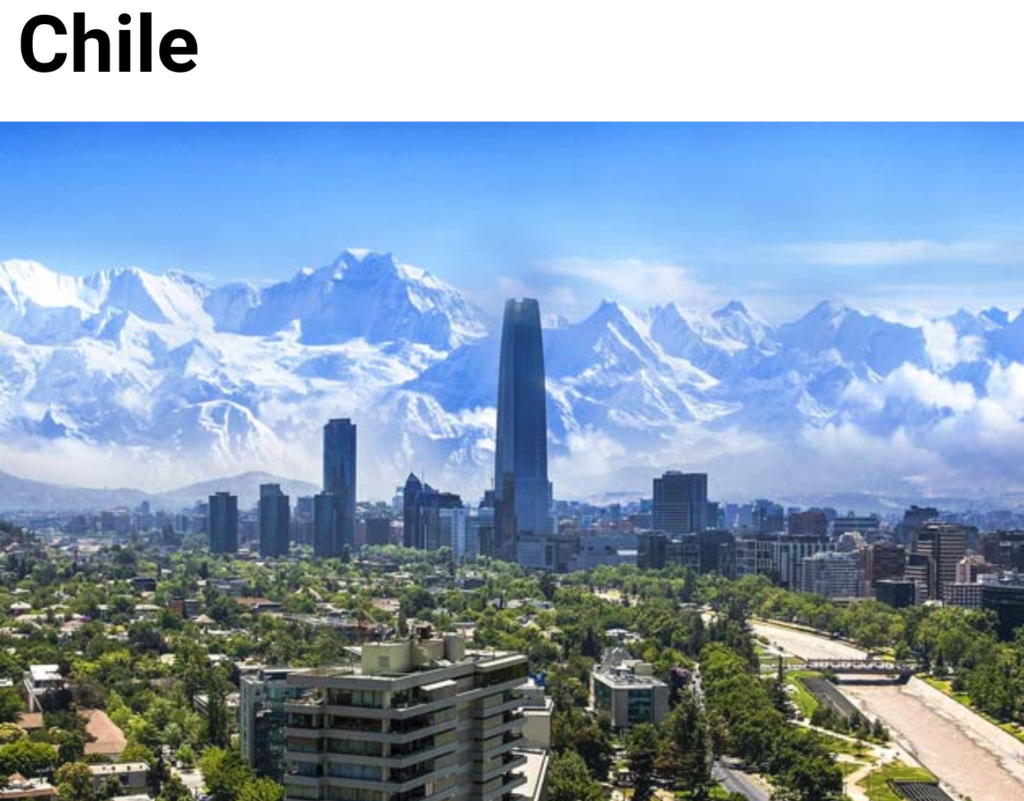
Travels in 2017
Eastern Mediterranean Cruise: Italy, Greece, and Malta
October 19-November 3, 2017
In the fall Diane and I flew to Rome, Italy, took a train to Civitavecchia, the cruise port, then in a few days we embarked on the cruise ship to Greece and back, with ports of call in Crete, Rhodes, Athens, Mykonos, and Santorini in Greece; Malta; and Sicily (Taormina, and Mt. Etna), Pompeii, Naples, and Rome in Italy.
While in Civitavecchia (lit., old port town) we visited Tarquinia, a medieval Italian hill town and former Etruscan burial ground — now a major archaeological site. We first visited Tarquinia in 1985 when we were living in Florence, but at that time most of the Etruscan tombs were not open for tourism; today it is possible to visit almost all of them, which we did. Because of their wall paintings, the tombs are important sources for the study of Etruscan musical instruments.
Although we lived in Florence, Italy for 6 months in 1985, we had never been south of Rome. Therefore, visiting Sicily and Pompeii were new experiences, and spending a day in Rome after our cruise was a chance to see some recent archaeological sites and revisit others (picture 9). The real highlights of the trip, however, were the Greek ports of call: Crete, Rhodes, Mykonos, Santorini, and Athens. We also visited Malta, especially enjoyed the architecture, such as the old windmills in Mykonos (picture 10) and the white-washed houses and chapels on the mountaintops in Santorini (picture 11)—from the cruise ship the white buildings look like snow on the mountains. Pompeii was also very interesting, and we often thought how much Diane’s Dad (a former Latin teacher) would have enjoyed seeing all the ancient Greek and Roman architecture in Greece and Italy.
In the fall Diane and I flew to Rome, Italy and took a cruise to Greece and back. We visited Civitavecchia (old port town) and Tarquinia (former Etruscan town) in Italy; Crete, Rhodes, Athens, Mykonos, and Santorini in Greece; Malta; and Sicily (Taormina, and Mt. Etna), Pompeii, Naples, and Rome in Italy. Although we lived in Florence, Italy for 6 months in 1985, we had never been south of Rome. Therefore, visiting Sicily and Pompeii were new experiences, and spending a day in Rome was a chance to see some recent archaeological sites and revisit others (picture 9). The real highlights of the trip, however, were the Greek islands of Mykonos and Santorini. We especially enjoyed the architecture, such as the old windmills in Mykonos (see photo)  and the white-washed houses and chapels on the mountaintops in Santorini (see photo)–from the cruise ship the white buildings look like snow on the mountains.
and the white-washed houses and chapels on the mountaintops in Santorini (see photo)–from the cruise ship the white buildings look like snow on the mountains. 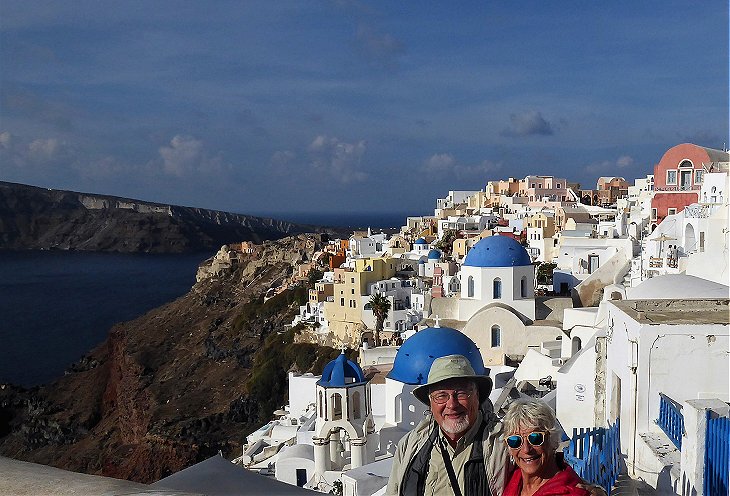 Pompeii was also very interesting, and we often thought how much Diane’s Dad (a former Latin teacher) would have enjoyed seeing all the ancient Greek and Roman architecture in Greece and Italy.
Pompeii was also very interesting, and we often thought how much Diane’s Dad (a former Latin teacher) would have enjoyed seeing all the ancient Greek and Roman architecture in Greece and Italy.
Travels in 2018
The Caribbean: St. Maarten, St. Lucia, Barbados, Martinique, St. Kitts & Nevis, St. Thomas, The Bahamas
March 7-18, 2018
We toured parts of the Caribbean again in March, 2018, cruising on Holland America Line with several friends from Tallahassee. Although we had visited St. Maarten, St. Lucia, and Martinique back in 1977, we always realize there are new things to learn, and 40 years is a long time for many changes to take place. Also, we had never been to the other islands included in this cruise. The itinerary included three days at sea and the following ports of call from Fort Lauderdale, Florida: Philipsburg, Sint Maarten; Castries, Saint Lucia; Bridgetown, Barbados; Fort-de-France, Martinique; Basseterre, Saint Kitts; St. Thomas, U.S. Virgin Islands; and Half Moon Cay, Bahamas.
We particularly enjoy Holland American cruises because they feature excellent entertainment every day and night. Especially enjoyable is the Lincoln Center Stage, which usually features a professional string quartet or piano quintet consisting of young professional musicians from Julliard and other institutes or schools of music. They routinely perform chamber music by Mozart, Beethoven, Brahms, and other great composers, as well as other compositions that have public appeal.
 One of the highlights of the ports of call included St. Lucia, which we had visited on our own back in 1977 for several days, spending our time in Soufrier and the southern part of the island. This time we had an excellent guide from the capital, Castries, who drove us to the Gran Piton peaks, as seen in this photograph from the cruise ship. The guide’s explanations of the history and culture of the northern part of the island were very informative.
One of the highlights of the ports of call included St. Lucia, which we had visited on our own back in 1977 for several days, spending our time in Soufrier and the southern part of the island. This time we had an excellent guide from the capital, Castries, who drove us to the Gran Piton peaks, as seen in this photograph from the cruise ship. The guide’s explanations of the history and culture of the northern part of the island were very informative.
Things were a lot different 40 years ago, when we also spent several days in Martinique, which is today a French state. Back then we rented a car and explored most of the island, including driving and hiking to the top of the Mt. Pele crater. This time we spent all day in the capital, Fort de France, which was the cruise ship’s port of call. We enjoyed the museums, parks, and French ice cream.
Denmark, Norway, Germany, Estonia, Russia, Finland, and Sweden (followed by a week in Copenhagen): A Baltic Adventure
August 27-September 15, 2018
In August we went on a cruise of the Baltic Sea, from the western end to St. Petersburg at the easternmost end. Beginning in Copenhagen, the cruise ship headed northwest to Oslo, where we met up with two Tallahassee friends who were spending their summer in Norway. From there we spent a day in northern Germany, then on to Tallinn, Estonia, for a day. The old town section of Tallinn is a wonderful region to visit, with its many high church spires, medieval walls, and other intriguing sites. St. Petersburg was very interesting, with its numerous canals, churches, modern architecture near the sea (see photo of the Lakhta Center),  and its fabulous museums and palaces. On the return we spent a day in Helsinki, which I had visited in 1985 during an ICTM conference. The next stop was Stockholm, where we strolled around, trying to see sites we had not visited when we were there in 1985 and again in 2014.
and its fabulous museums and palaces. On the return we spent a day in Helsinki, which I had visited in 1985 during an ICTM conference. The next stop was Stockholm, where we strolled around, trying to see sites we had not visited when we were there in 1985 and again in 2014.
Travels in 2019
The Western Mediterranean: Spain, Morocco, Canary Islands, and Madeira (followed by a week in Barcelona).
January 11-28, 2019
Croatia and Montenegro: “The Best of Croatia: A Coastal Voyage by Yacht”
April 25-May 10, 2019
For seventeen days we traveled on a Road Scholar Tour with our friend Louise Rill to, from, and within the vicinity of the Adriatic coast of Croatia and Montenegro, mostly aboard Futura (Photo 3), a beautiful motor yacht from Split, Croatia.  We began our trip with a long flight from Tallahassee, to Atlanta, to Munich, to Split, leaving Tallahassee shortly after 12:00 noon on a Thursday and arriving in Split around noon on Friday. After napping, walking around the Old Town region of Split, eating, and sleeping soundly to help rid us of jet lag, we hooked up with our pre-booked Saturday day trip excursion to Krka National Park (photo), several hours northeast of Split.
We began our trip with a long flight from Tallahassee, to Atlanta, to Munich, to Split, leaving Tallahassee shortly after 12:00 noon on a Thursday and arriving in Split around noon on Friday. After napping, walking around the Old Town region of Split, eating, and sleeping soundly to help rid us of jet lag, we hooked up with our pre-booked Saturday day trip excursion to Krka National Park (photo), several hours northeast of Split.
The Krka National Park tour included the three of us, a young French couple, and the Croatian tour guide (driver of the small van) and his partner. Both of the Croatian young men spoke perfect English and were wonderful guides. The day included a boat ride on Skradin Lake, visiting restored stone houses and watermills. The highlight of the trip was visiting Skradinski Buk, the largest travertine waterfall in Europe (Photo 1),  and hiking above the falls in boardwalks and other trails. Another highlight of the nearly 8-hour trip was a stop at a small homestead to sample local home-made spirits (Photo 2).
and hiking above the falls in boardwalks and other trails. Another highlight of the nearly 8-hour trip was a stop at a small homestead to sample local home-made spirits (Photo 2).

After our initial two days and nights in Split on our own, we spent the next three nights and four days on our Road 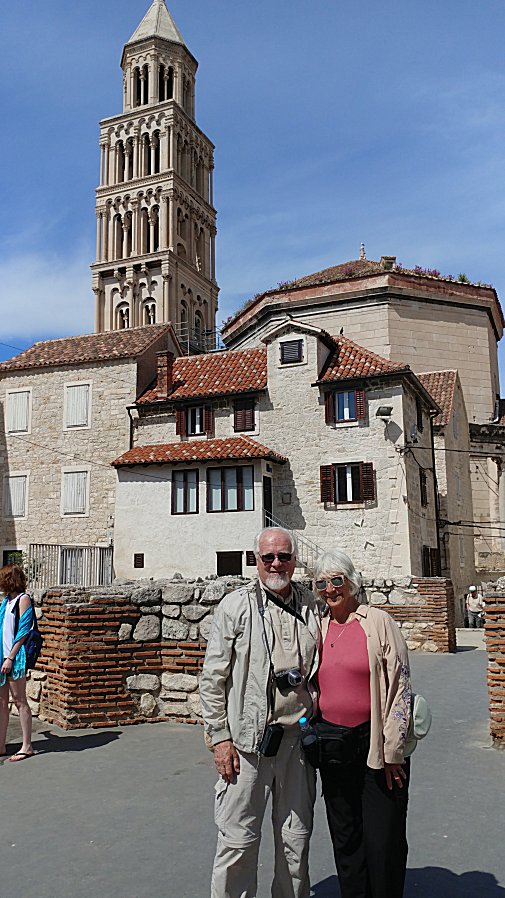 Scholar adventure by living in the Cornaro Hotel in Split where we met and interacted with the other several dozen participants, attended several lectures, ate breakfasts, lunches, and dinners, and participated in guided walking tours of Split and neighboring areas.
Scholar adventure by living in the Cornaro Hotel in Split where we met and interacted with the other several dozen participants, attended several lectures, ate breakfasts, lunches, and dinners, and participated in guided walking tours of Split and neighboring areas. 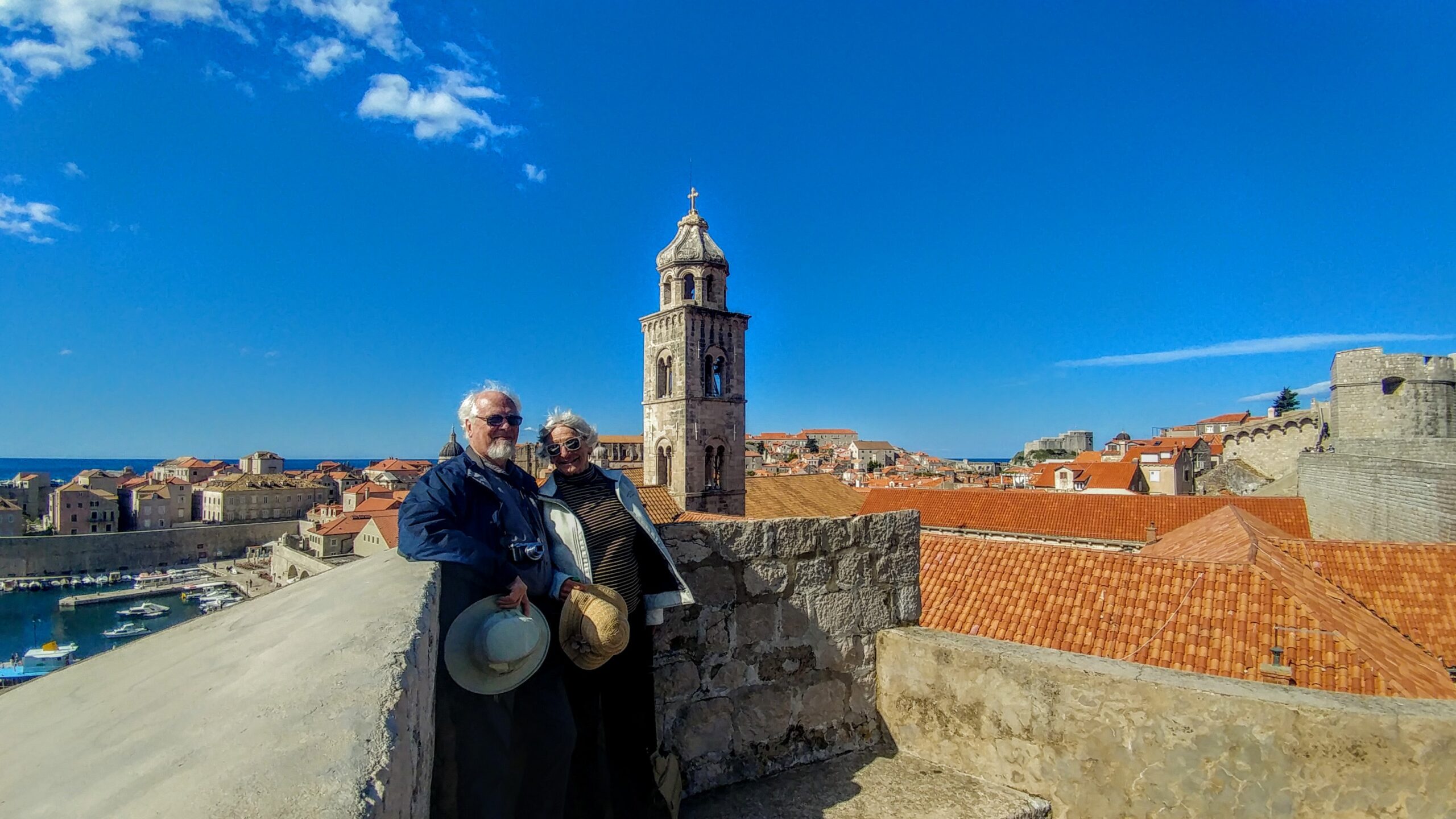 On afternoon four of the official tour we embarked and settled into our long-awaited yacht, known as “Futura” (Photo 3).
On afternoon four of the official tour we embarked and settled into our long-awaited yacht, known as “Futura” (Photo 3).
On day five we cruised on the Adriatic Sea to Trogir, an ancient town on Tragurion, called the “island of Goats,” a UNESCO World Heritage site. On day six we cruised to the Island of Hvar and Stari Grad, which we explored on foot. This quaint village and port has its roots in Greek antiquity. We visited a Dominican Monastery and Museum (see photo of Diane playing a grand piano beneath a painting of the Last Supper). That evening included a live musical performance of Klap singing aboard the ship (see photo). On day seven we continued our tour of Hvar Town, which was the center of Adriatic civilization and trade for thousands of years. We also visited St. Stephen’s Cathedral, a Franciscan monastery. On day eight we cruised to Korcula Island and town, and explored the medieval old town, including St. Mark’s Cathedral and Town Museum. On day nine we cruised to Mljet National Park on the western portion of Jljet Island, the most important protected area of southern Dalmatia. We motored by small boat on a lake to the islet of St. Mary to visit a 12th century Benedictine monastery and the Church of St. Mary.
On day ten we cruised to Dubrovnik where we had a lecture by a university professor, took a motor coach tour of the city, visited a Franciscan monastery and the Rector’s Palace.  That evening we had our “Futura” farewell dinner, and we were were entertained by a Croatian folk/pop/jazz trio. I had my flute along, of course, and I jammed with them on several tunes, including “The Girl from Ipanema,” who lived a long way from Dubrovnik (see photo). On day eleven we said farewell to our beautiful yacht and proceeded to the Old Town of Dubrovnik. We took a cable car to Mount Srd and later a motor coach to Herceg Novi in Montenegro, arriving in the town of Igalo, where we had beautiful lodging on Palmon Bay.
That evening we had our “Futura” farewell dinner, and we were were entertained by a Croatian folk/pop/jazz trio. I had my flute along, of course, and I jammed with them on several tunes, including “The Girl from Ipanema,” who lived a long way from Dubrovnik (see photo). On day eleven we said farewell to our beautiful yacht and proceeded to the Old Town of Dubrovnik. We took a cable car to Mount Srd and later a motor coach to Herceg Novi in Montenegro, arriving in the town of Igalo, where we had beautiful lodging on Palmon Bay. 
On day twelve we took a motor coach through Herceg Novi, explored small coastal towns in Montenegro, walked on tours of Renaissance and Baroque regions and palaces in Kotor’s Old Town. Kotor is another UNESCO World Heritage site, an old city founded by the Romans. Finally, on day thirteen, our program ended and we were bussed to the airport in Dubrovnik for our departure to Munich, Germany, where we spent the night. We arrived in Tallahassee about 5:00 PM the next day, tired but happy to be safely home again.
Crossing the northern Atlantic on the Queen Mary II to England (followed by a week in Salisbury, Stonehenge, and Bath)
July 28-August 11, 2019
Switzerland and the Rhine: A week in Interlaken, the Alps, and Basel; Rhine River cruise to Amsterdam
September 17-October 2, 2019
In September Diane and I flew to Basel, Switzerland, and then traveled by train to Interlaken where we spent a week prior to a scheduled Viking river cruise on the Rhine River. From our base in Unterseen in Interlocken West we stayed six nights in a charming Alpine Hotel called Post Hardermannli. We took day trips by trains, mountain lifts, funiculars, and cog trains to several Alpine peaks, mountain villages, and lakes in the Berner Oberland region, including the following: Jungfraujoch (“Top of Europe”), a beautiful ski area and snowy playground situated on the slopes of Jungfrau mountain (13,642′) between the peaks of Eiger (13,036″) and Monch (13,449″); Schilthorn (9,798;) and Piz Gloria, where the first James Bond movie was filmed; xxx valley and waterfalls; and Brienz and Thun Lakes. Most importantly, we celebrated Diane’s 77th birthday with a wonderful Asian fondo dinner in Interlaken East.
“Rhine Getaway.” We took a September 24-October 2 voyage on the “Eliner” Viking longboat from Basel to Amsterdam. This particular Viking river cruise was named “Rhine Getaway” and subtitled” Castles & Cathedrals” (both names are printed in the Viking brochure). The following paragraphs are organized by the eight days of the cruise, including the ports of call and points of interest:
Day 1 – Basel, Switzerland – We arrived to Basel by train from Interlaken a day before the cruise and spent an extra day there, visiting museums and other points of interest).
Day 2 – Breisach, Germany, with a tour of the Schwarzwald “Black Forest”;
Day 3 – Strasbourg, France, the largest port on the Upper Rhine;
Day 4 – Heidelberg, Germany, including Heidelberg Castle, medieval old town, Heidelberg University;
Day 5 – Titled “Middle Rhine scenic cruising of a UNESCO World Heritage Site,” 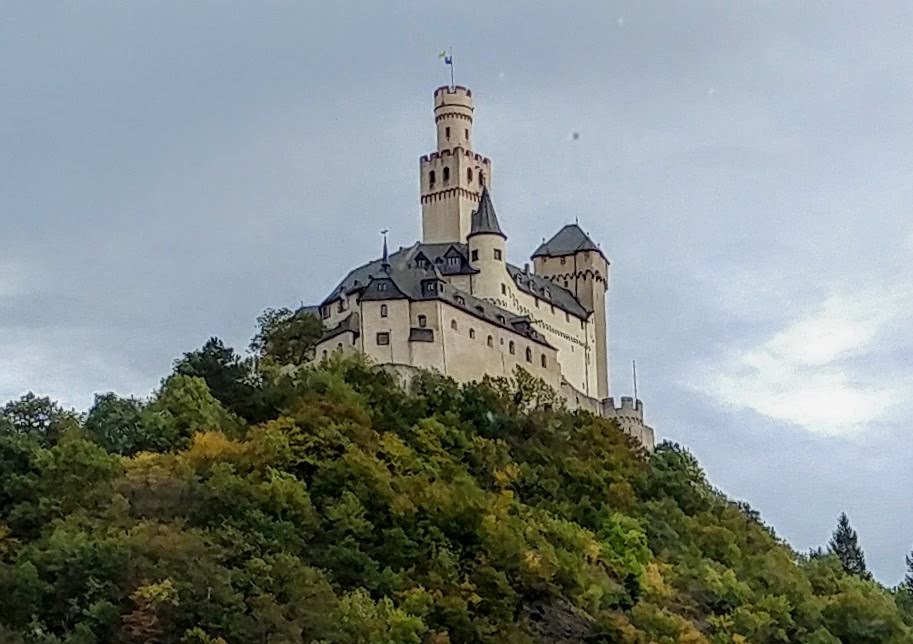 this day was the “heart” of the cruise – seeing a restored or ruined castle at just about every bend of the river. The Marksburg Castle (see photo) was the only castle that we were able to visit, and it was a wonderful experience. Other highlights included viewing the famous Lorelei Rock, one of the best known geographical piece of German folklore. The day also included visiting Koblenz, Germany, at the juncture of the Rhine and Moselle Rivers, including a tour of Marksburg Castle (see photo).
this day was the “heart” of the cruise – seeing a restored or ruined castle at just about every bend of the river. The Marksburg Castle (see photo) was the only castle that we were able to visit, and it was a wonderful experience. Other highlights included viewing the famous Lorelei Rock, one of the best known geographical piece of German folklore. The day also included visiting Koblenz, Germany, at the juncture of the Rhine and Moselle Rivers, including a tour of Marksburg Castle (see photo).
Day 6 – Cologne, Germany, touring the old city and the Cologne cathedral;
Day 7 – Lower Rhine cruising, including Waal and Merwede, The Netherlands, and a tour of Kinderdijk Windmills (see photo) 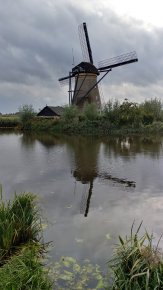 and Day 8-Amsterdam, The Netherlands, disembarking early and going by bus to the Amsterdam airport where we departed for JFK at 11:00 AM.
and Day 8-Amsterdam, The Netherlands, disembarking early and going by bus to the Amsterdam airport where we departed for JFK at 11:00 AM.
Travels in 2020
Western Mexico: San Diego to Puerto Vallata, Mazatlan, and Cabo San Lucas (followed by a week in southern California)
January, 2020
A
++++++++++++++++++++++
So many more places to visit –
so little time!



